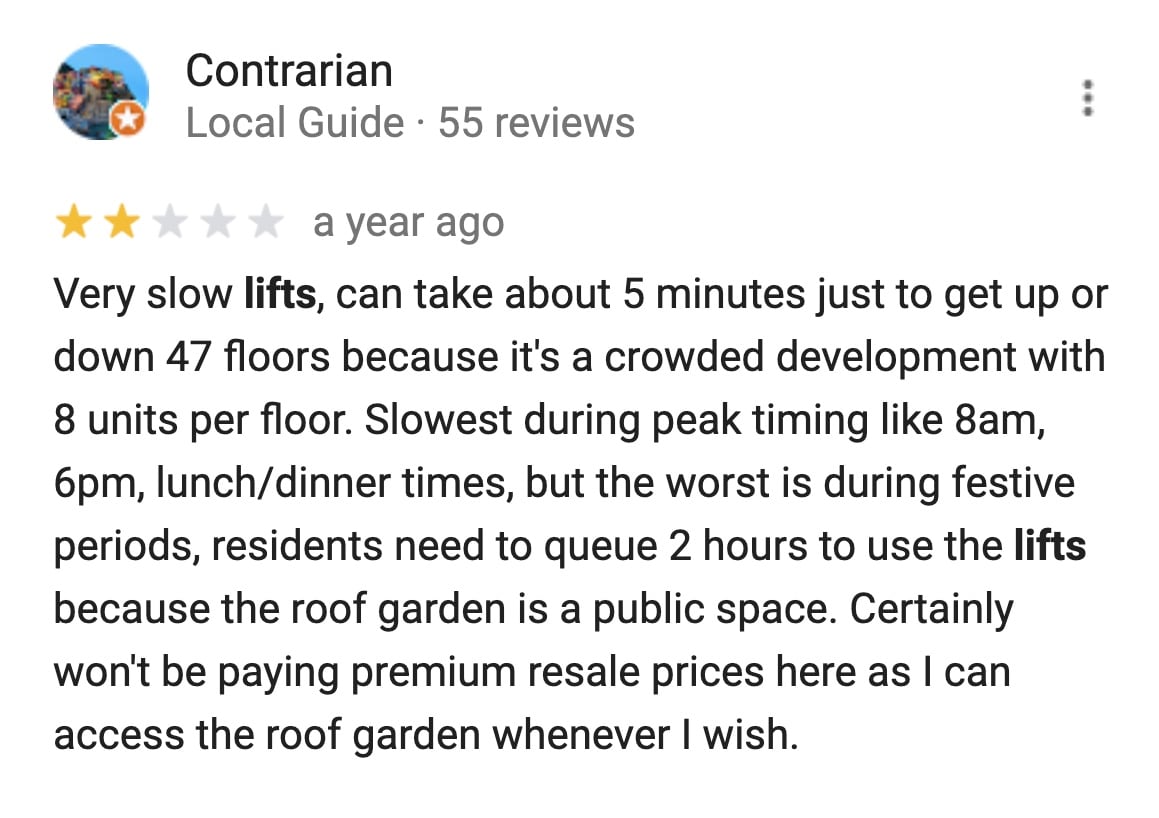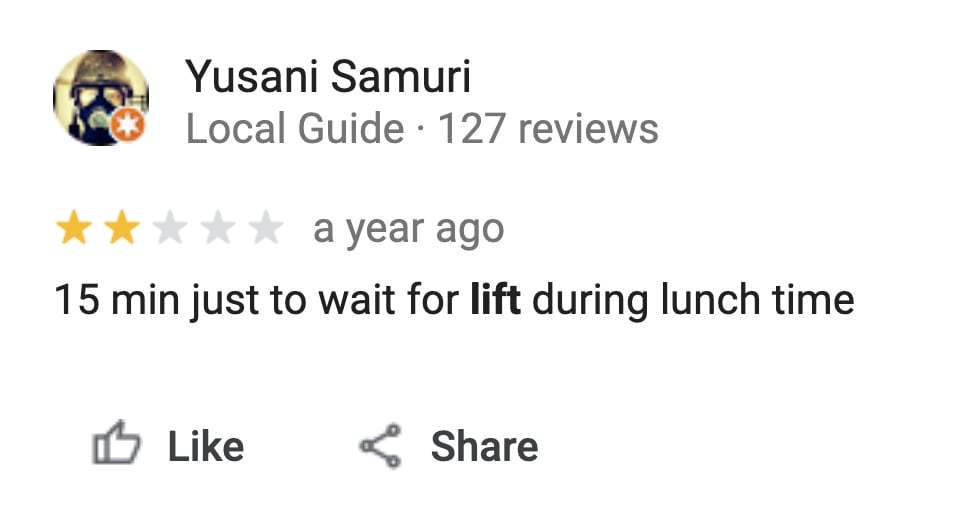What To Look Out For At A Resale HDB Viewing: A Step-By-Step Walkthrough (With Pictures)
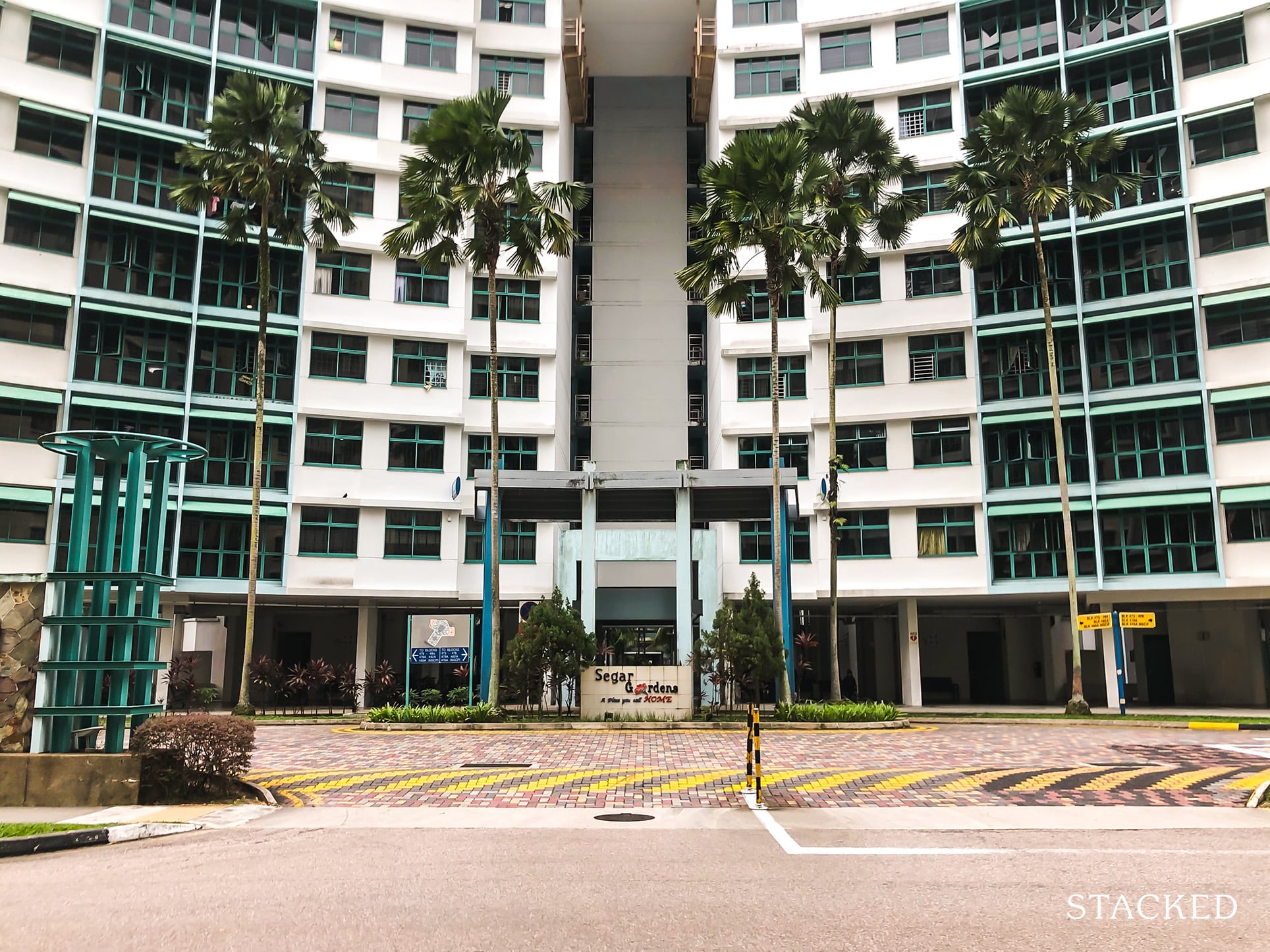
Get The Property Insights Serious Buyers Read First: Join 50,000+ readers who rely on our weekly breakdowns of Singapore’s property market.
I know the pains of the first-time HDB homebuyer in Singapore. It’s true that information on resale flats can be a bit scant, and a lot of it comes down to legwork.
But the bigger problem is really that you don’t know what you don’t know. Even if you’ve identified a location you want to stay in, what are the things to look out for?
There are small details that most inexperienced homebuyers would miss out on. For example, looking out for how many lifts per floor (would you have to wait long during peak hours?) or if you have adequate space right at your doorstep. What about neighbours, what are the pointers to look out for when you are at the viewing?
Remember, what may seem insignificant at the beginning may just add up over time to mar the whole experience for you.
So here’s something a bit different for you today.
I’ve a couple who are looking to buy a unit at Segar Road. As such, I’ll be documenting just how to go about the research and what to look out for as we tour and view the listing. It’s a step-by-step guide (along with a ton of photos) on how to do a reasonably in-depth check of their desired flat.
Here’s the location of the flat under scrutiny today:
Touring your potential home (A step-by-step guide)
Step 1: Use official HDB resources to check for transactions and eligibility
The three things to look for are:
- Recent transactions in the same block and area
- Remaining lease
- Ethnic Group Eligibility
Here’s an example, taken from HDB map services:
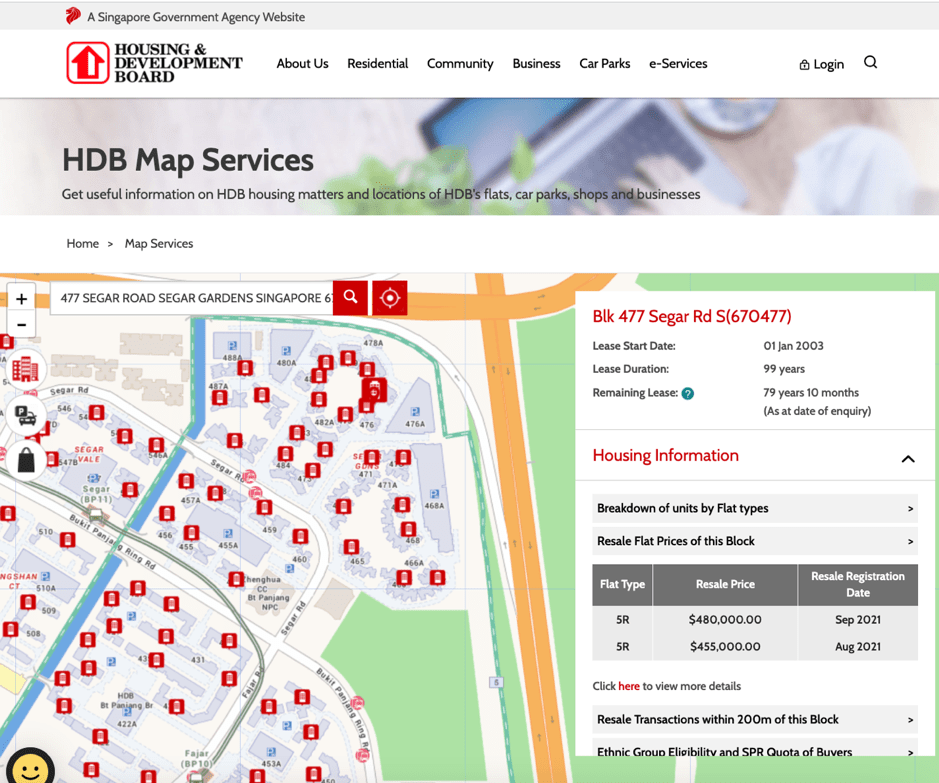
All three can be checked in the various sub-menus (under Housing Information).
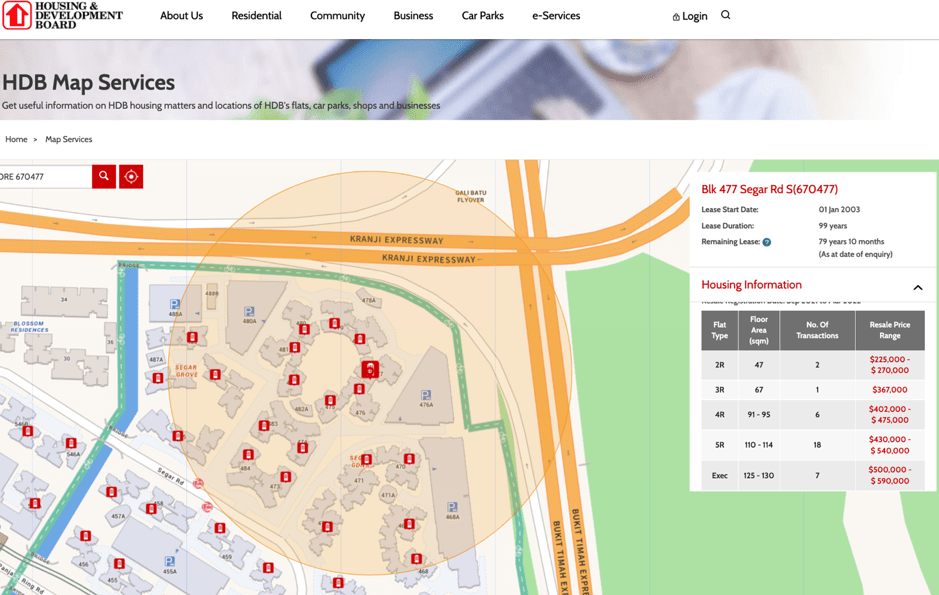
The Ethnic Group Quota is important, as you may not be eligible to buy if the quota is filled. You can see more details about the Ethnic Integration Policy here. Of course, this would depend on the seller too. For example, the Queenstown area is known to have a full Chinese quota, so as a Chinese, you won’t be able to buy from any other race but yours. The ethnic quota is based on the block, not the development as a whole so be sure to check for each and every block even though it is very highly correlated.
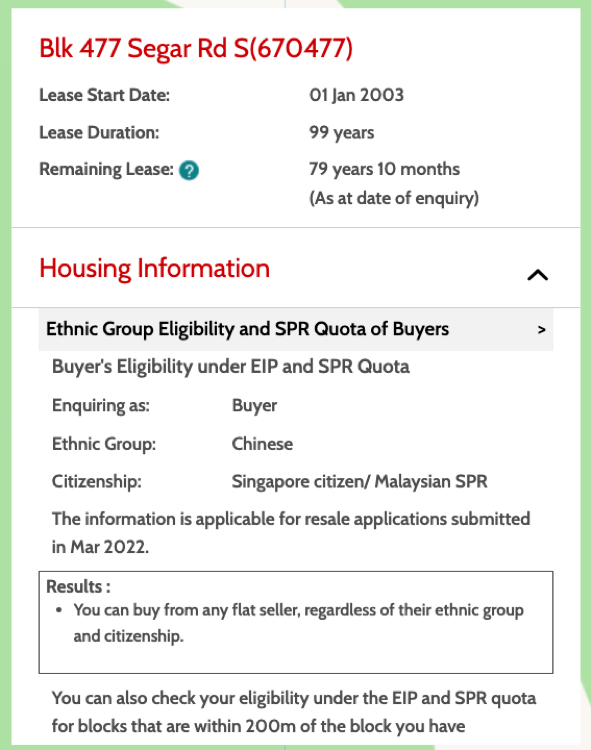
For buyers who have a double-barreled race on their NRIC, you usually use the first component (e.g., if your NRIC states Chinese – Indian, you count as Chinese for the ethnic quota). If this is to your disadvantage, consider contacting HDB and making an appeal.
Step 2: Check for schools located within the priority enrolment range
Schools give priority to children within one kilometre of the Home School Distance, during enrolment. The “official distance” can be found on One Map:
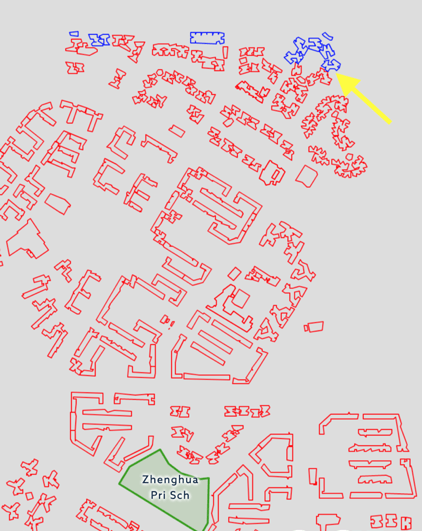
You can also refer to the official Ministry of Education site if you have the postal code. Note that some blocks within the same development may be within one kilometre, while others are not. There are cases where only a few blocks in the same development are actually within range.
In the above example, the blocks we’ve highlighted are just shy of the one-kilometre range to Zhenghua Primary School (nevertheless, it is located within range of three other Primary schools, namely, West Spring Primary, Greenridge Primary and Beacon Primary School.)
Most (but not all) HDB flats are within range of multiple schools, so it comes down to where you intend your child to be enrolled. There is also an investment component in this – even if you don’t have children, for example, future buyers may show a higher interest in blocks that are close to prestigious schools.
Do take note that even if you are within 1KM, it is still no guarantee of enrolment especially if it is a popular school.
Step 3: Investigate the surrounding neighbourhood
While you can do this with Google Street View, it’s best to go in person (it’s best to rely on Street View only if you’re already very familiar with the area, and just need a few reference images).
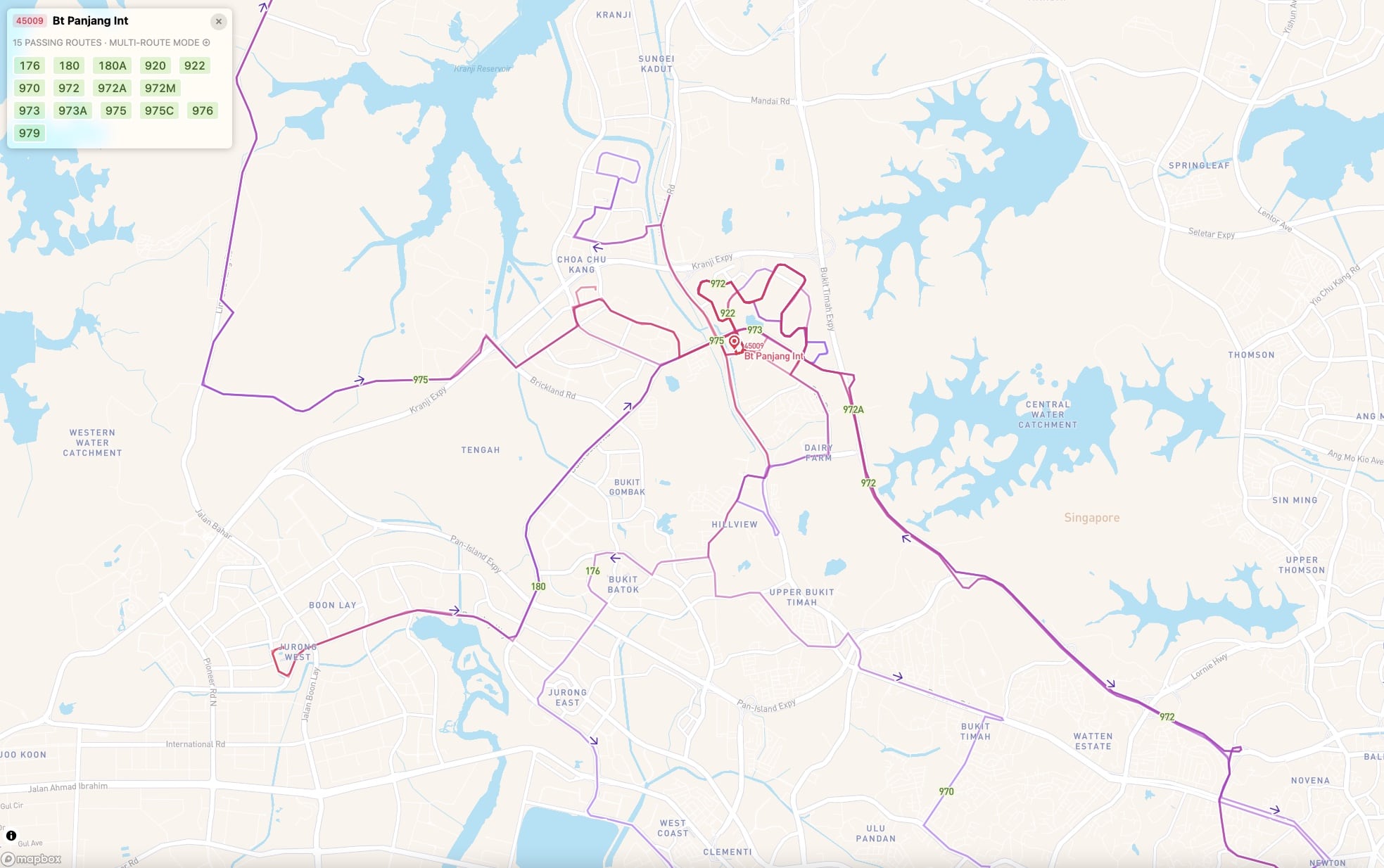
Take note of the available transportation options, such as the LRT, MRT, and nearby bus routes. Sometimes, the walking time shown online may not be accurate, as the “proper” route may not take into account certain shortcuts. I like to use busrouter.sg because it shows you the possible routes for the buses at any particular stop.
In fact, Google Maps often ignores routes that can be taken by parks or through other passageways that are not recognised as walking trails. For this, you could rely on a OneMap too as it comes with a navigation function. Here’s a look at what the walking trail is like from 466 Segar Road to Bukit Panjang MRT on OneMap:
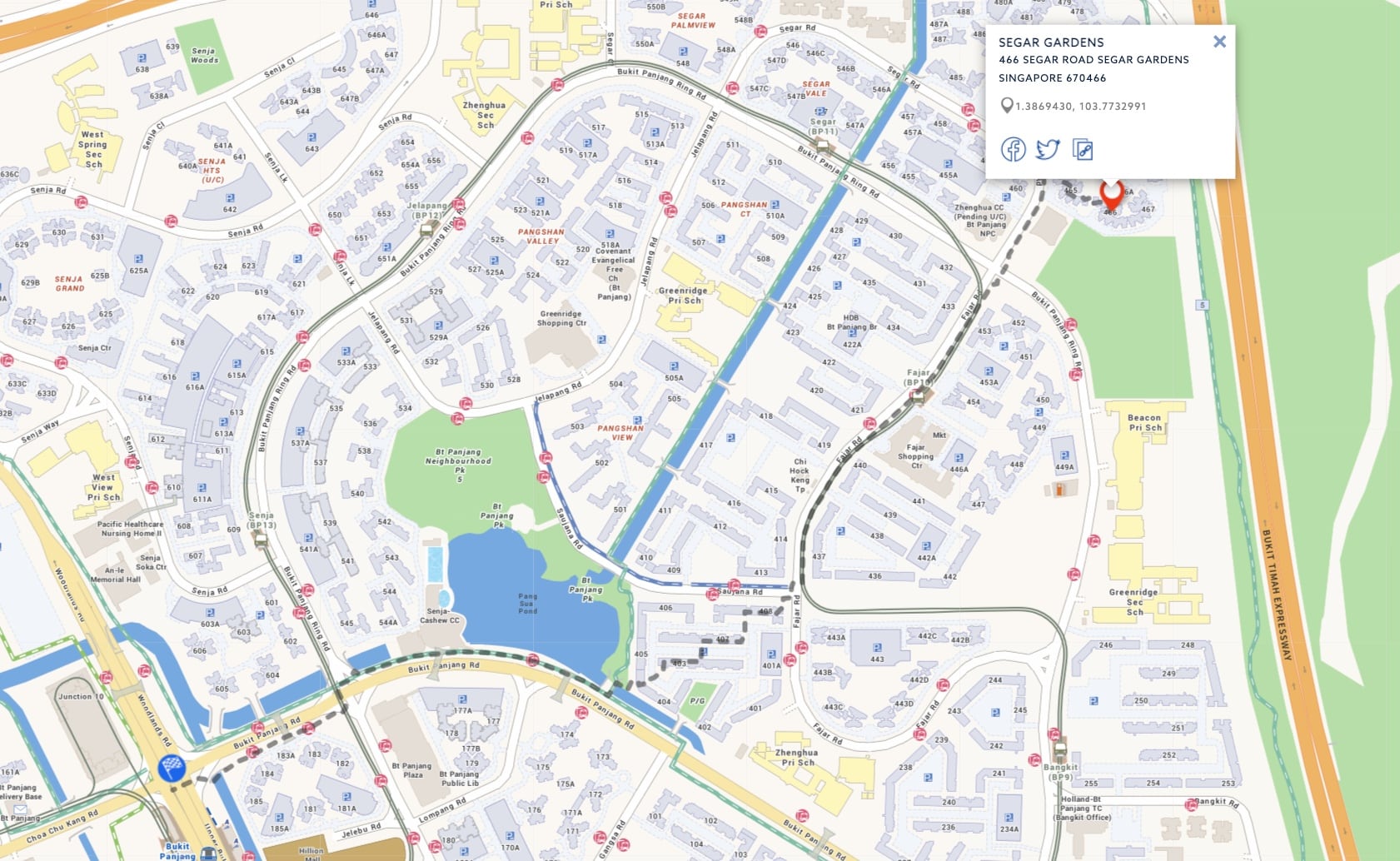
Notice how it cuts through the HDB on the east side of Pang Sua Pond? Now here’s what Google Maps shows you:
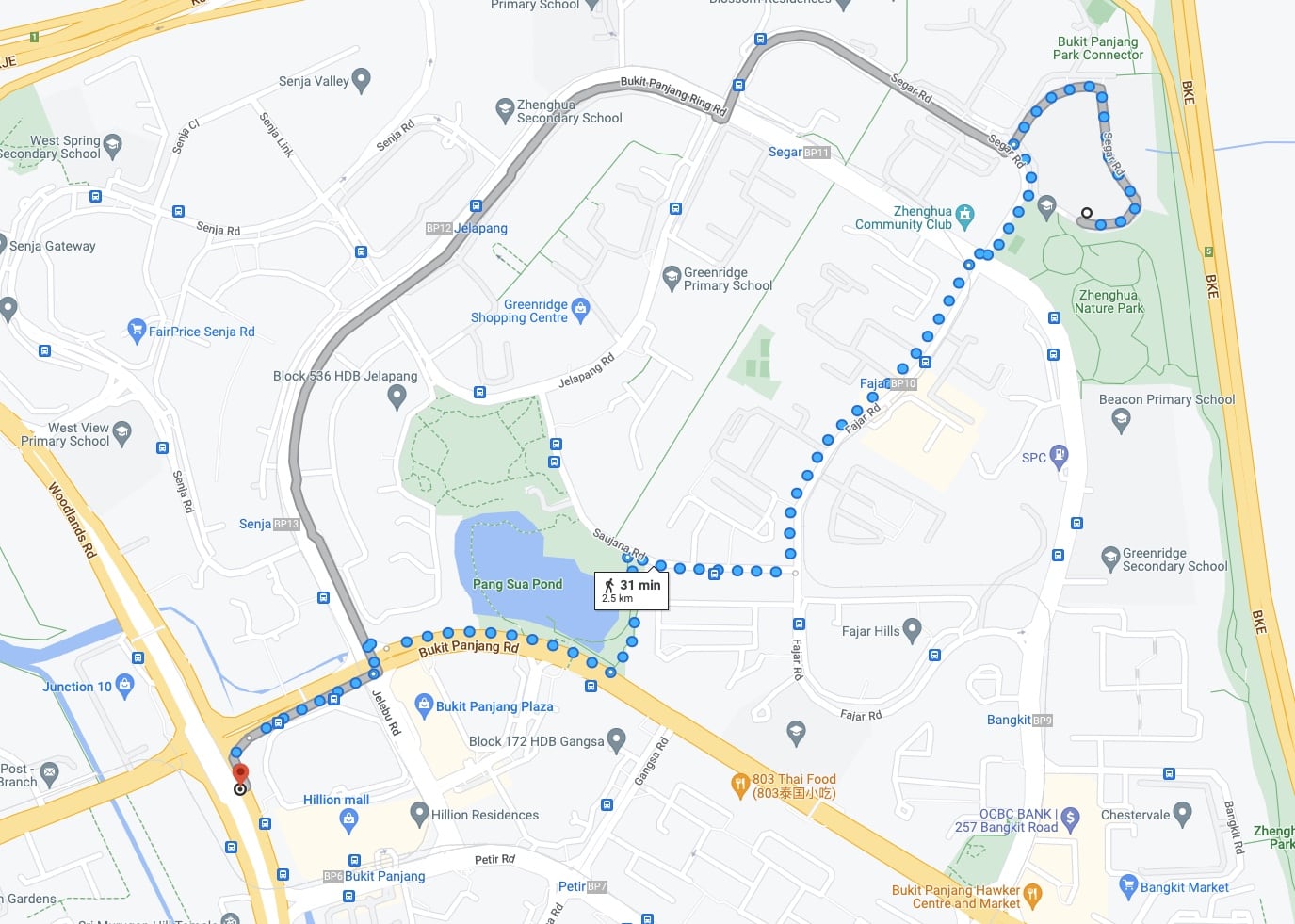
In this instance, Google maps didn’t even recognise the shorter path to Segar road. It also doesn’t show the path that cuts through the HDB. OneMaps would be able to paint a more accurate picture as it has better local geospatial data.
Besides this, check whether the amenities and facilities nearby are appropriate for you. While everyone tends to look for coffee shops and supermarkets, don’t overlook other needs like childcare or eldercare (even if you don’t need them now, you may need them in future).
To check this, you can utilise OneMap as well. It comes with the Essential Amenities (within 2KM) function and will showcase supermarkets, ATM machines, hawker centres, retail pharmacies and so on – basically essential amenities that make a place a lot more liveable.
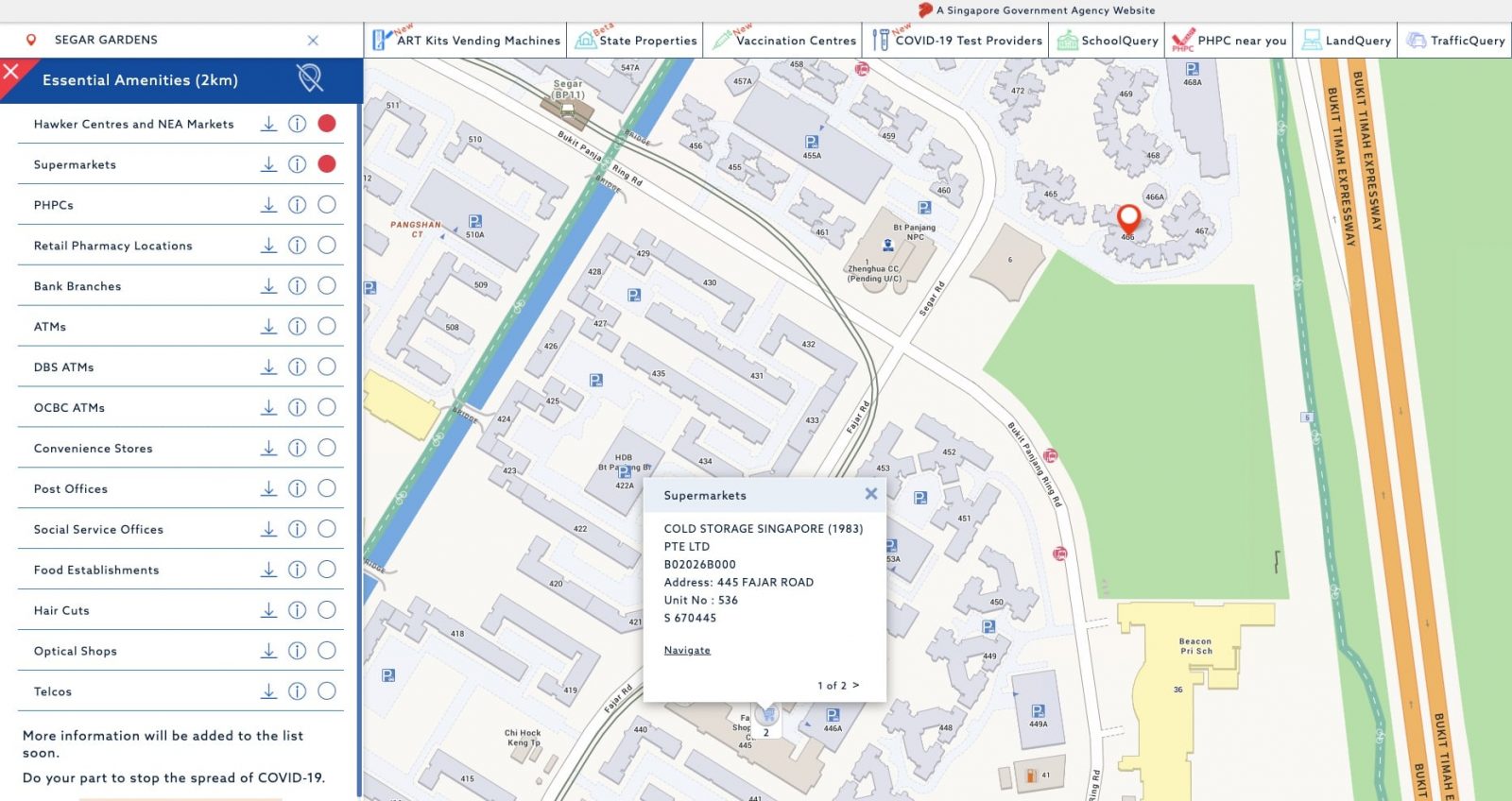
For preschools, you can either refer to ECDA’s website and type in your postal code, or utilise OneMap’s “SchoolQuery” function.
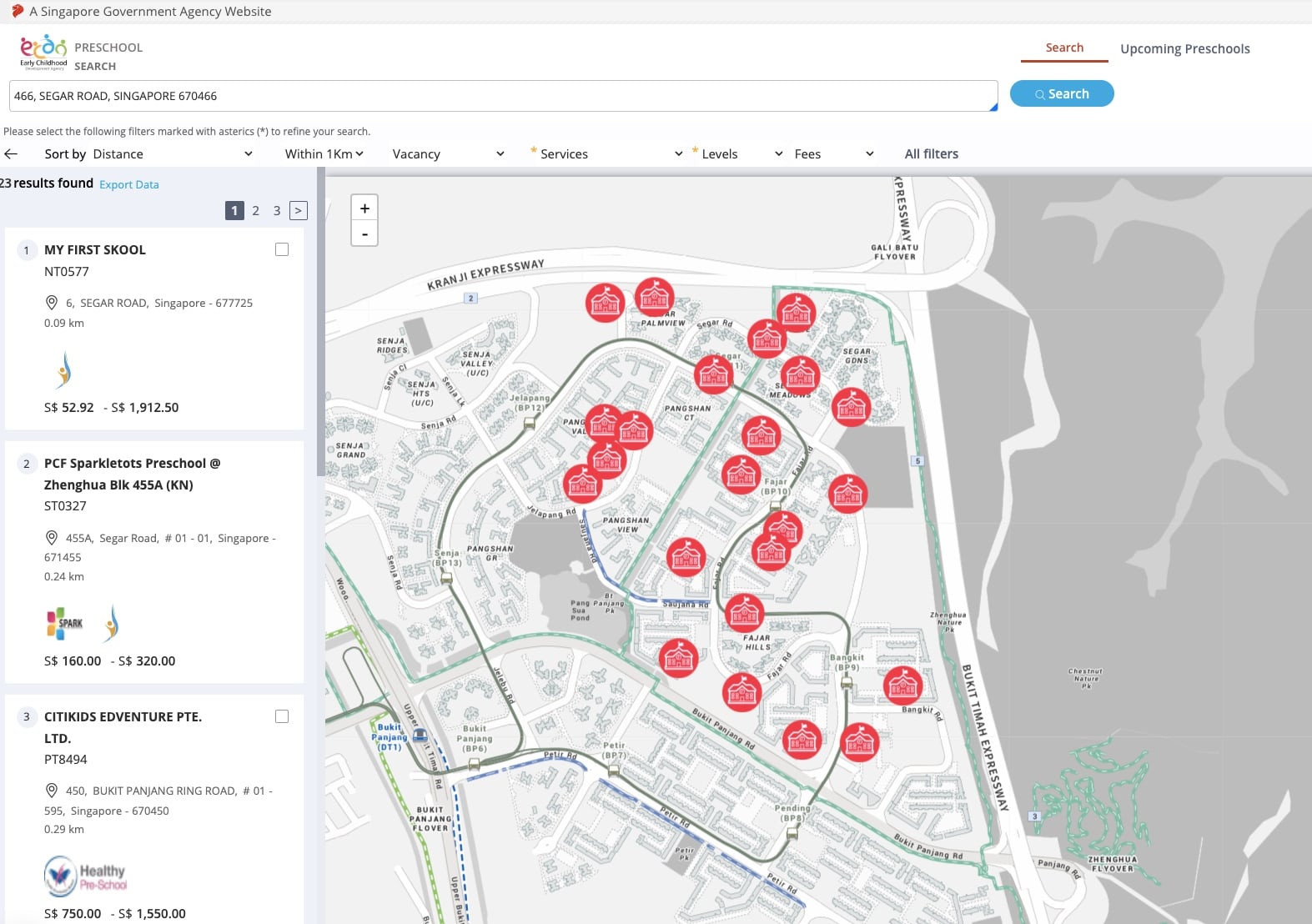
I do prefer ECDA’s website over OneMap as it has a lot more information when it comes to preschools, including the cost. You’ll also get an idea of its vacancy by looking at its estimated waiting time.
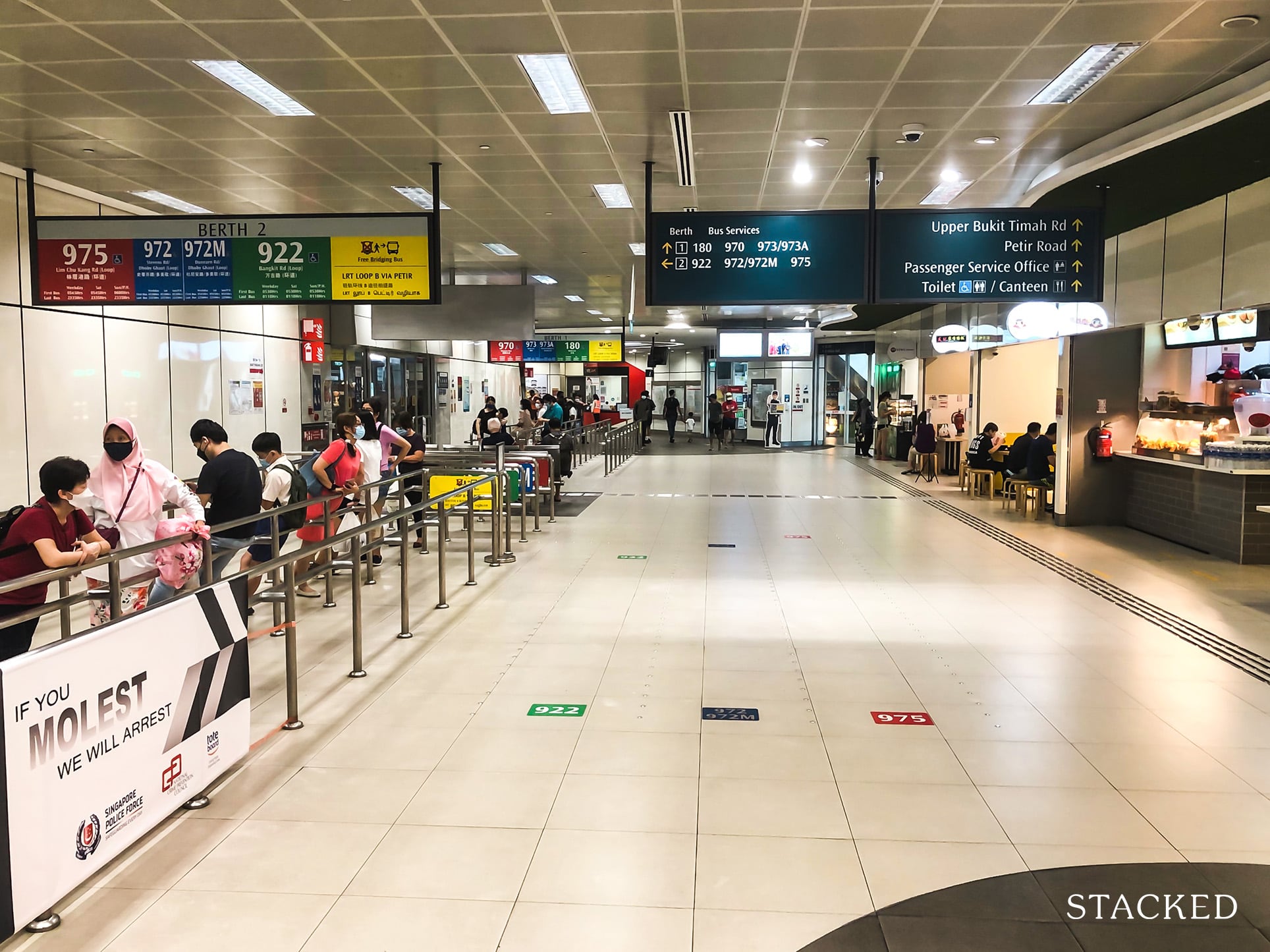
From the main MRT line, check on public transport/feeder options.
- Feeder bus services: In this example, there are a few bus routes (922, 972, 976) from Bukit Panjang Interchange
- LRT service
- Take note of journey time taken
- A mobile app such as LTA’s My Transport will come in handy
- You can also use third party websites
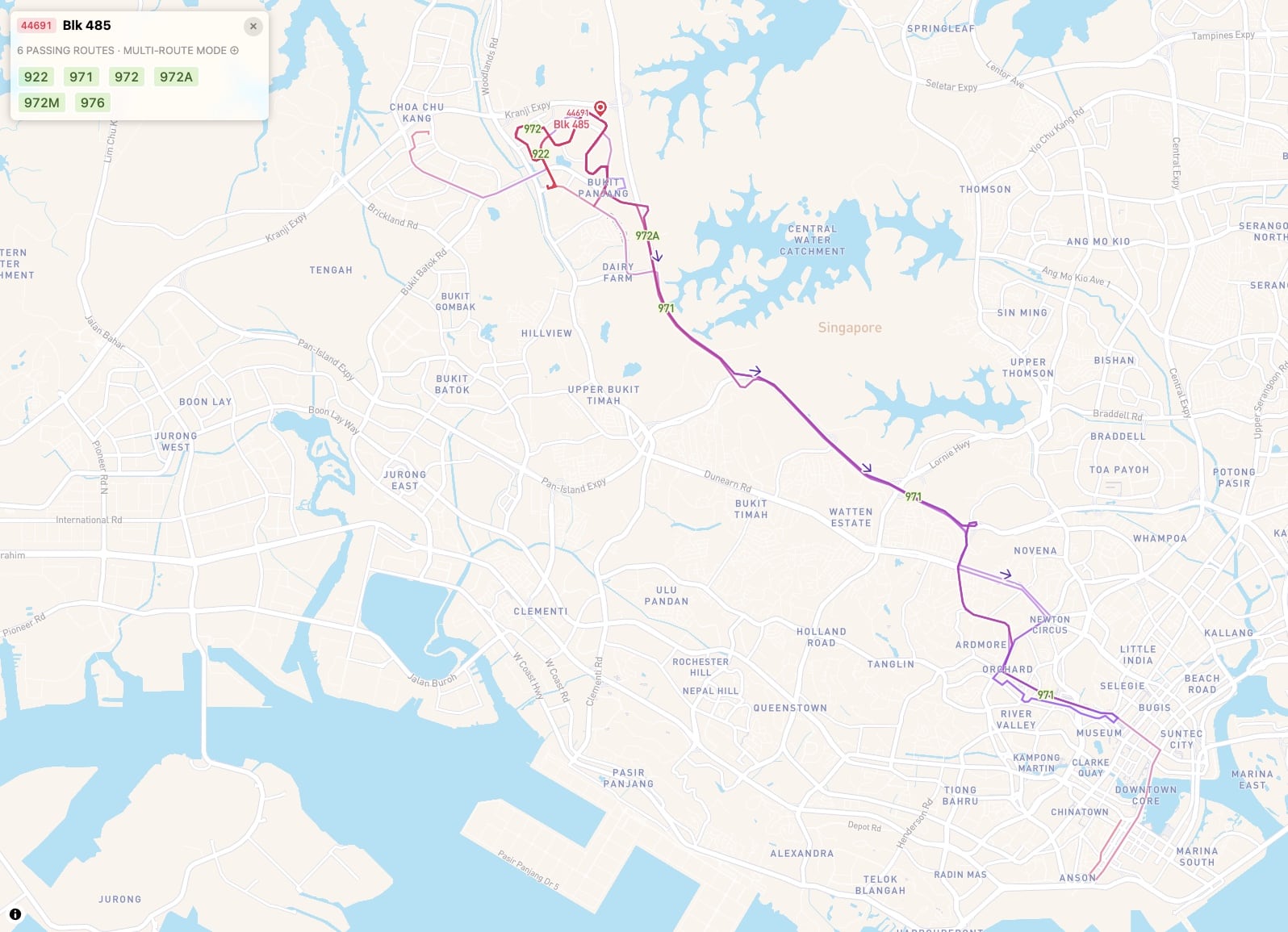
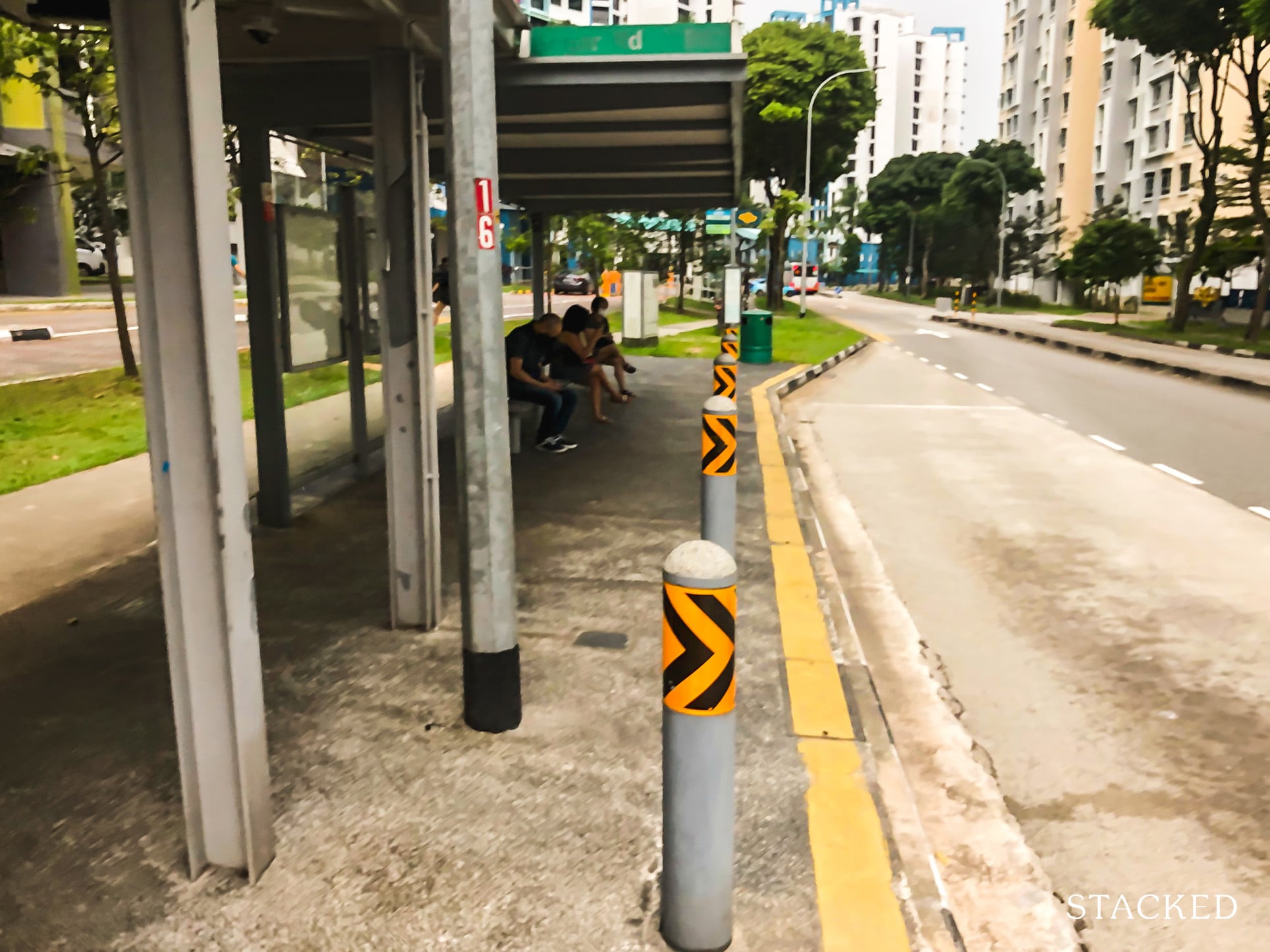
- From the nearest bus stop of the shortlisted listing, check on bus connectivity.
- Bus stop Blk 485, at Segar Road, is the nearest Bus Stop in this case.
- If you have young children or mobility-challenged family members, be wary of bus stops that require them to cross multiple busy roads, or are on steep inclines. These may not be ideal, even if the bus stop is technically “nearby”.
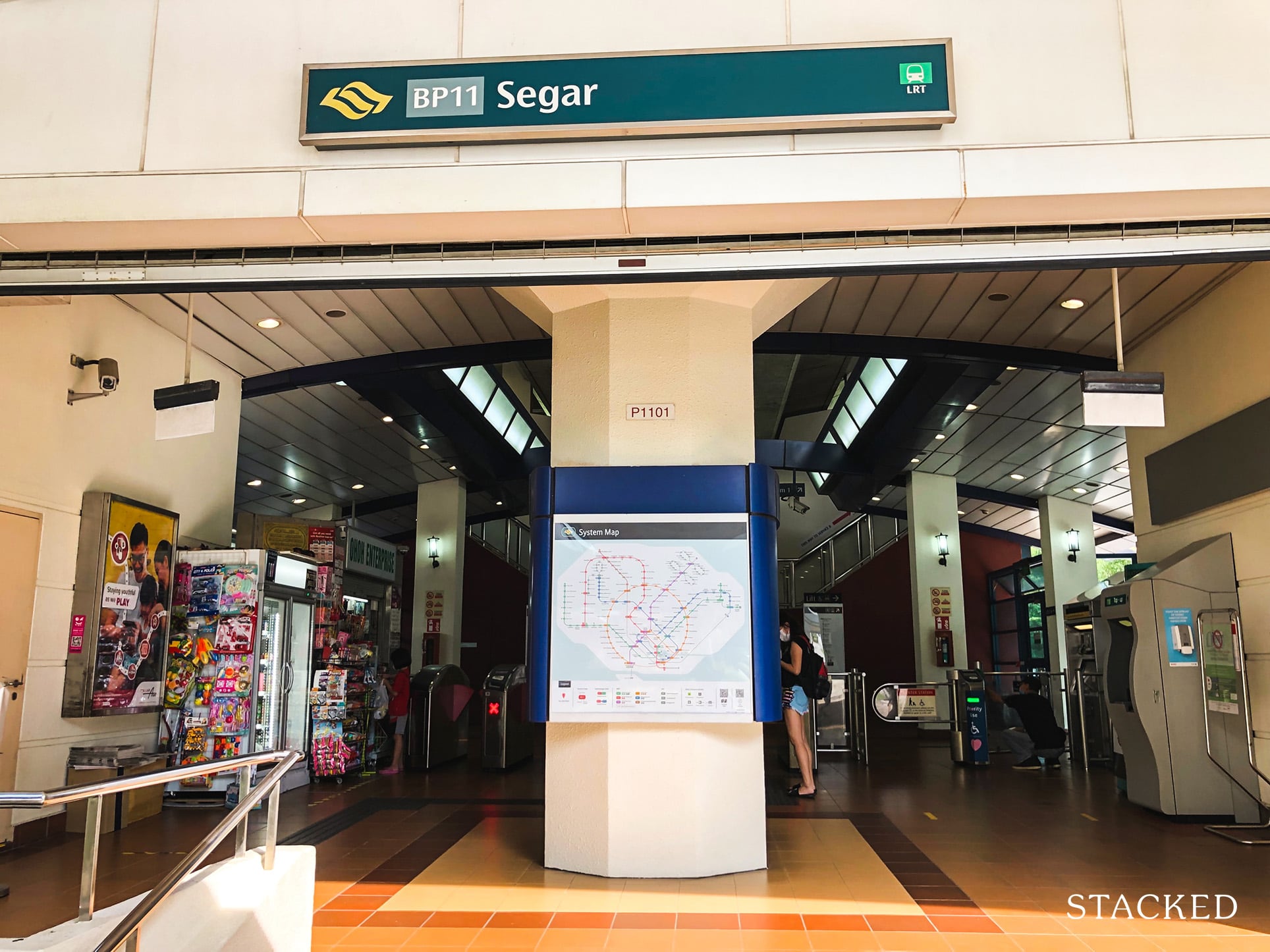
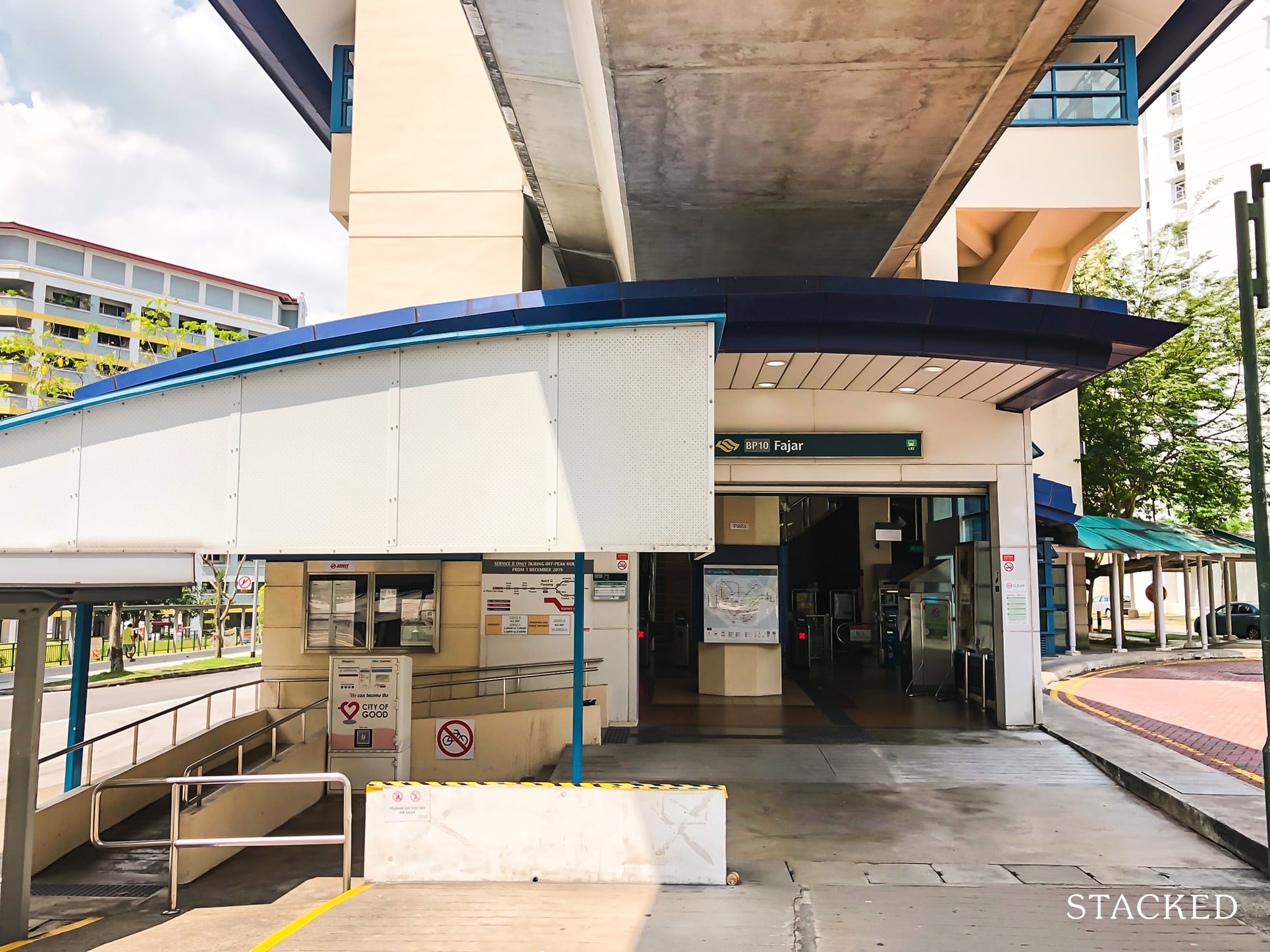
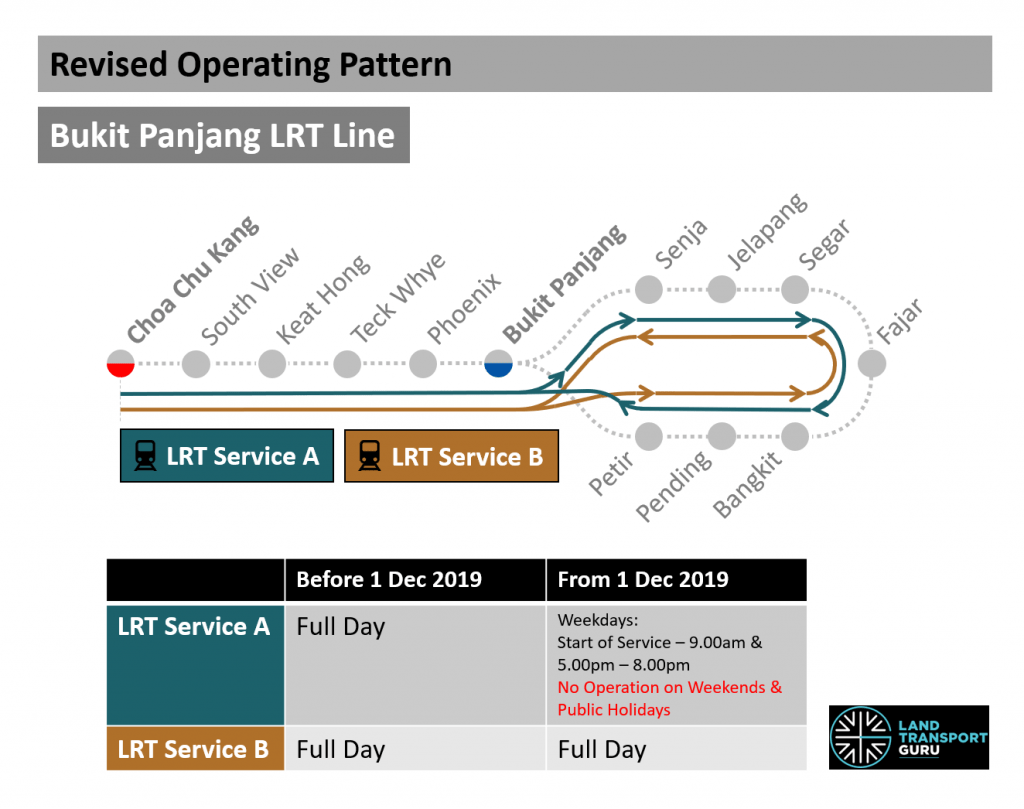
Once you’ve done your research, the next step is to go in person to check it out for yourself.
Nature
Being close to nature helps make the place seem less urban and also increases your chances of taking nice walks or just going for a run. You can easily check this on Google Maps or URA Map’s parks/waterbodies/public spaces feature:

Step 4: Examine the different routes of travel
Always try and get to the viewing by your most common mode of transport. Especially if you are reliant on public transport, try getting to the viewing half an hour or so early. It’s good to explore the surroundings on foot, or even try out alternative ways of getting to the place.
Here, we try the first method, via bus.
Route #1, via Bus Service 922.
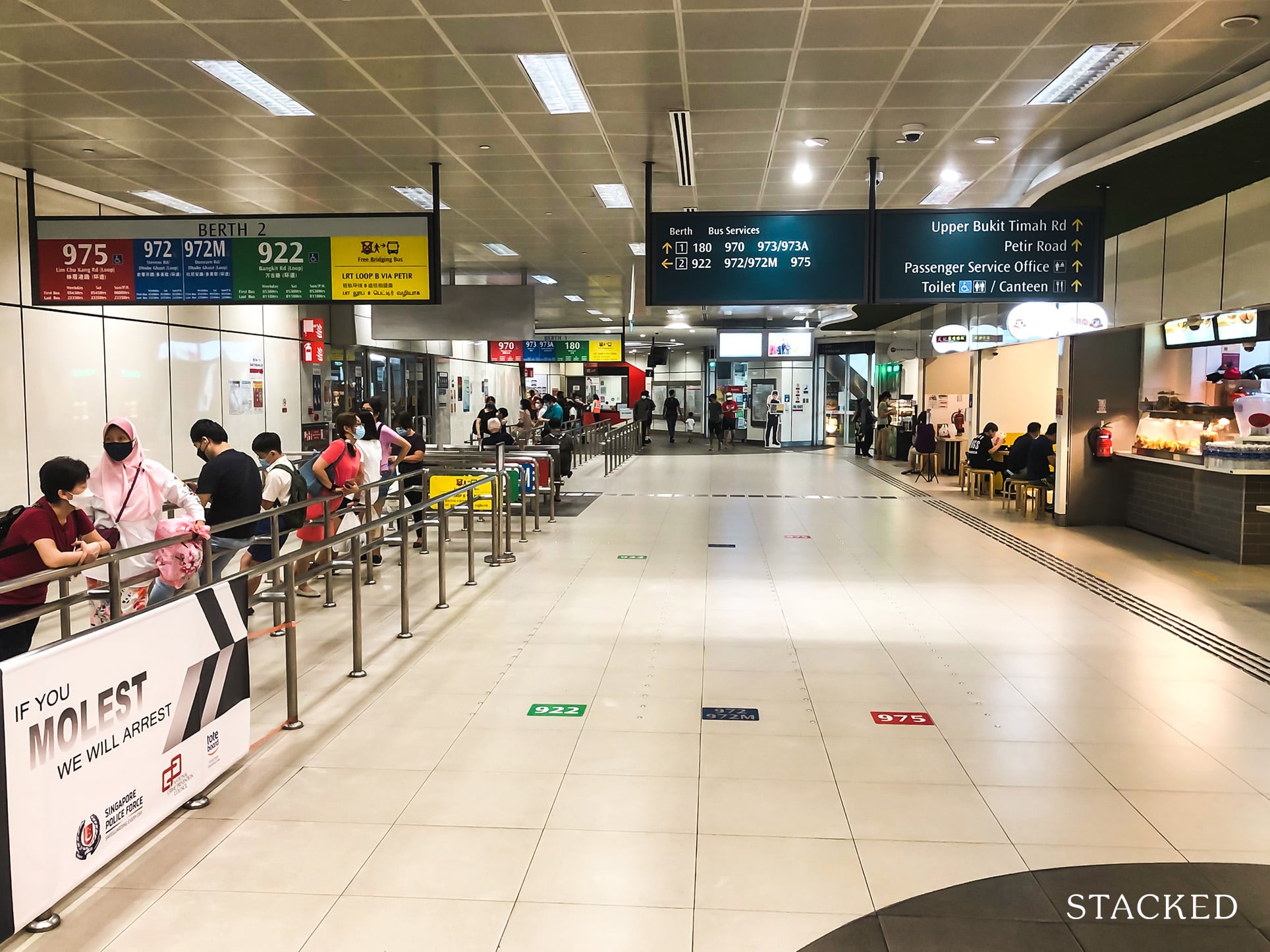
We started at 9 am, from Bukit Panjang Interchange. Here, we took bus service 922 to Block 485 Segar Road bus stop.
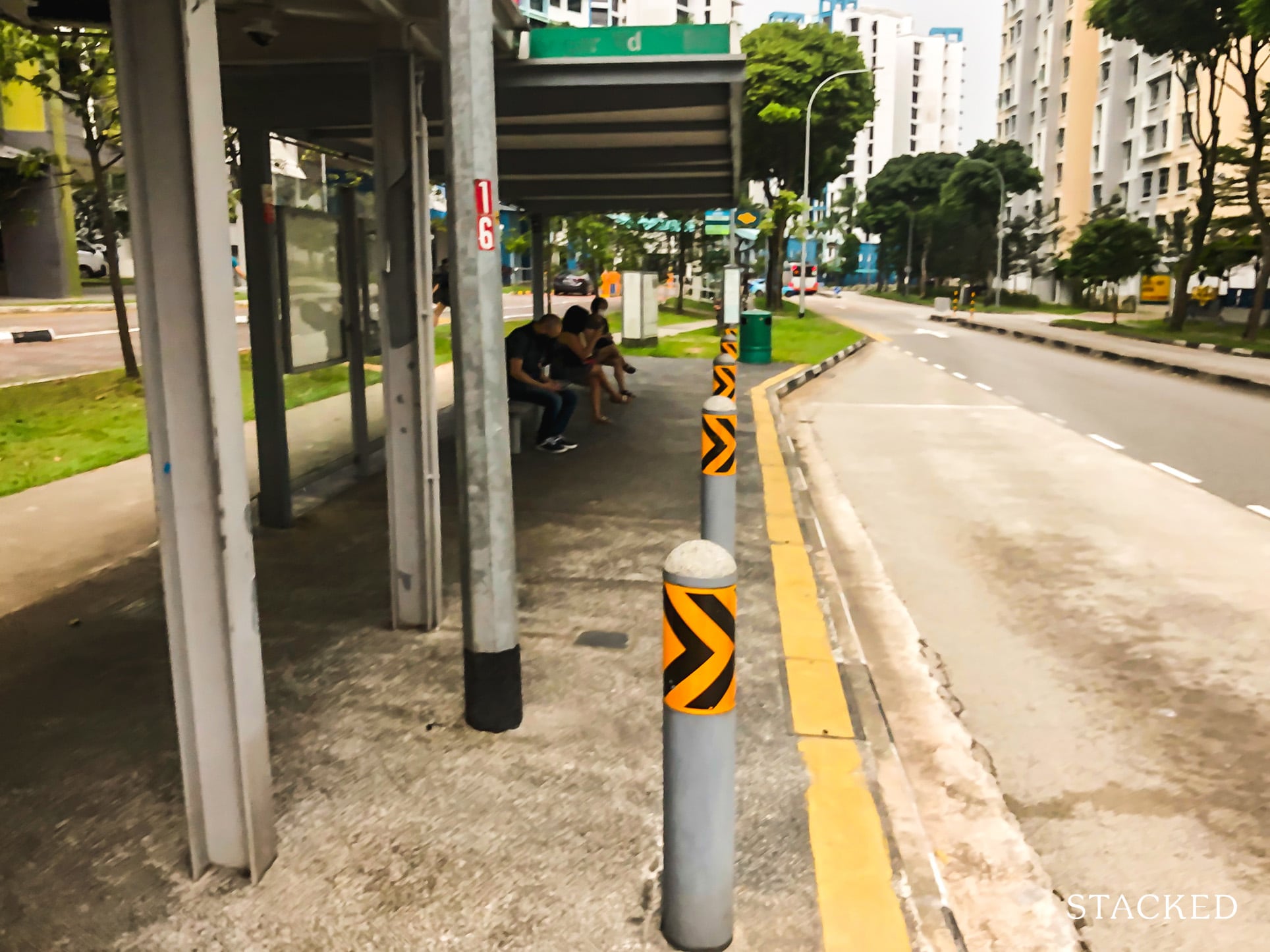
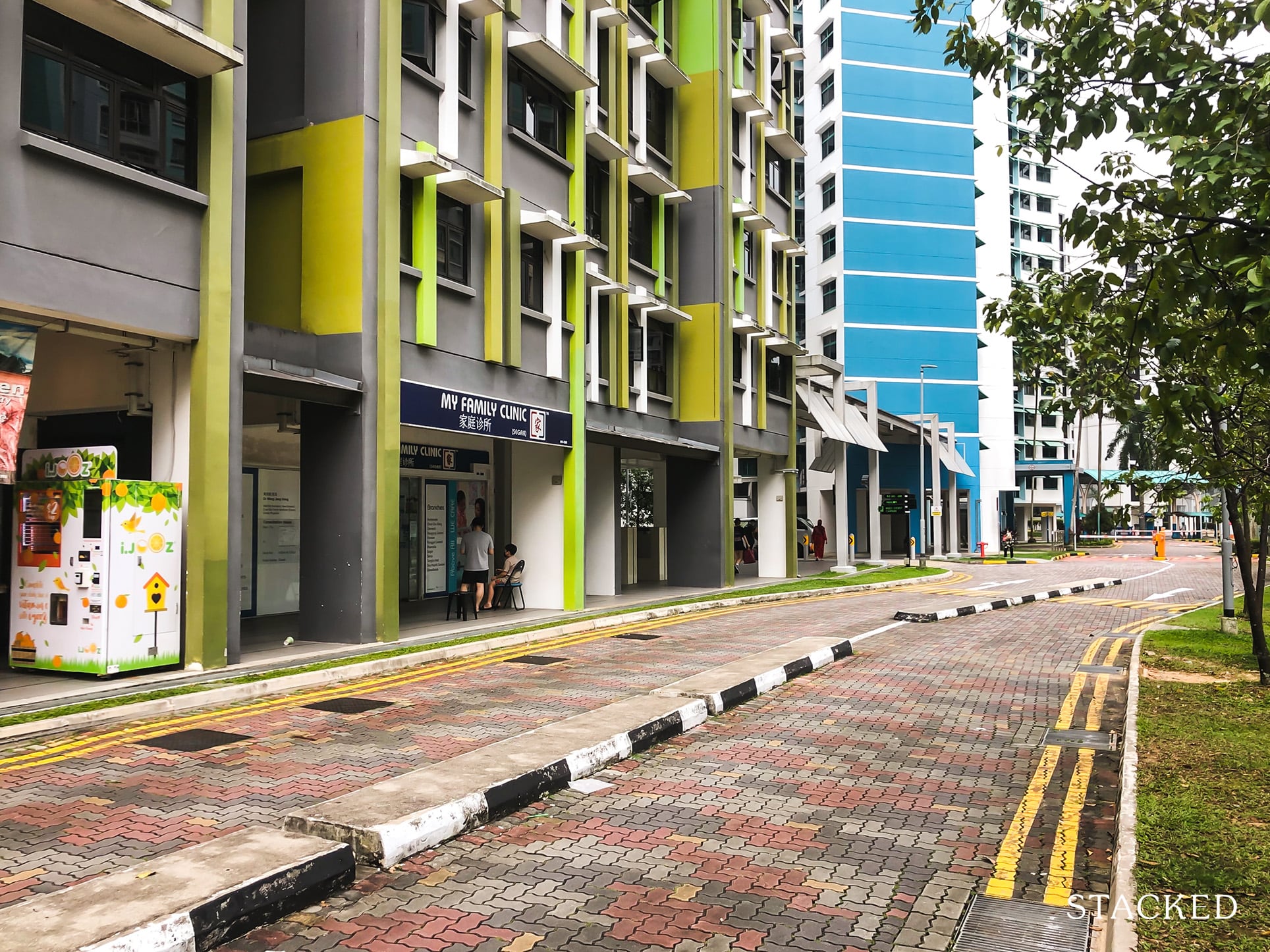
And we arrived at Block 485 Bus Stop at 9.15 am.
Again, if time permits, try another route. This was our alternative:
Route #2 Via LRT service
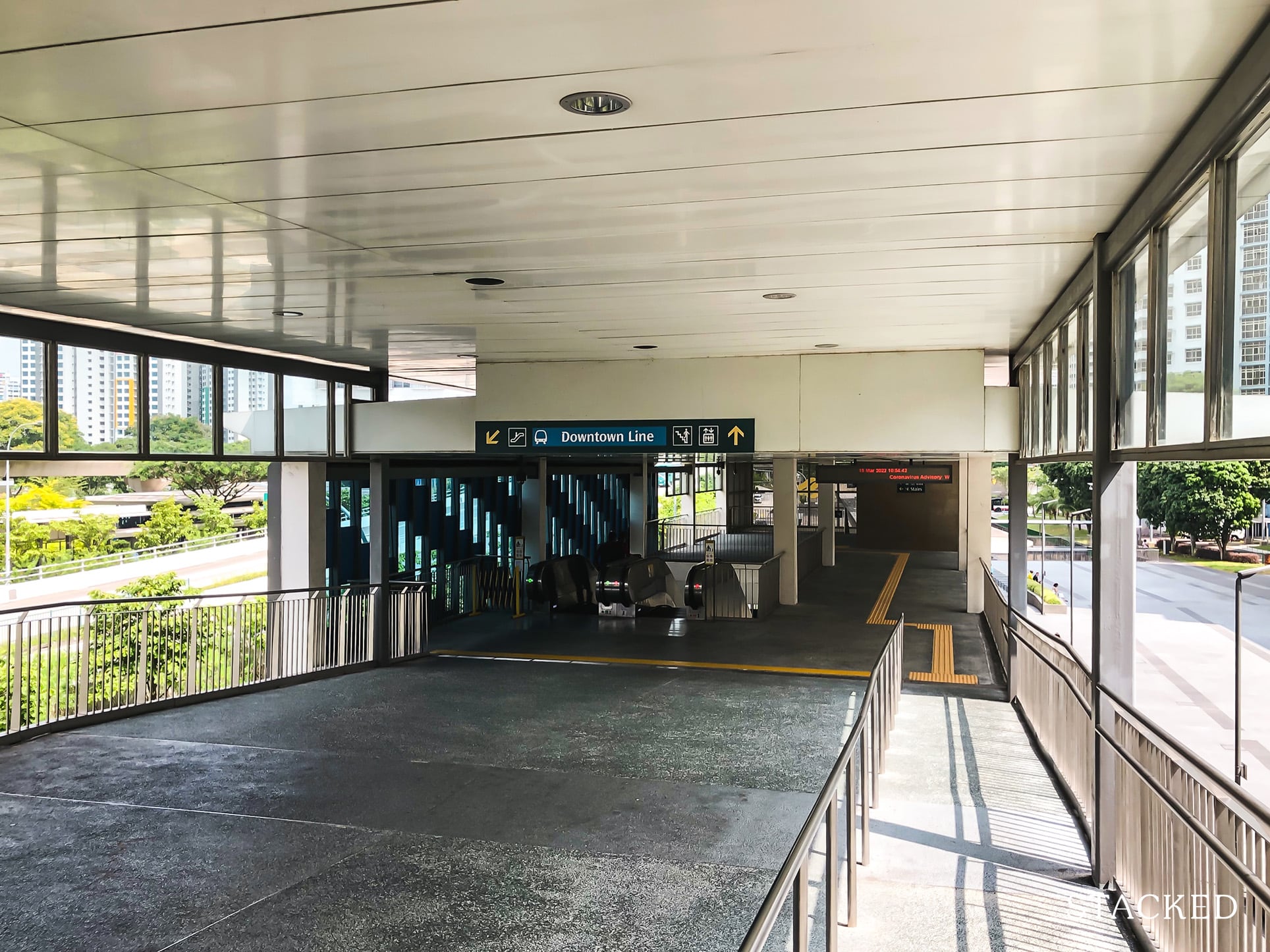
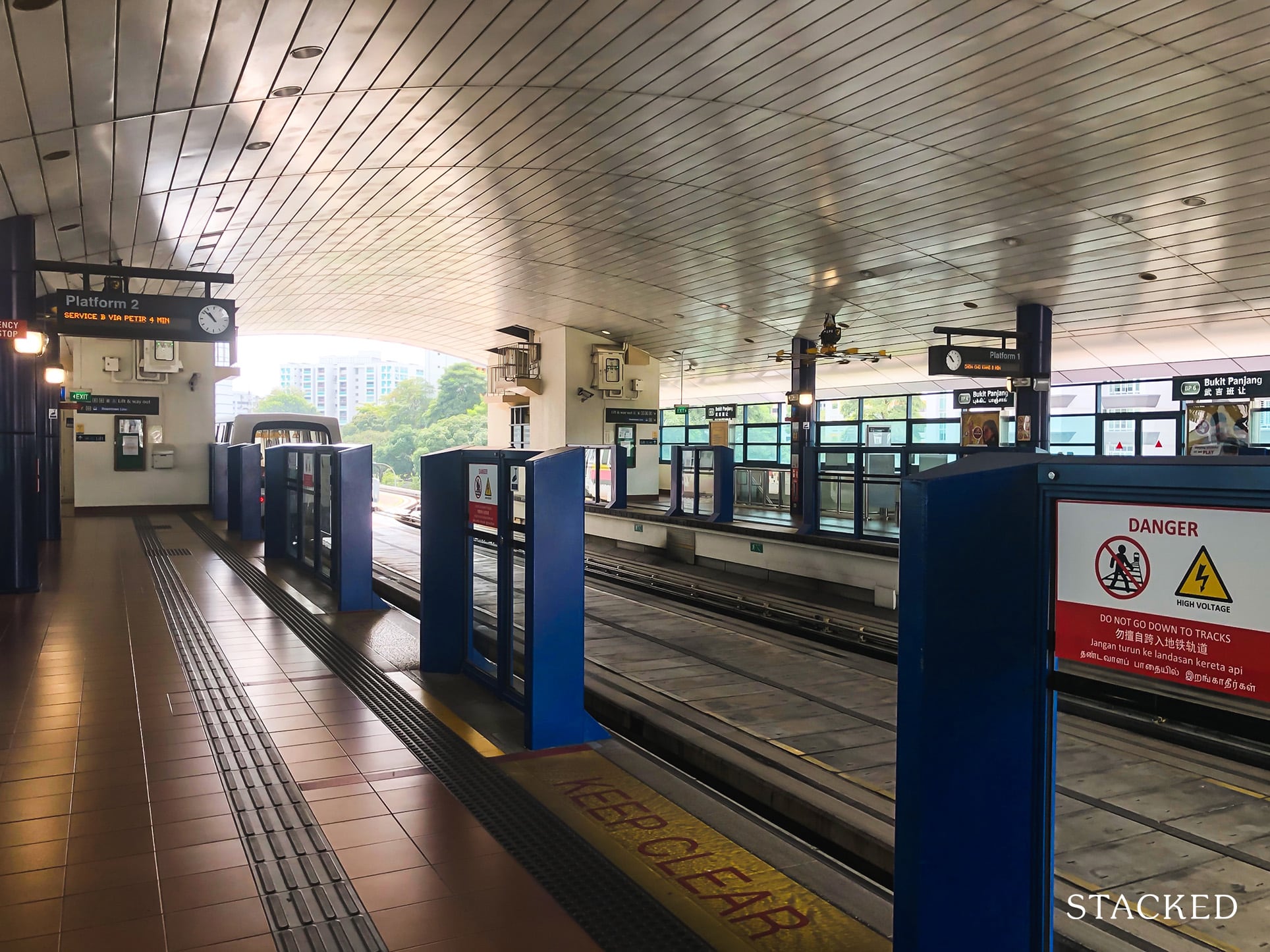
At 10.45 am, we reached Bukit Panjang MRT station, and transferred to the LRT. At the time of writing, only Petir Route Loop was in operation.
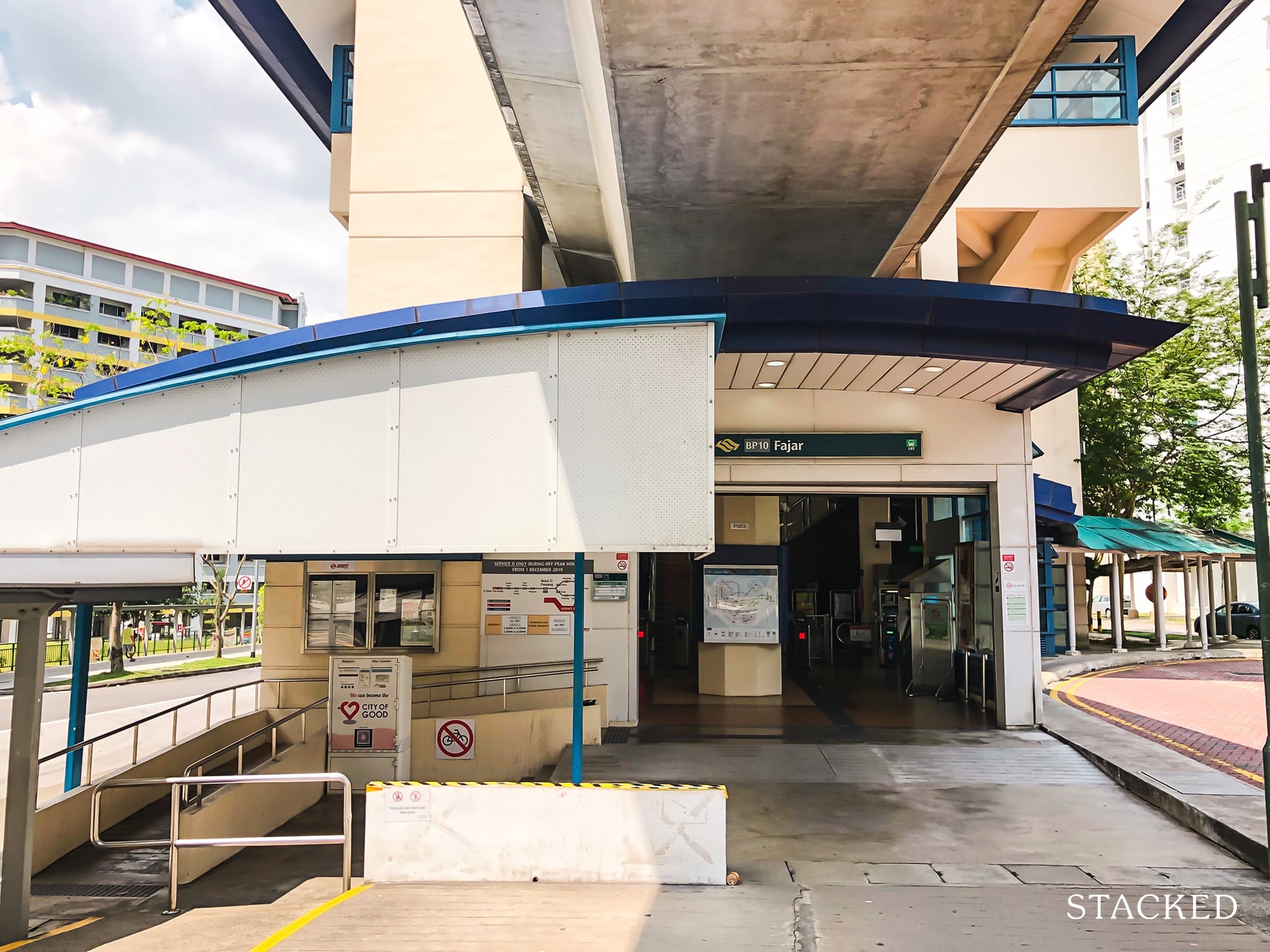
At 11 am, we reached Fajar LRT station. Of course, do take note of the time of the day you are going to and from the block. Naturally, going at a time like this (and also with the pandemic and WFH in mind), it should be less crowded. For full disclosure, try coming again on another day at peak hours to really experience what the traffic flow is like.
Here are a couple of other pointers:
- Take note of the distance from your block to the LRT
- Check on updated route and operations timings
- Use third party websites or get the latest updates from the LTA website
- In this case, we can see our unit is between two LRT stations, Segar and Fajar. It’s a walkable distance to either station
- Take note of the time taken from the station to block
- Look for shortcuts that may not show up on map apps
- Note if much of your walk is sheltered
- One Map (see above) is helpful for this too
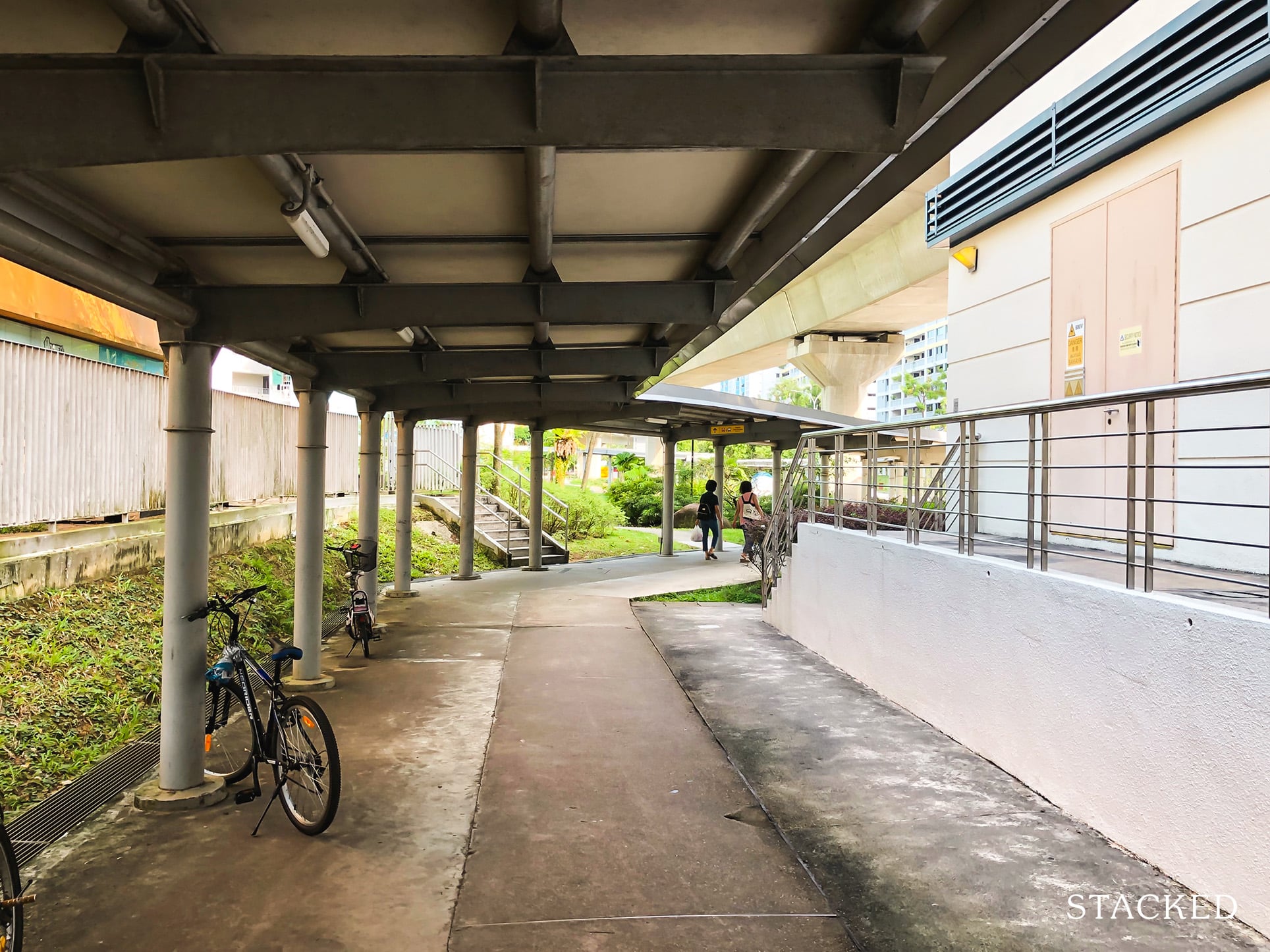
And so from Segar LRT station,
- Approximately 5 minutes walk
- Cuts through HDB blocks for a shortcut.
- Fairly sheltered, except for the road crossing
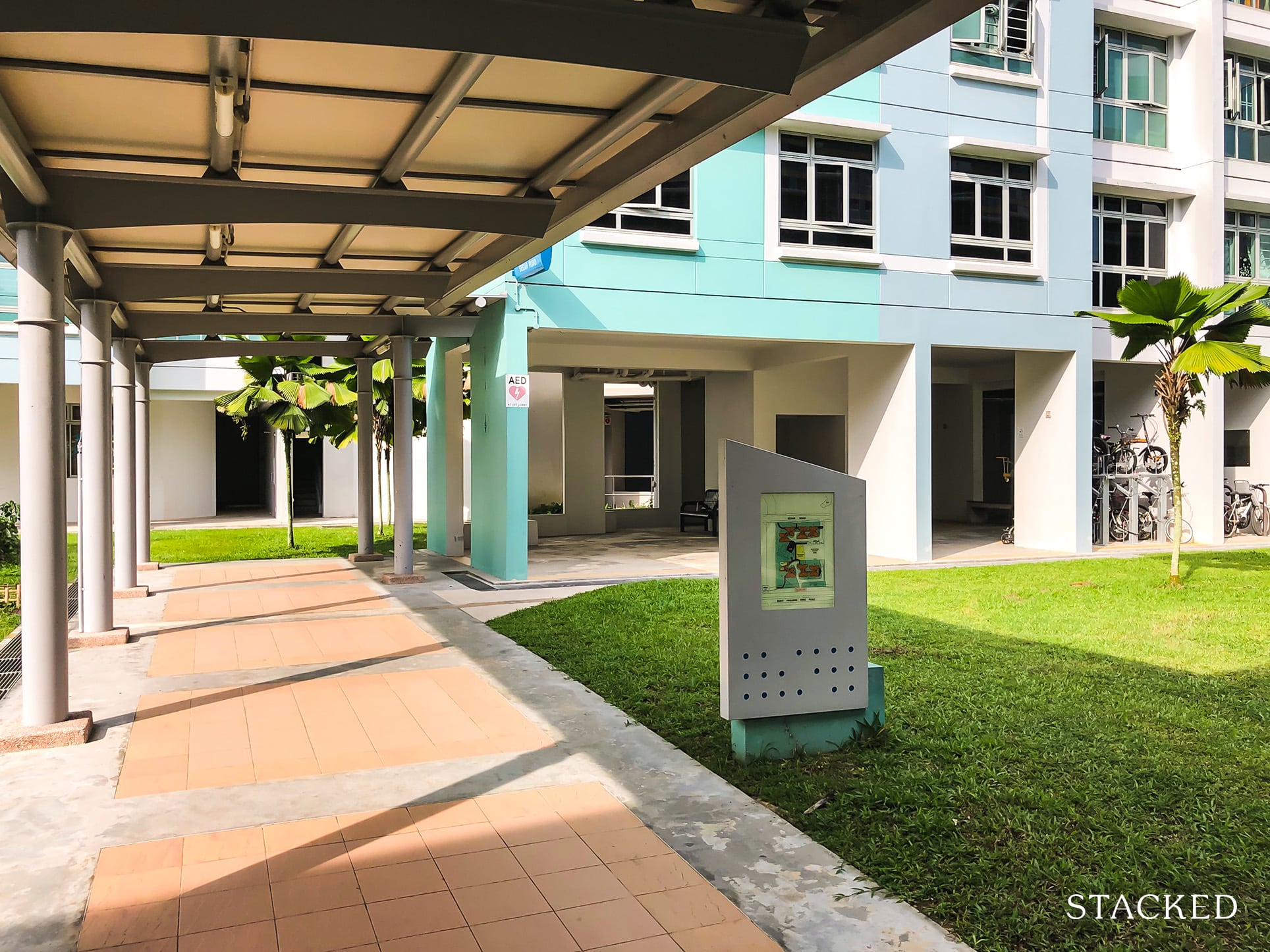
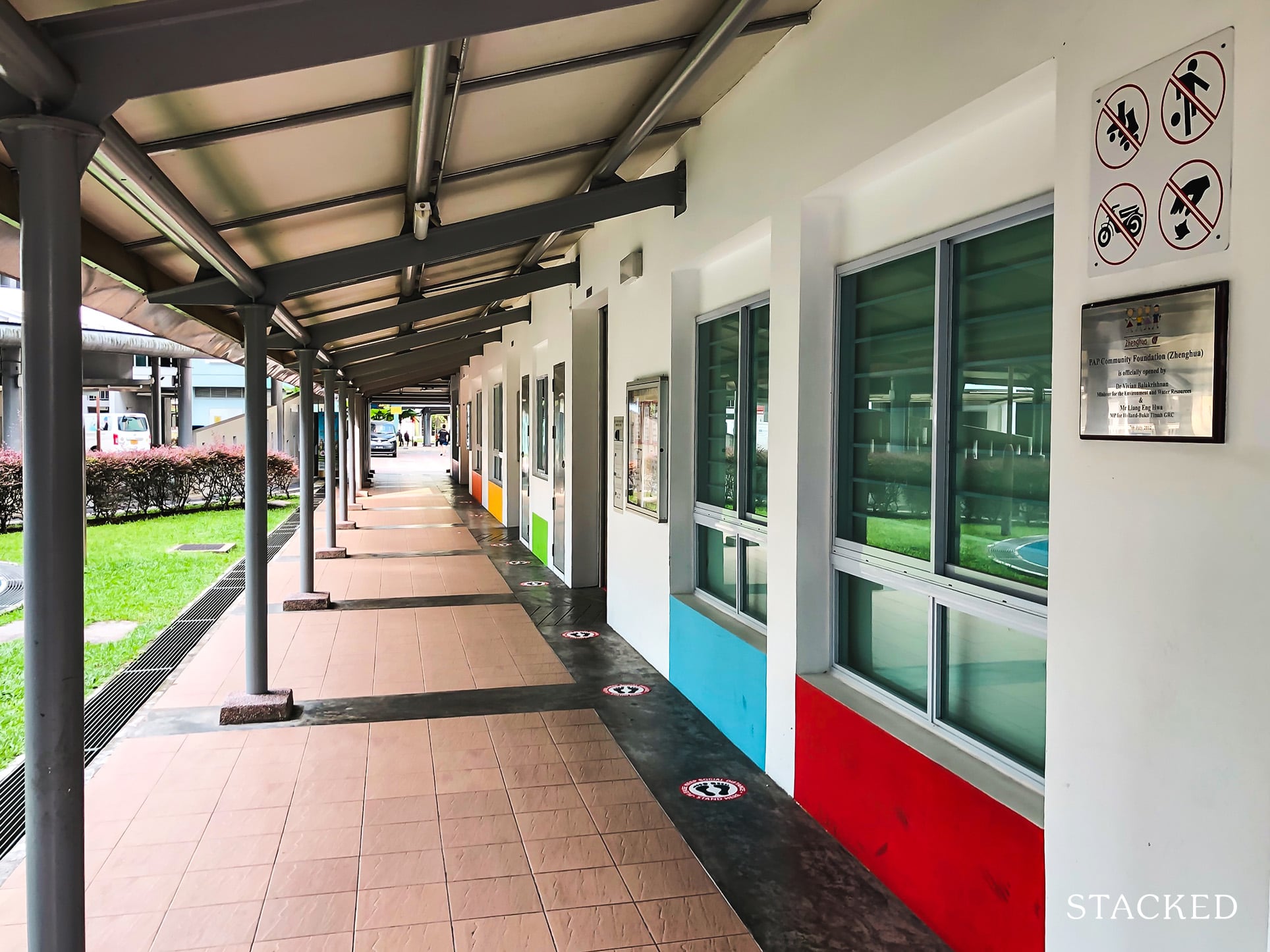
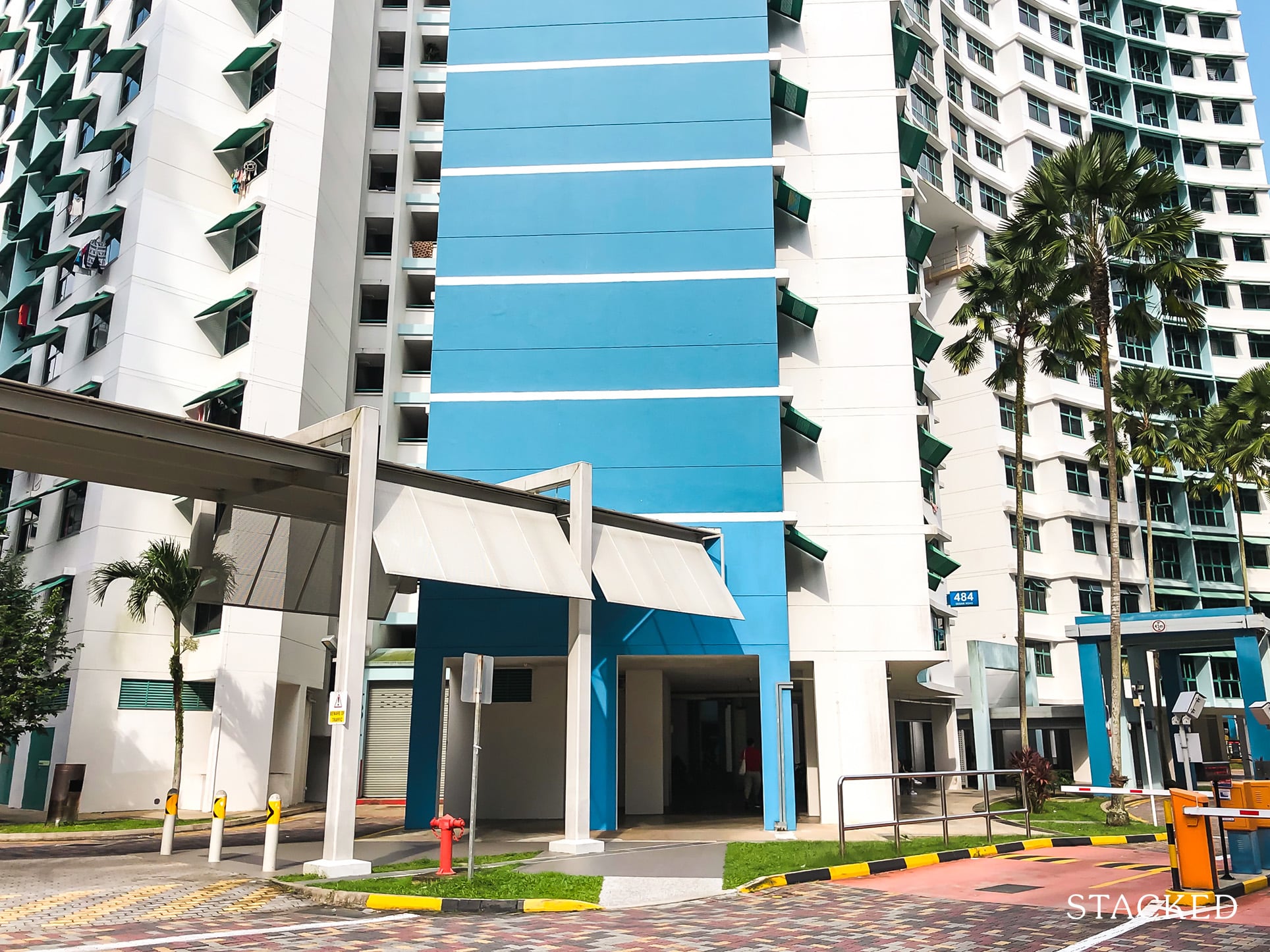
From Fajar LRT station,
- Approximately seven-minute walk
- Mostly sheltered, except for the road crossing
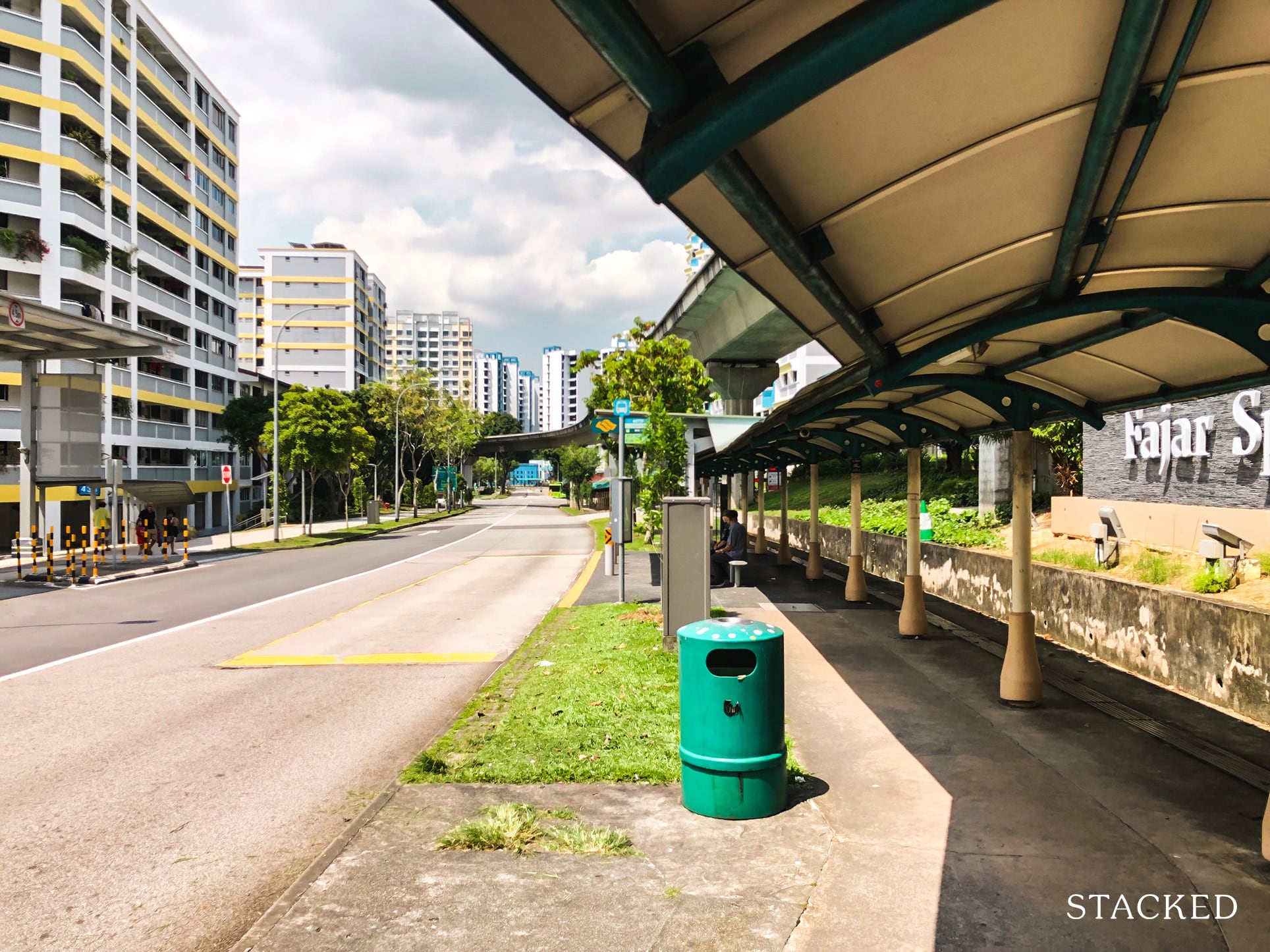
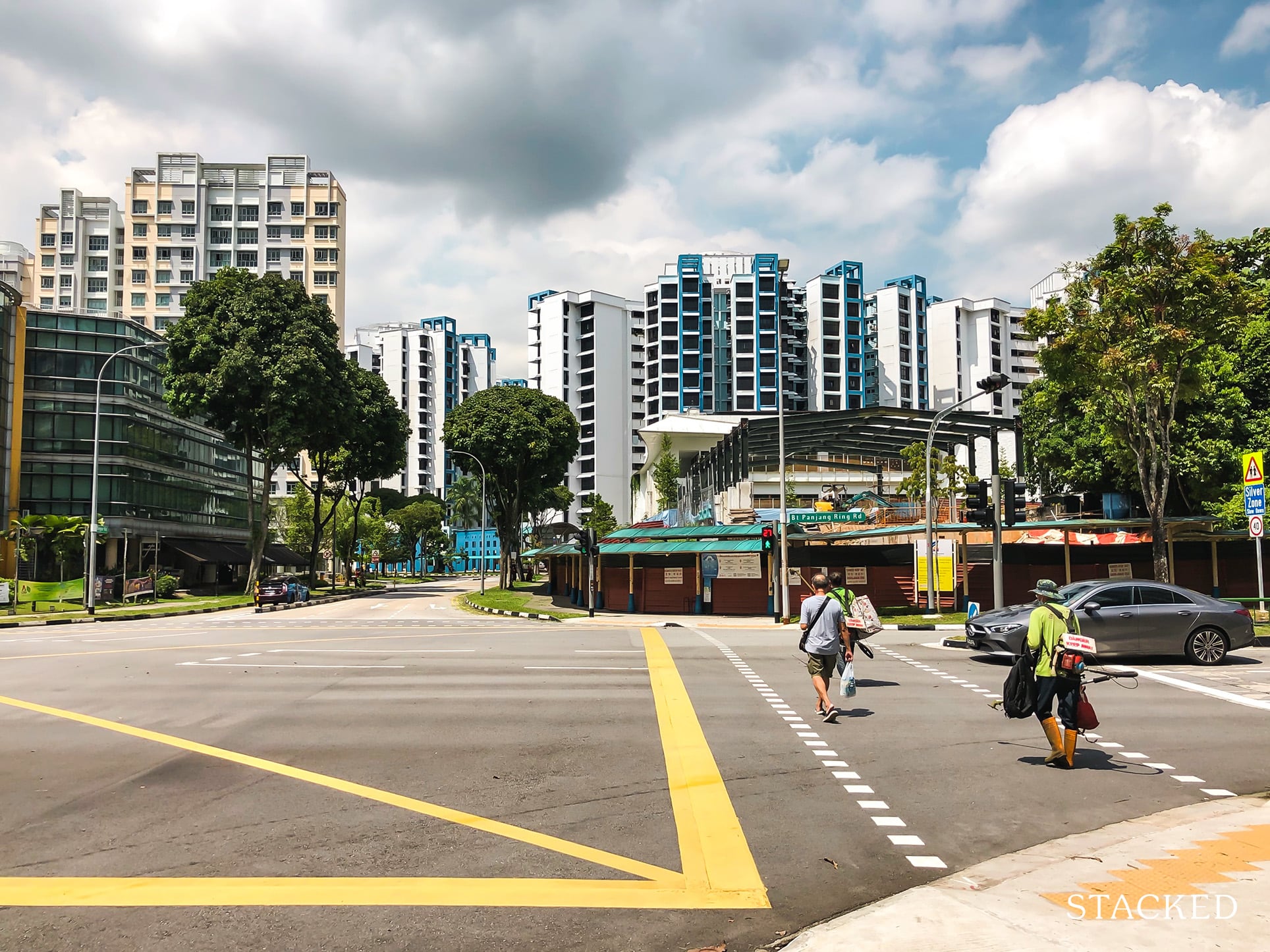
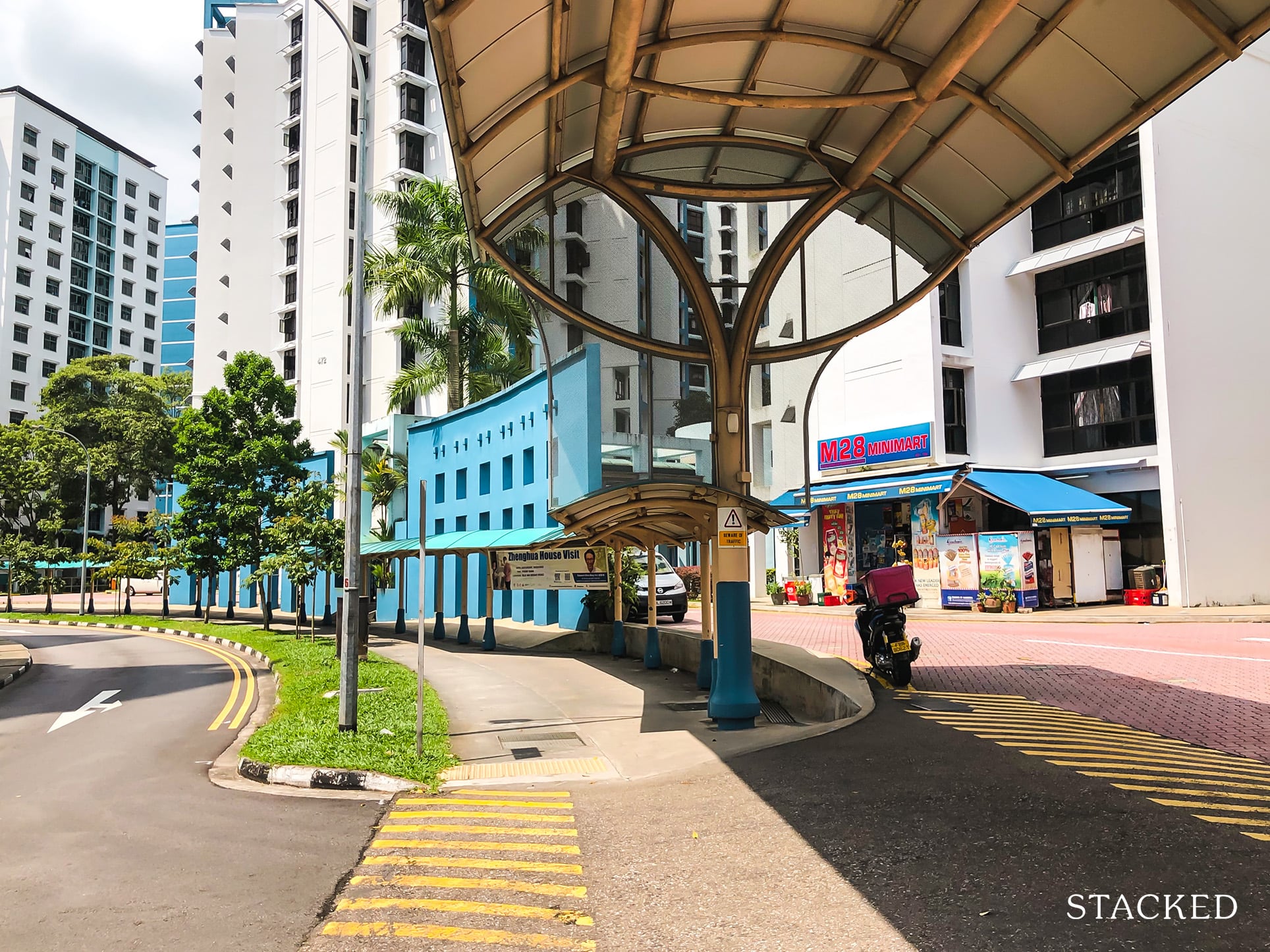
Step 5: Check surrounding amenities and distance
Check the amenities in the neighbourhood. Start by looking for the absolute essentials, such as childcare, eldercare, clinics, etc. Beyond that, you can start looking at wet markets, neighbourhood malls, etc.
As a loose rule of thumb, mixed-age construction is good for family living (i.e., there is a mix of both old and new malls nearby). This is because many day-to-day amenities, such as hair salons, small enrichment schools, etc., rarely appear in brand new malls; the rent is usually too high for them.
In our example unit, we see a good range of old and somewhat new options:
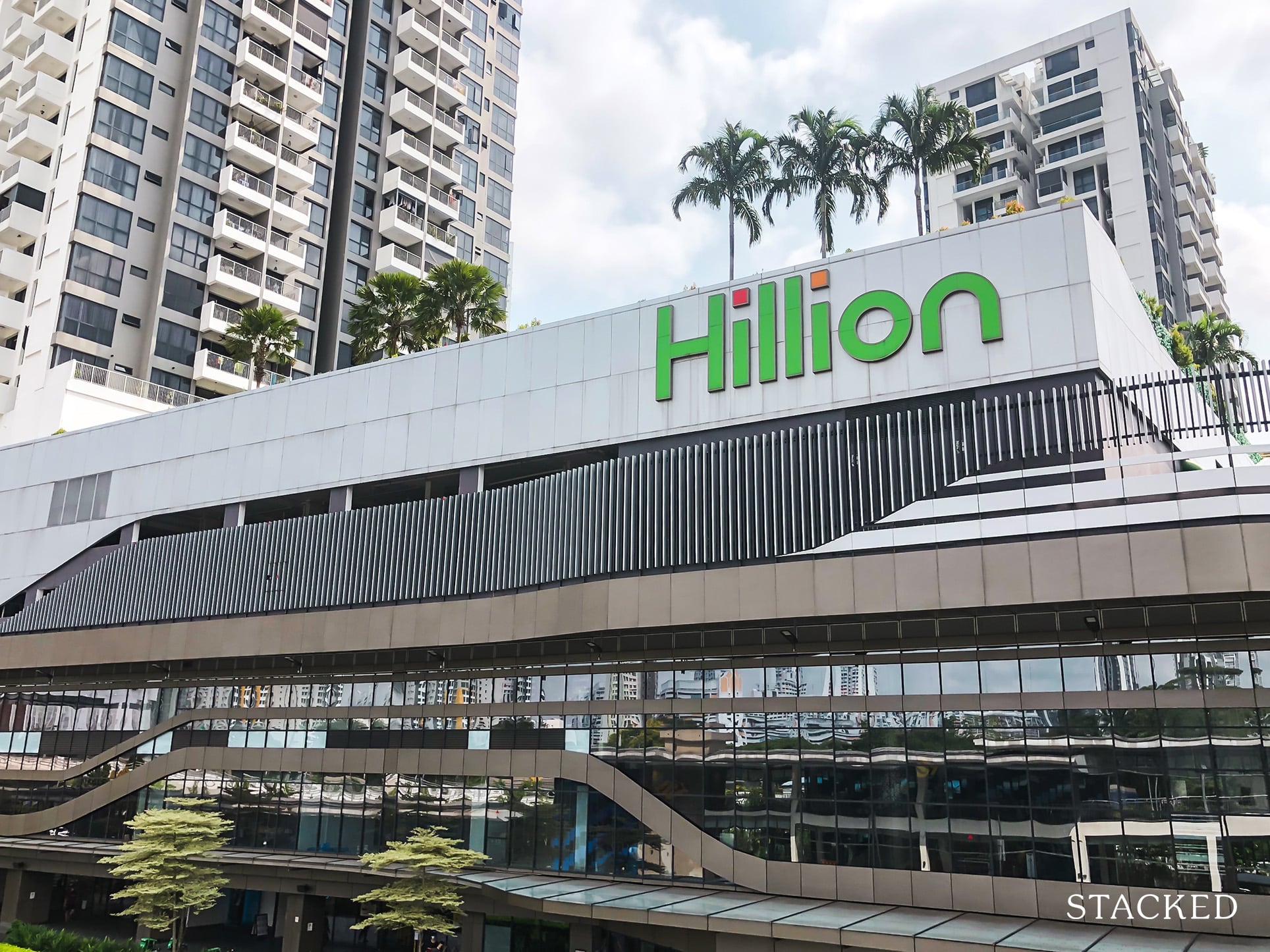
Bukit Panjang is particularly blessed in the mall department, with major malls like Hillion Mall.
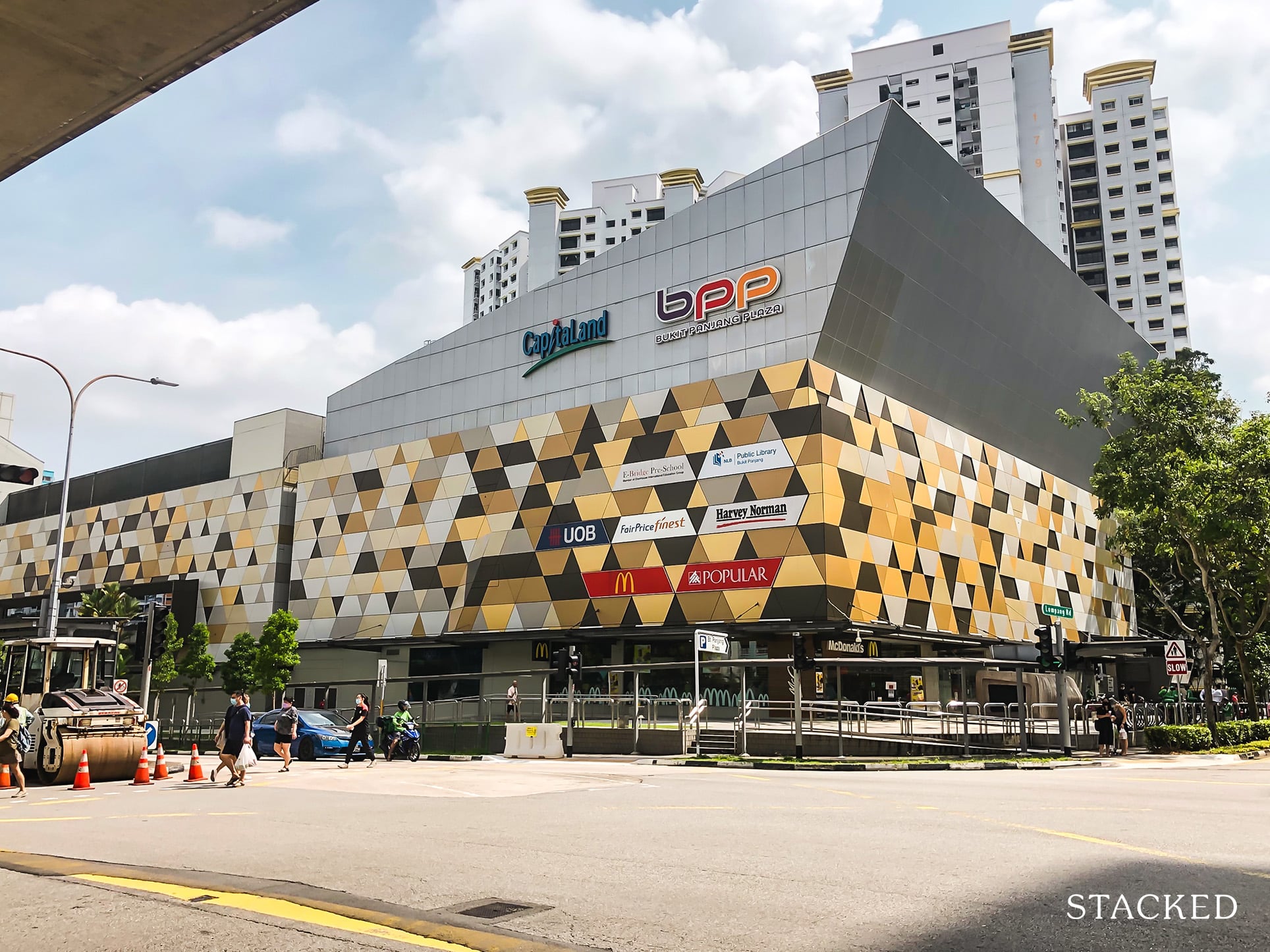
And you also have the older Bukit Panjang Mall. Still, with a FairPrice Finest, Harvey Norman, the various banks and a public library (plus a whole lot of food options), it is still a very viable option. There is also Junction 10 with a Sheng Siong, but the tenant mix really isn’t great, and it is the furthest out comparatively.
Wet Market
- Fajar Bangkit
- Upcoming Senja Road Market
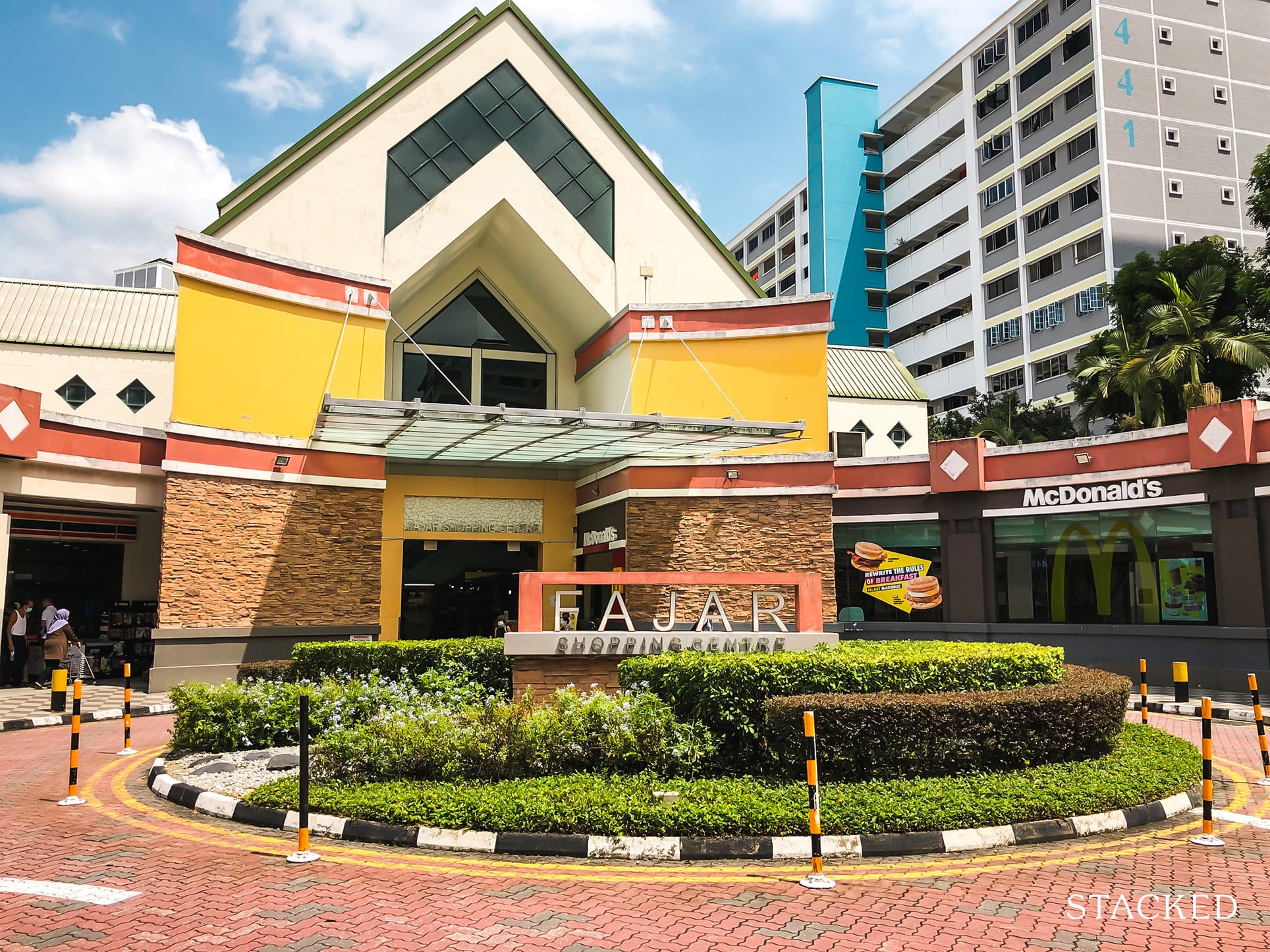
Neighbourhood malls
- Greenridge Shopping Centre
- Fajar Shopping Centre
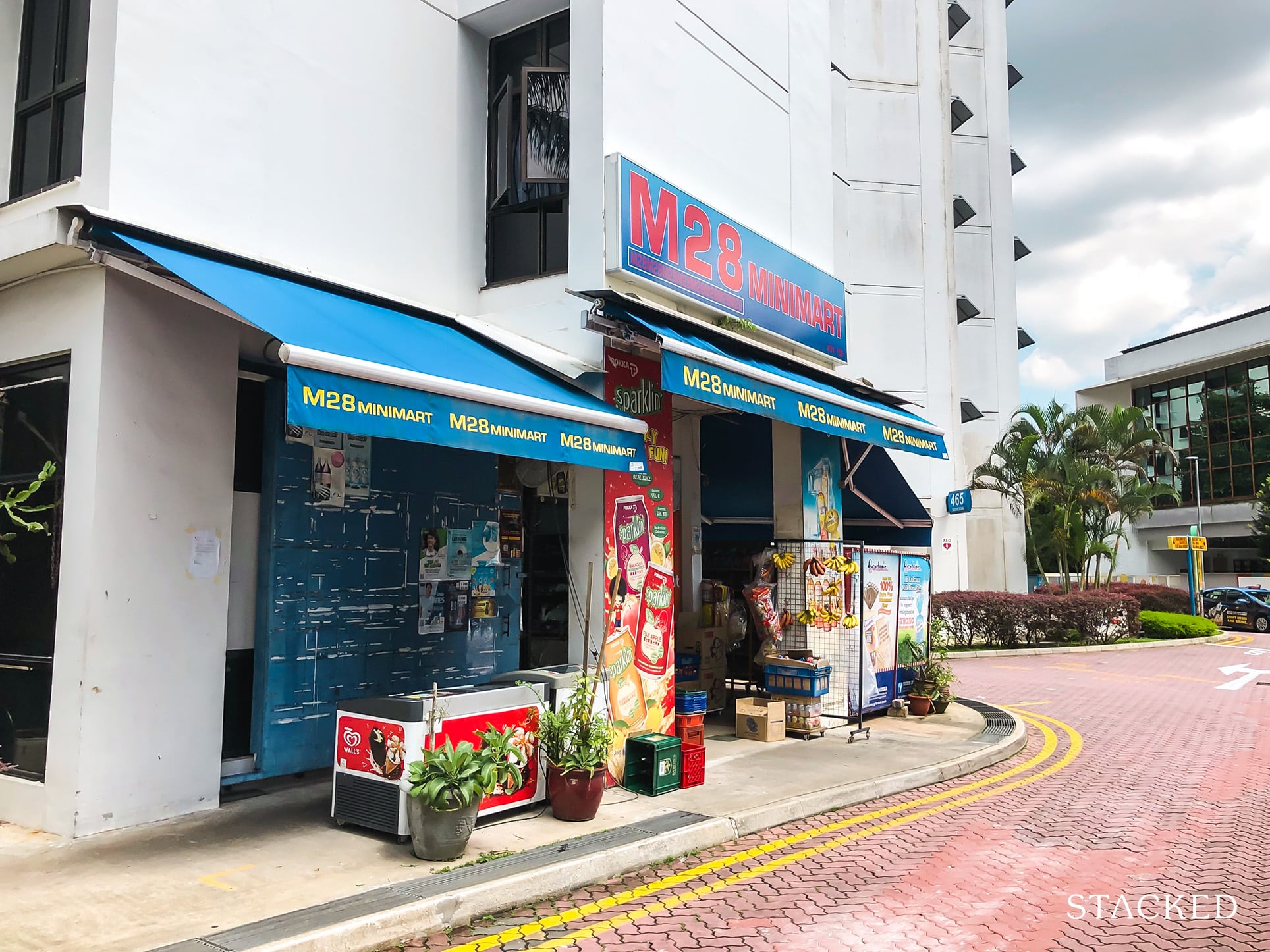
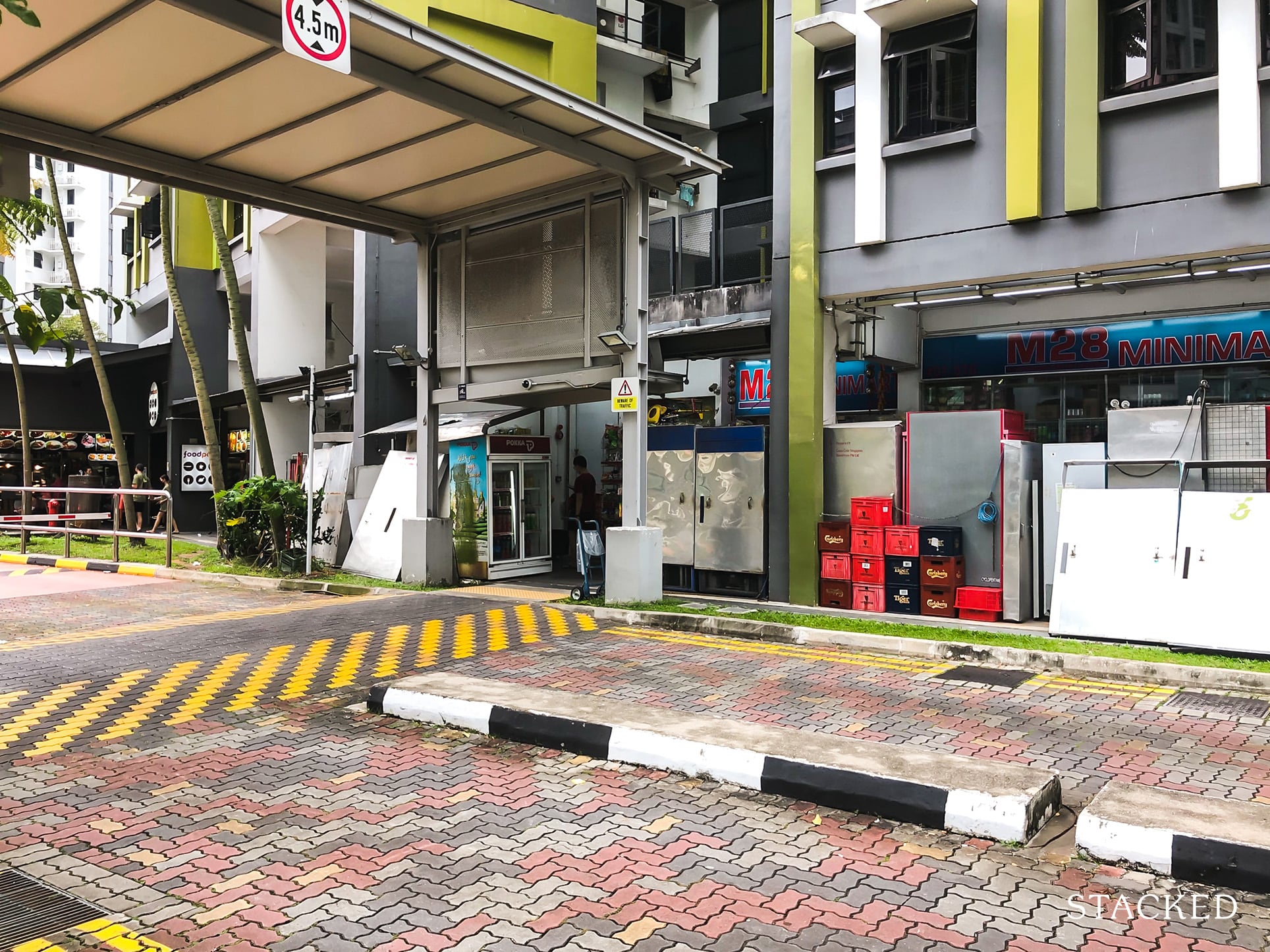
Minimart in/near development
- Closest Minimart block 465
- Alternative minimart located at block 485
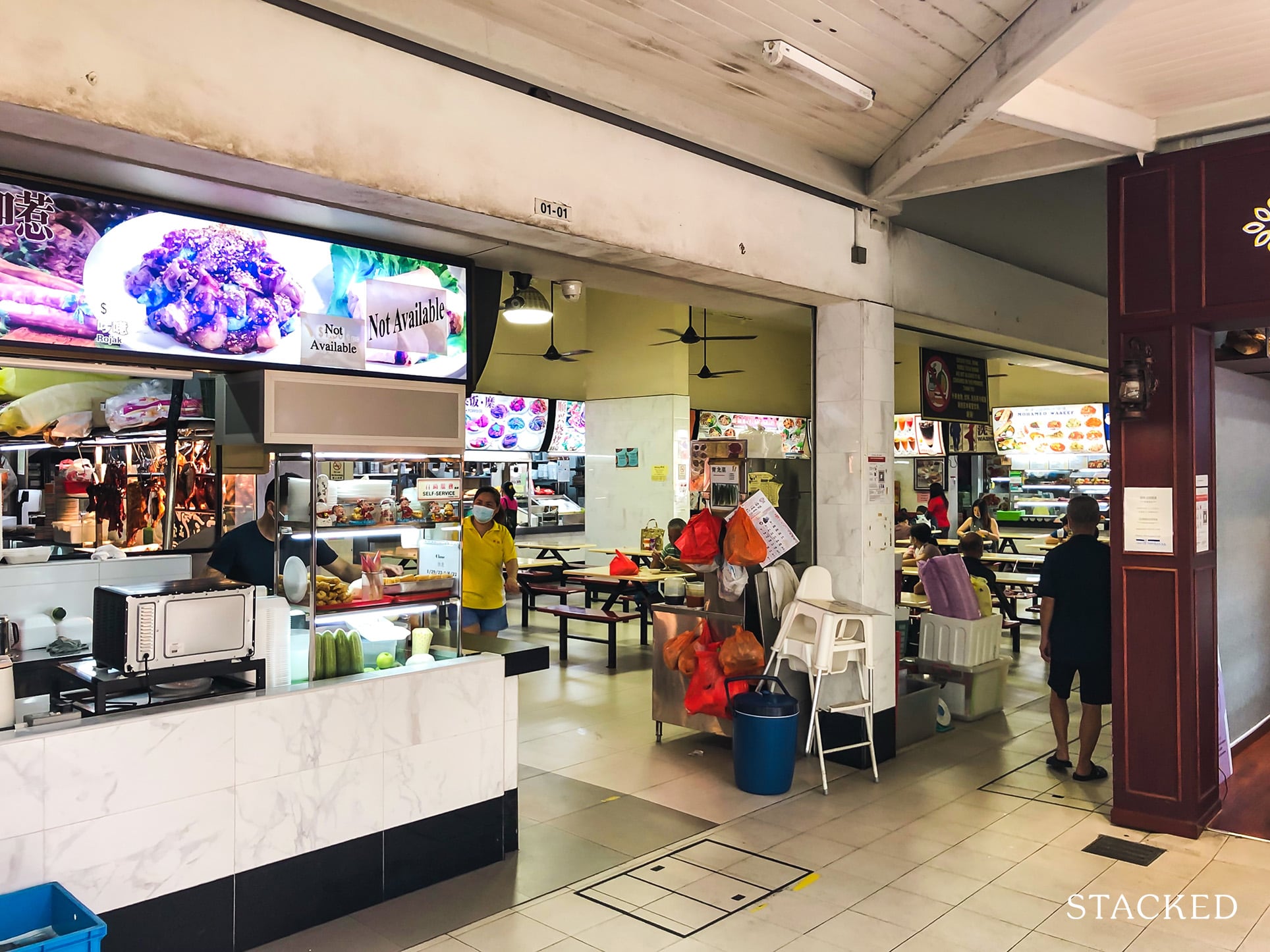
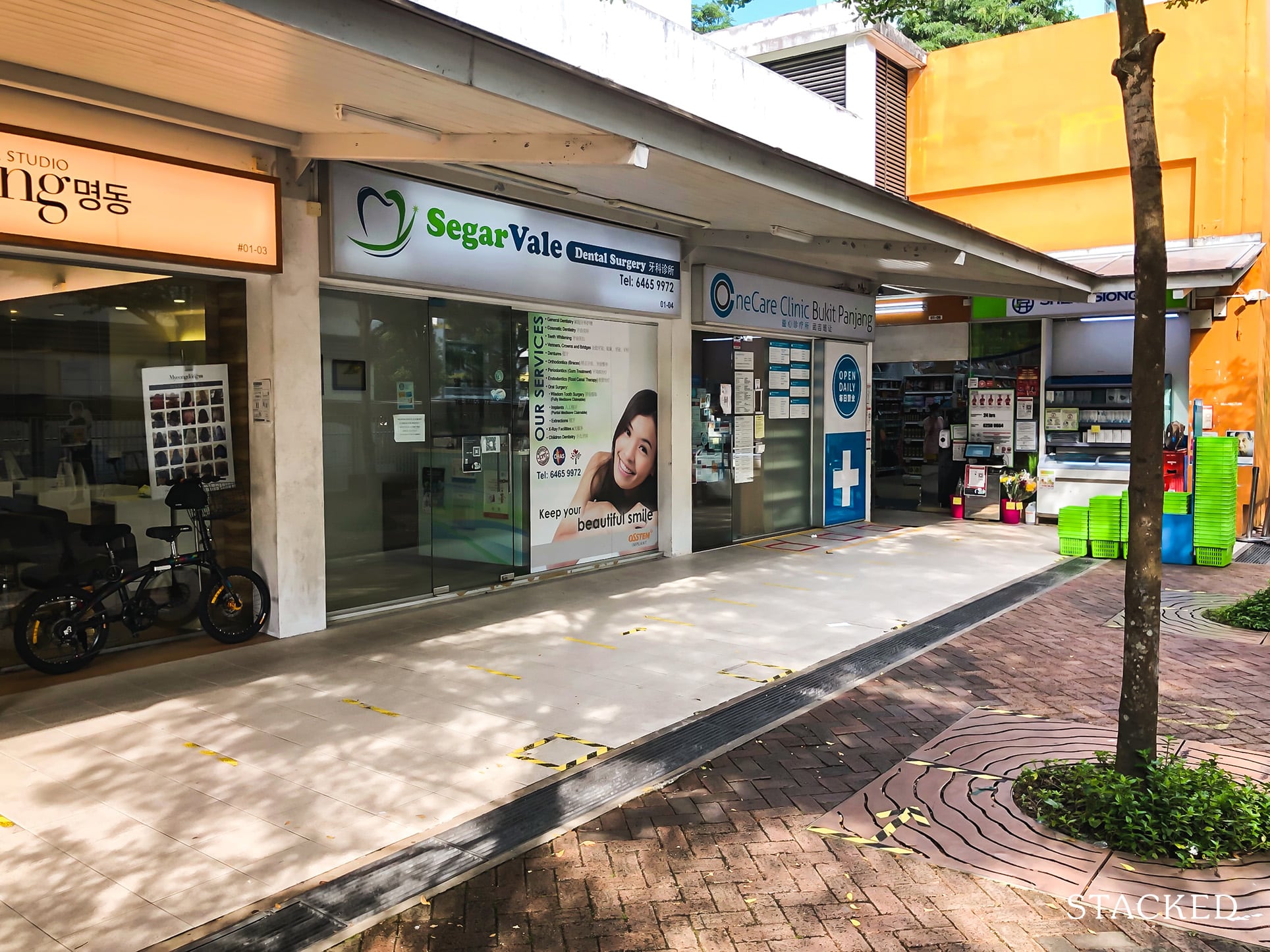
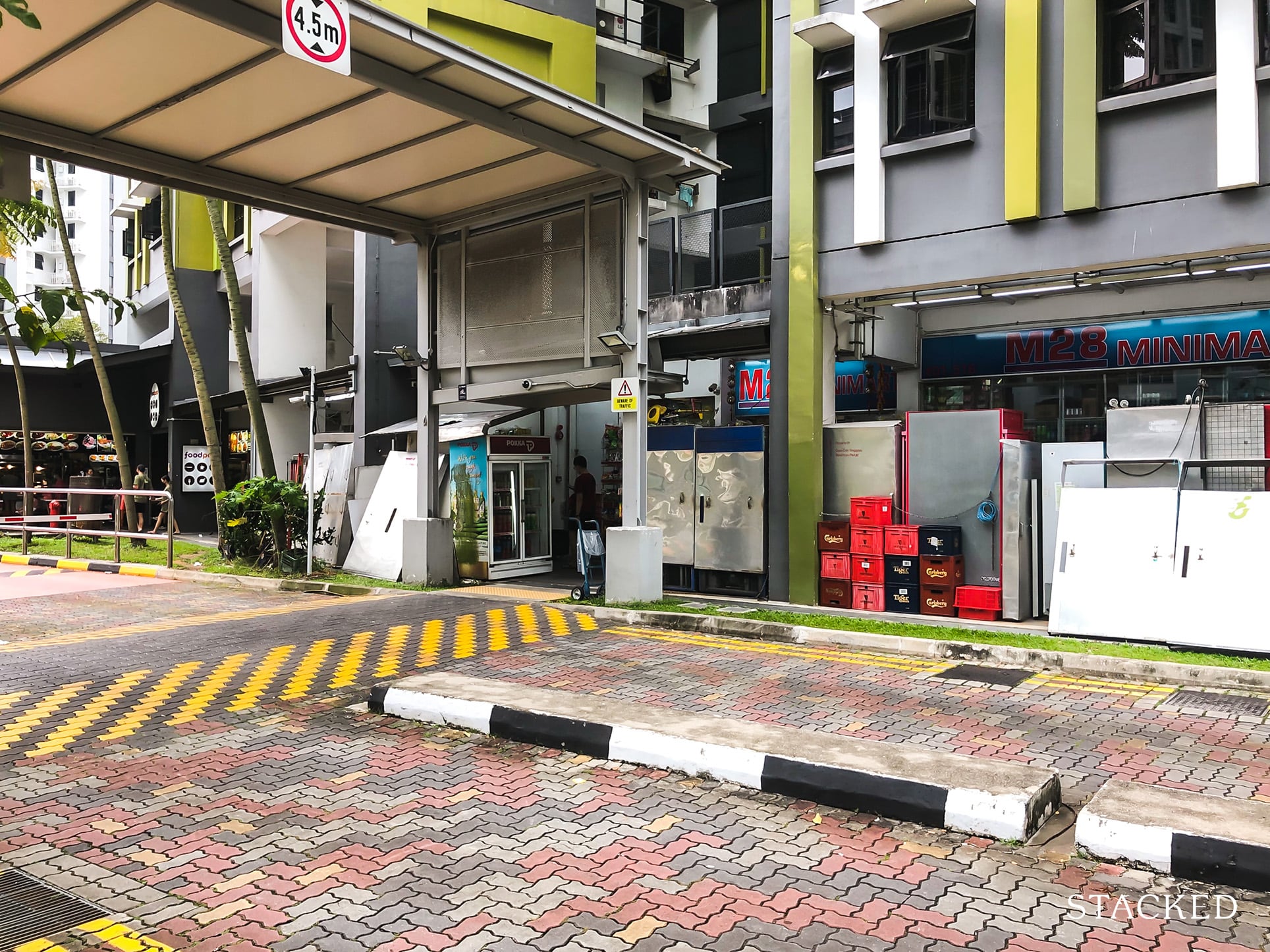
Nearby supermarket, food options and other amenities
- Sheng Siong, located at block 547
- Sheng Siong and Giant is located at Fajar Shopping Centre
- The Closest Coffee shops are located at blocks 485 and 547
Polyclinic
- Bukit Panjang Polyclinic is located along Senja Road
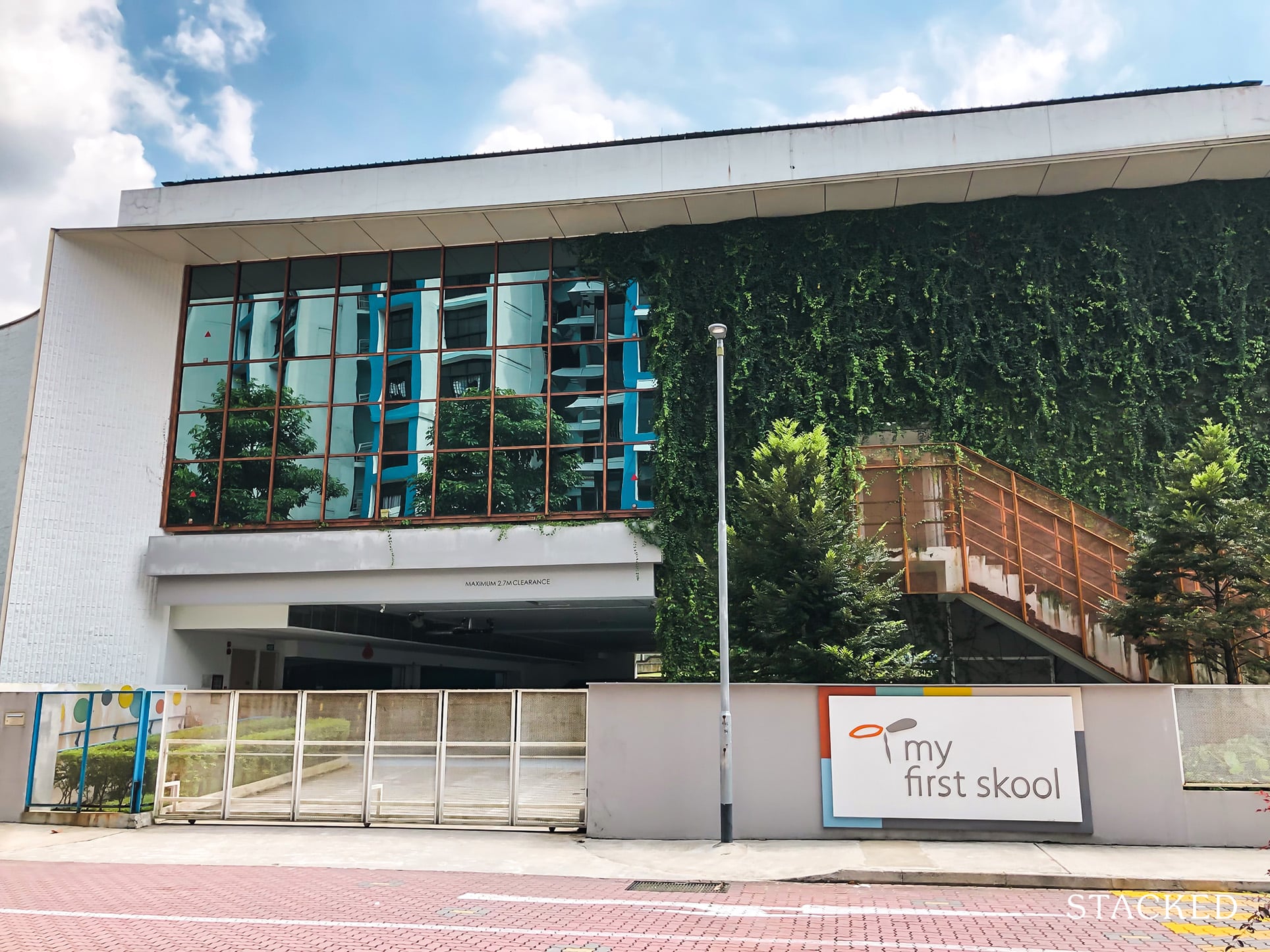
Preschool
- My First Skool located next to Block 485
Step 6: Check the development itself
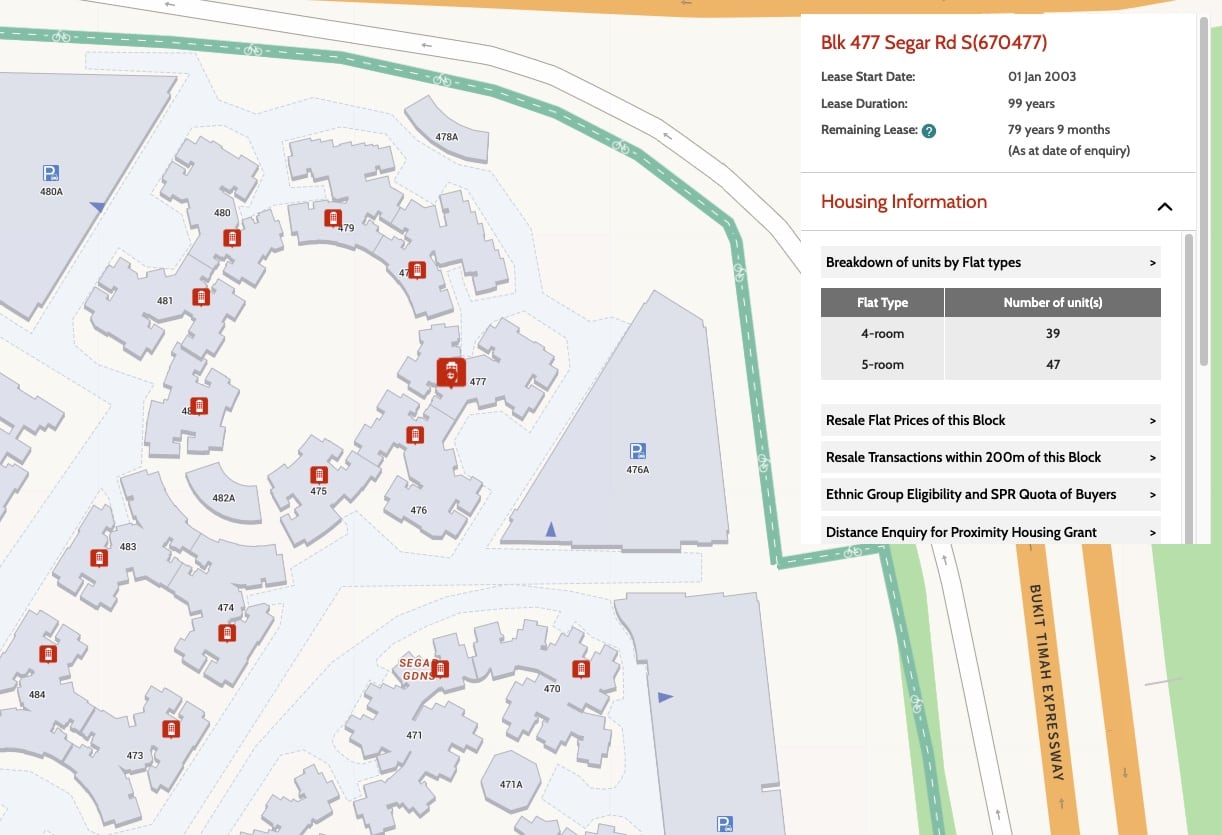
Look for the total number of flats in the development.
- In this example, you can see the number of units, as well as the unit mix, in an individual block
- The development consists of 4-, 5- and executive flats.
Why is the total number of units important? Density – you’ll need to know just how crowded the development really is.
This could determine just how crowded the facilities or lifts are.
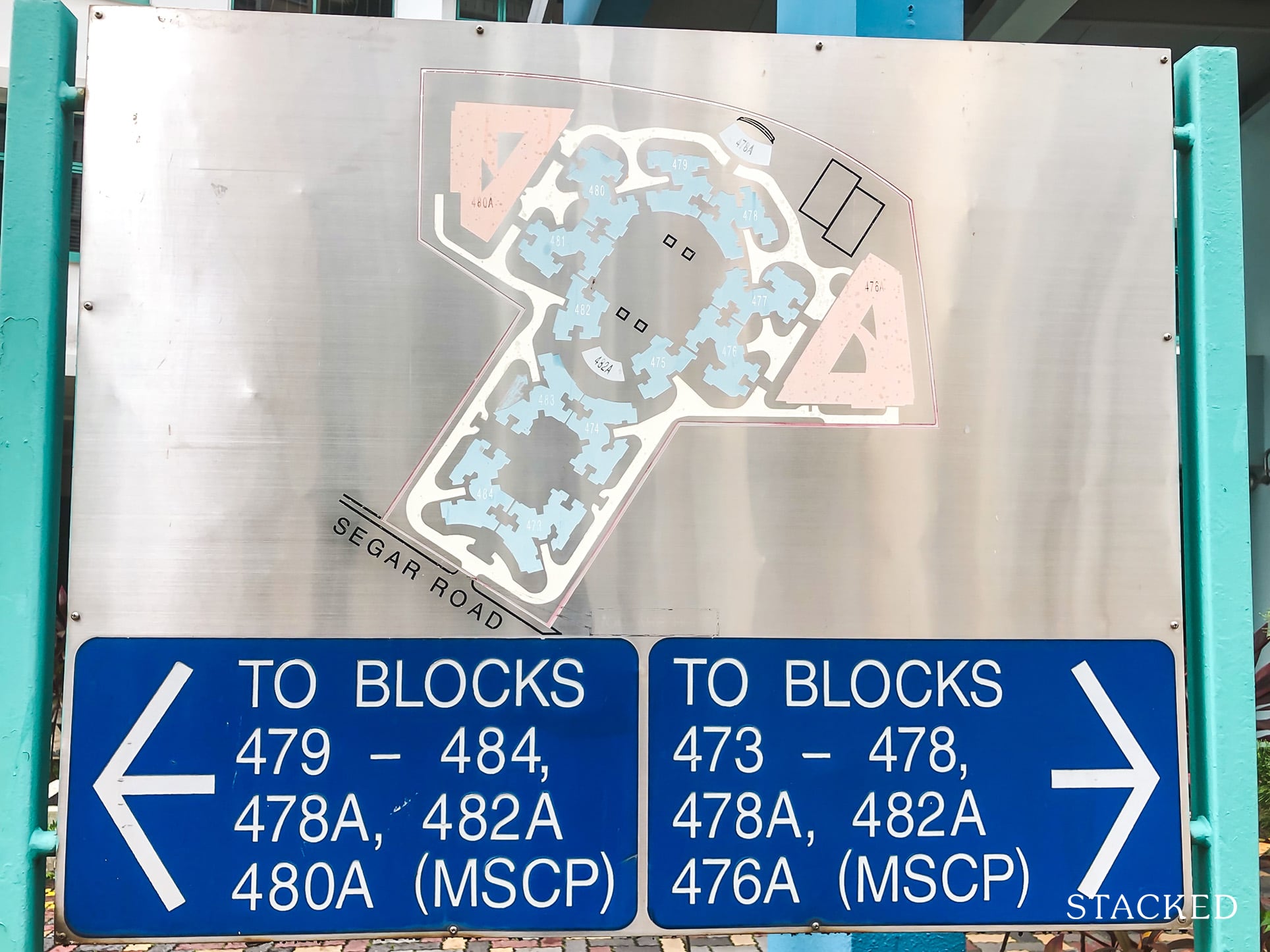
And if you can find it, check out the development site plan. Older HDBs such as the one here would not have an online version, but if you’re looking at relatively new HDBs, getting the online site plan shouldn’t be an issue. You can refer to BTO HQ or TeoAlida’s page as a very good resource.
So what should you take note of when it comes to the site plan?

Check out the playground, fitness area, and garden.
- Check the overall state of maintenance
- See if the playground has been updated, or is one of the older ones (the newer ones are generally safer)
- Check the level of activity in the playground. Ideally, you want it to be an active hotspot, rather than being isolated places*
- Check the number of playgrounds – the more the merrier since it spreads the noise across the development and implies more variety for kids
- Check that it’s not next to a service road, or if it is, it has safety barriers
- If you’re one to bring the kids often, it’s an added bonus to have sheltered seating nearby
*While it’s not always true, playgrounds that are out of sight are sometimes host to teens skipping school, smoking, etc. This has become much less frequent in recent years though
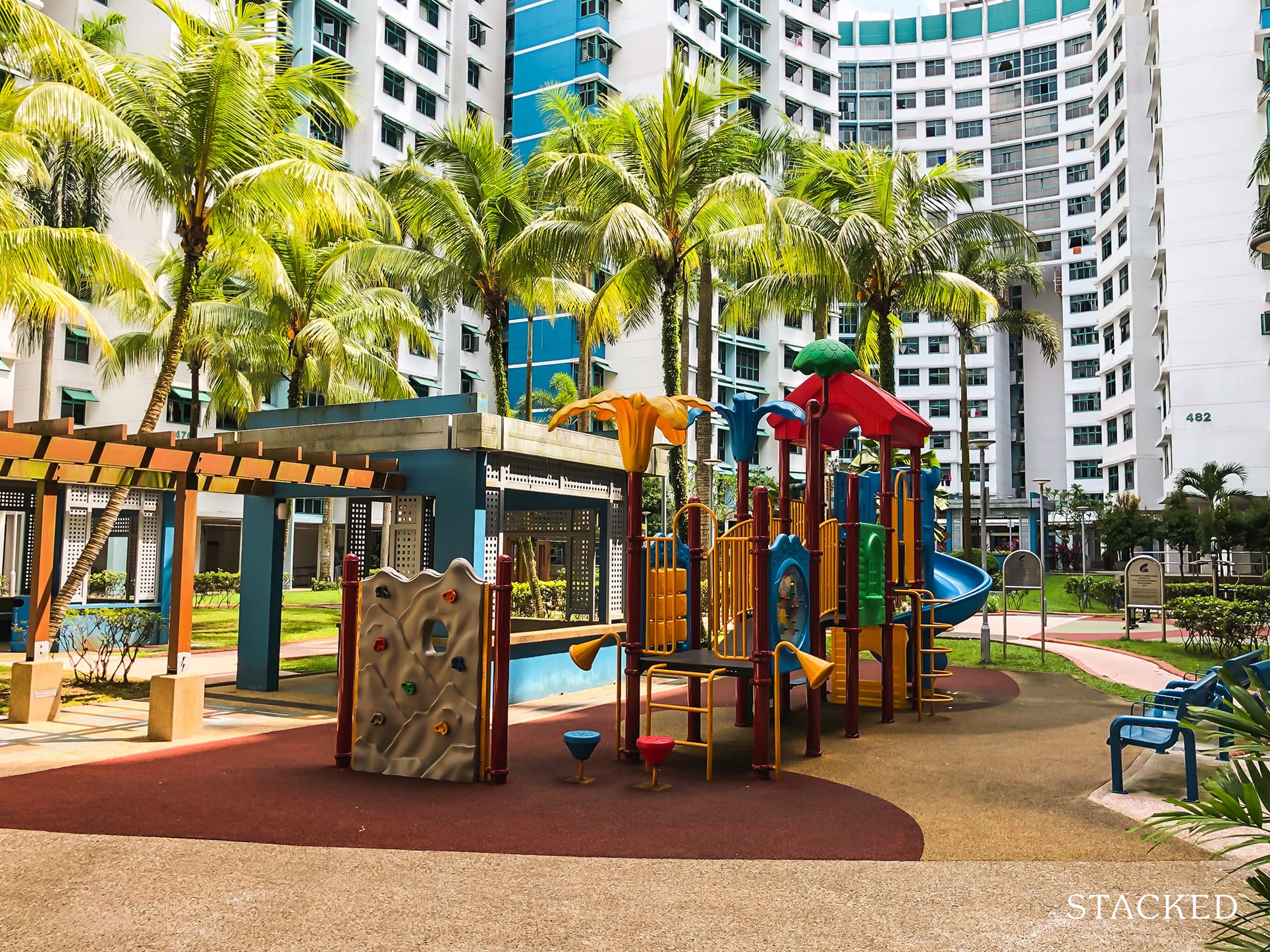
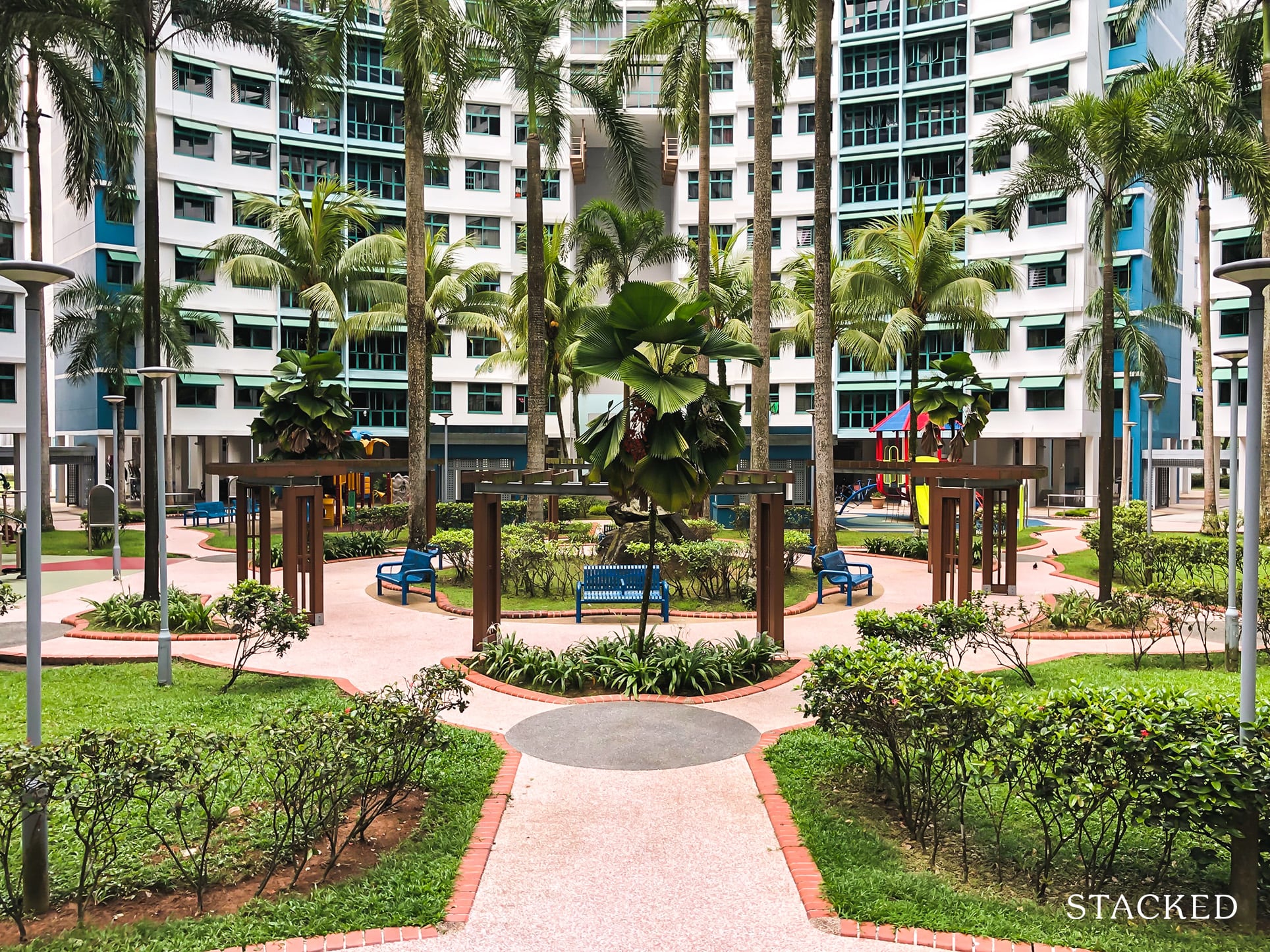
Location of precinct pavilion
- This is where a lot of communal activities or celebrations take place. Units close to it may face some noise occasionally.
- Does it have electrical points or fans?
- Does it have seating?
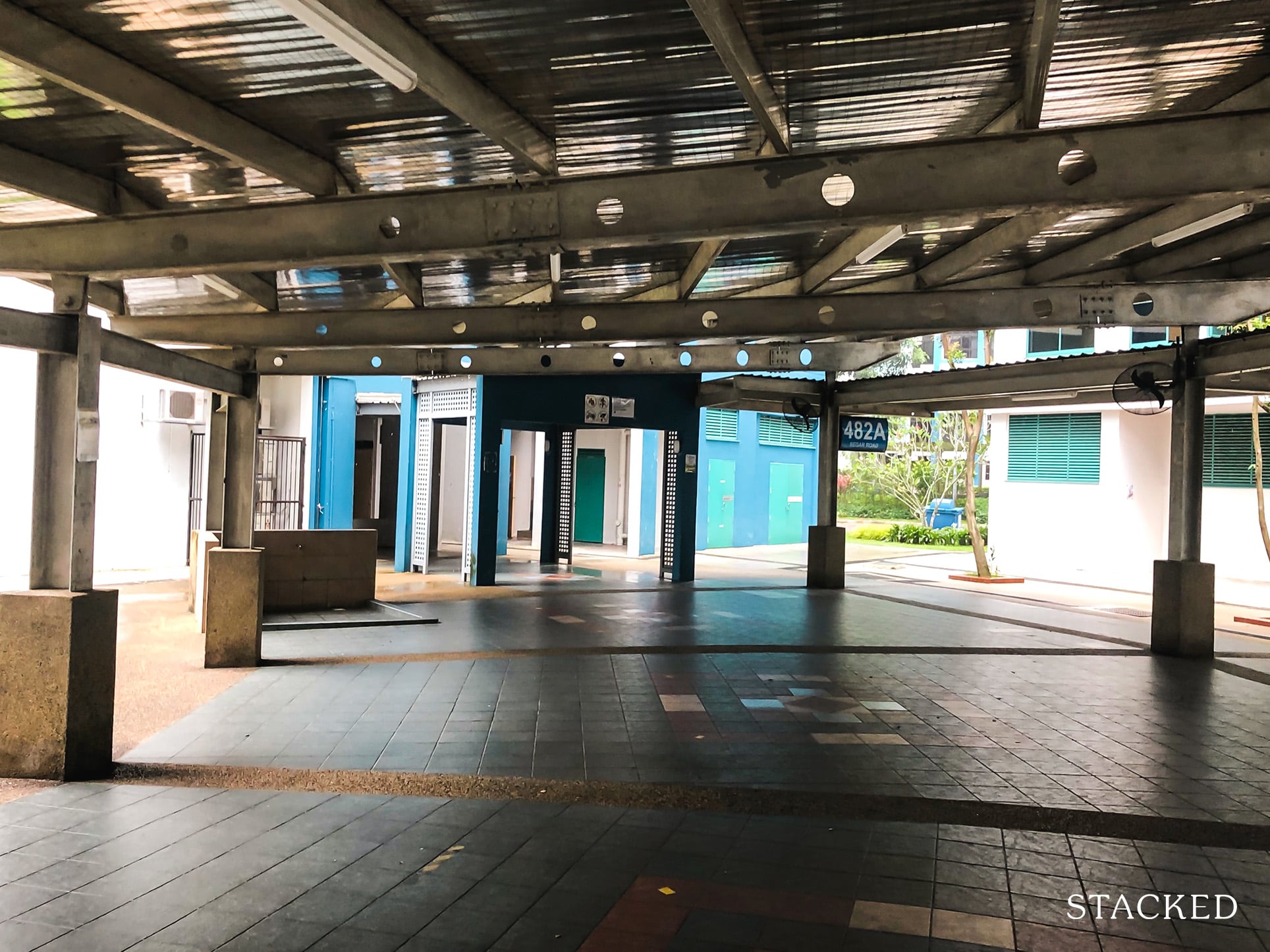
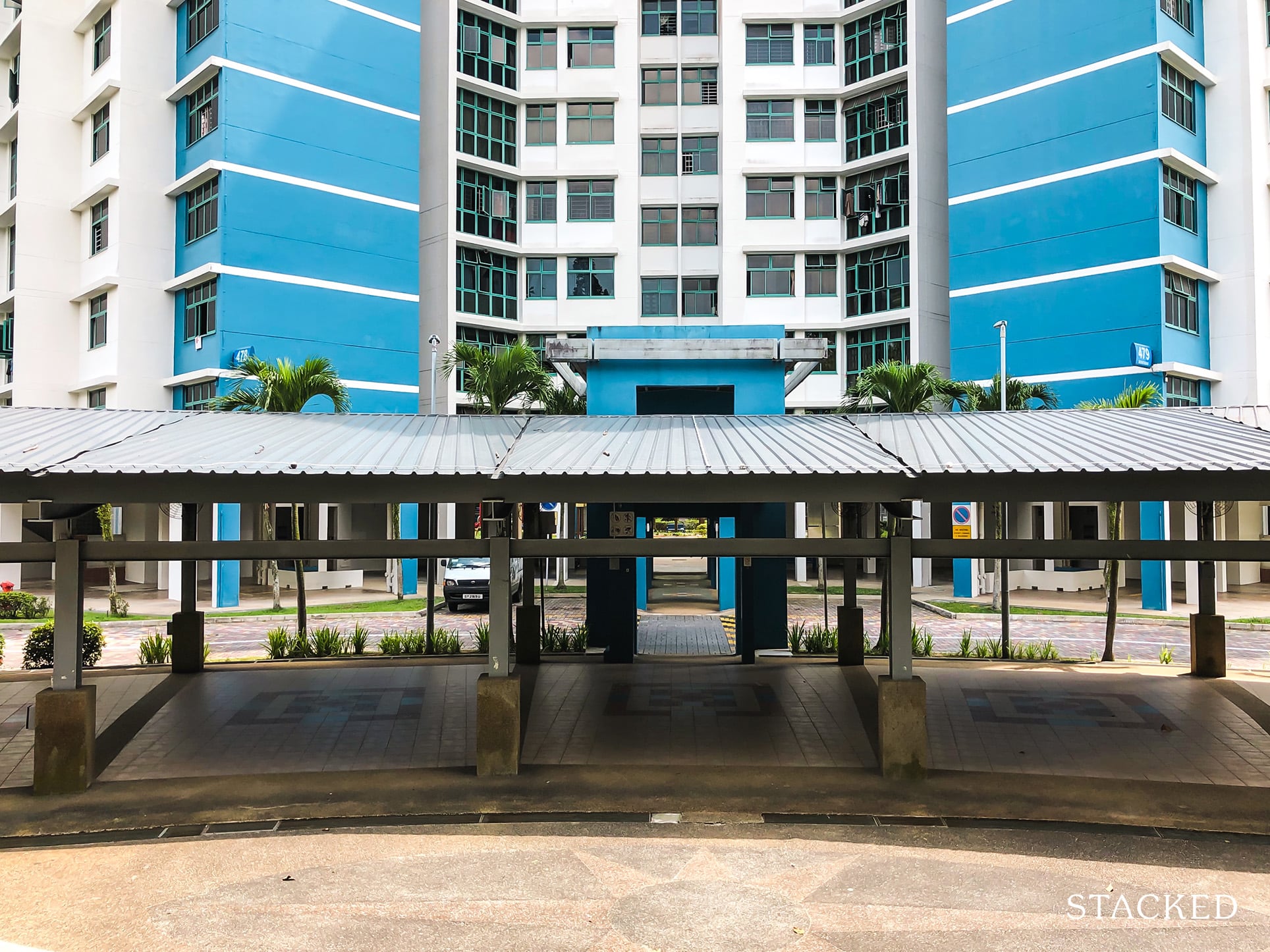
In this example, the unit is located away from the precinct pavilions, located at blocks 475 and 479 respectively.
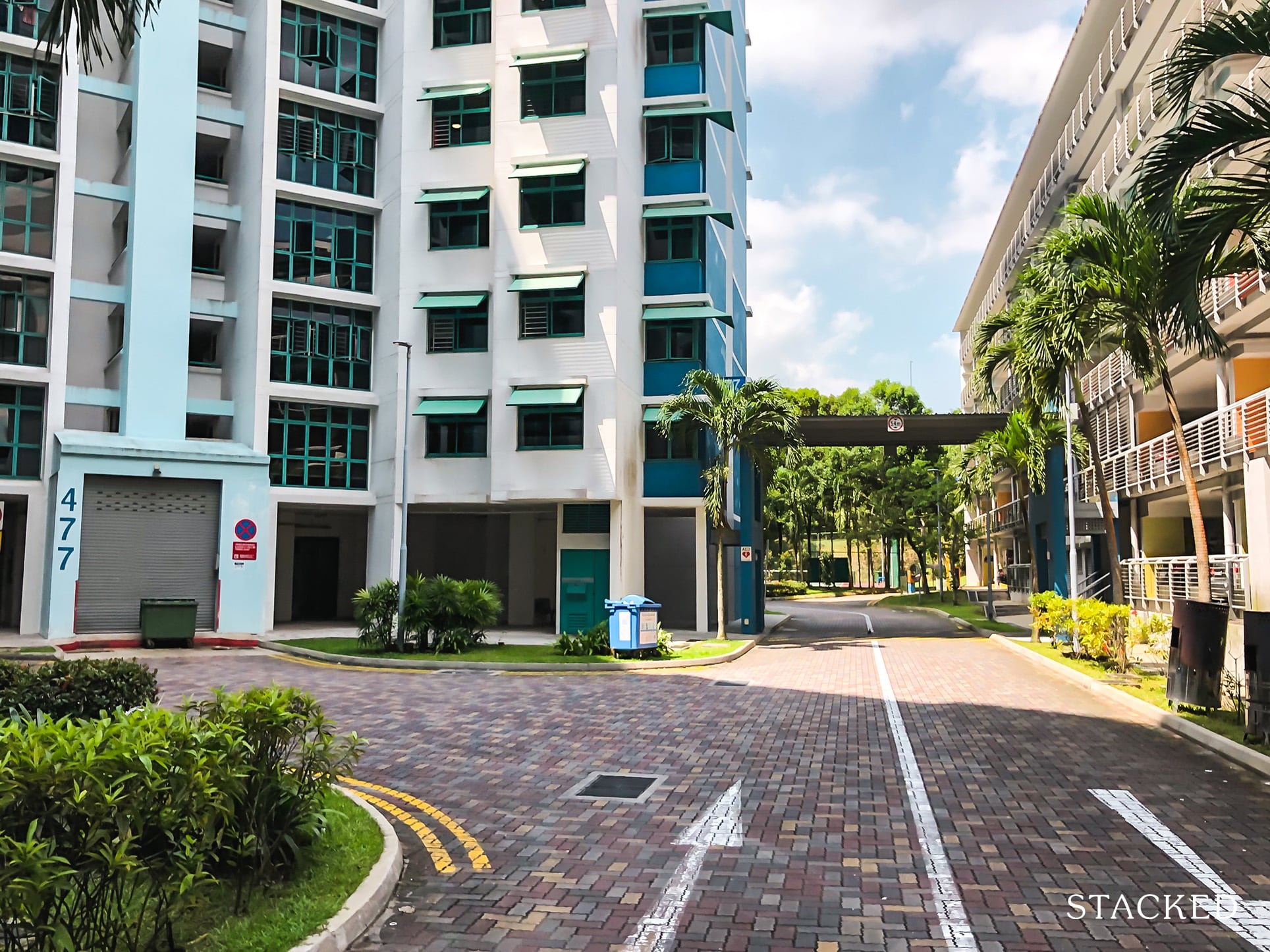
Location of the burning bins
- Is it right outside your unit?
- How many are there in the development?
The photo above shows the burning bins outside the MSCP. This faces some units directly. Depending on the wind speed and direction, it’s likely residents here have to tolerate lots of smoke during the Hungry Ghost period. Bins are usually scattered around each block to make it convenient for residents to access them, but some developments put them in specific spots. Check if your unit in question has one nearby. If all the bins for the development are located right outside your unit, then you’ll be getting more than your fair share of pollution.
Carpark location
- Is it a sheltered walk to the block?
- Does it have a link bridge? This is important when you end up having to park on upper floors as you’d have to take the extra step of going to the ground level to get to your block.
In this instance, Block 477 is connected directly to MSCP Block 476A.
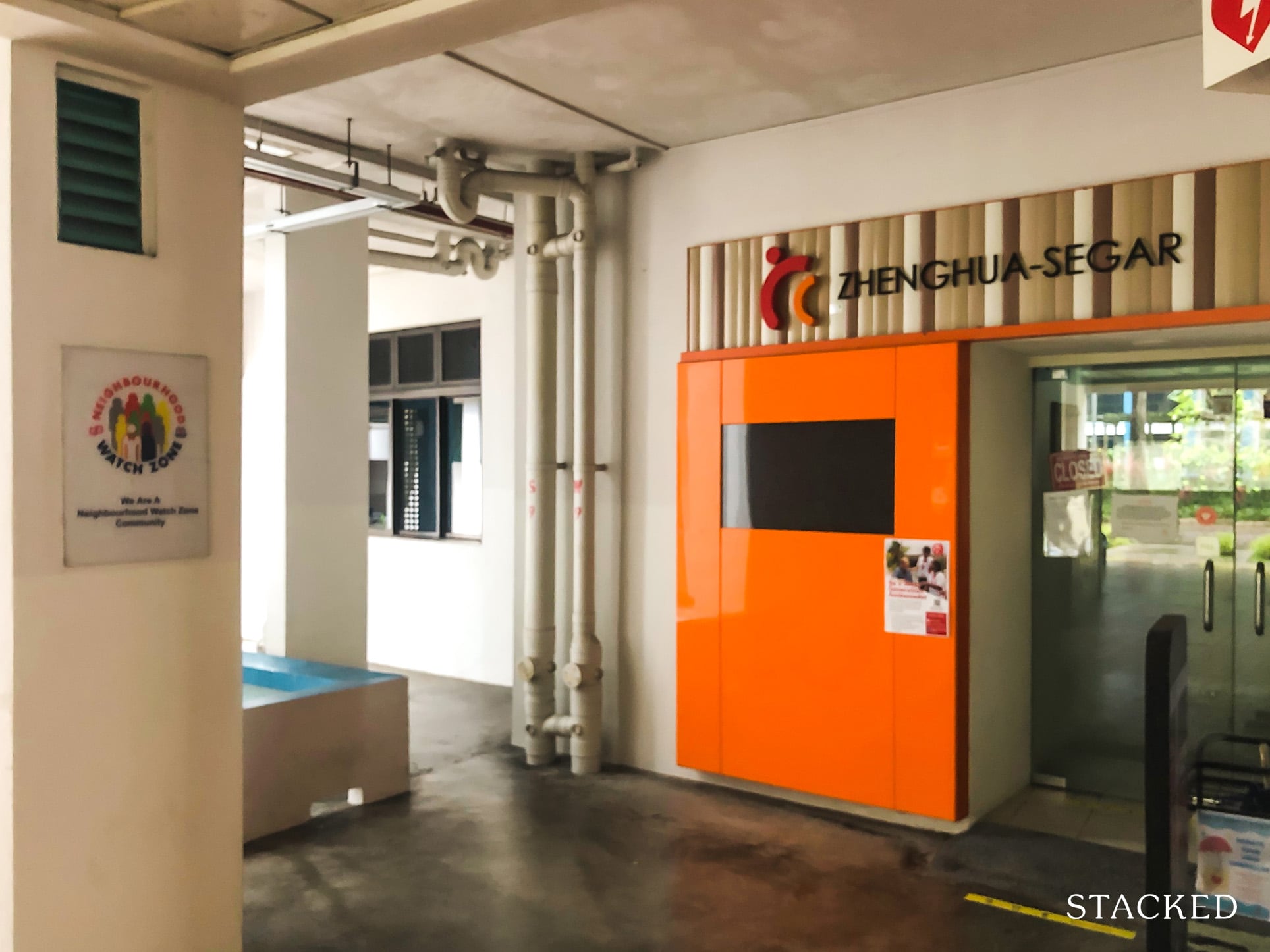
At this block the Residents’ Centre is located at level one of Block 475, this is a small bonus.
Unique facilities
Not all HDBs are the same for sure. Some developments may have facilities that align with your hobbies, if so, it just increases the livability of the place. Even if the facility is not within the development, being near a park or an area with these facilities counts as HDB facilities are not exclusive anyway.
- This HDB development has a tennis court, which is quite unusual and definitely a plus
- There’s also a basketball court
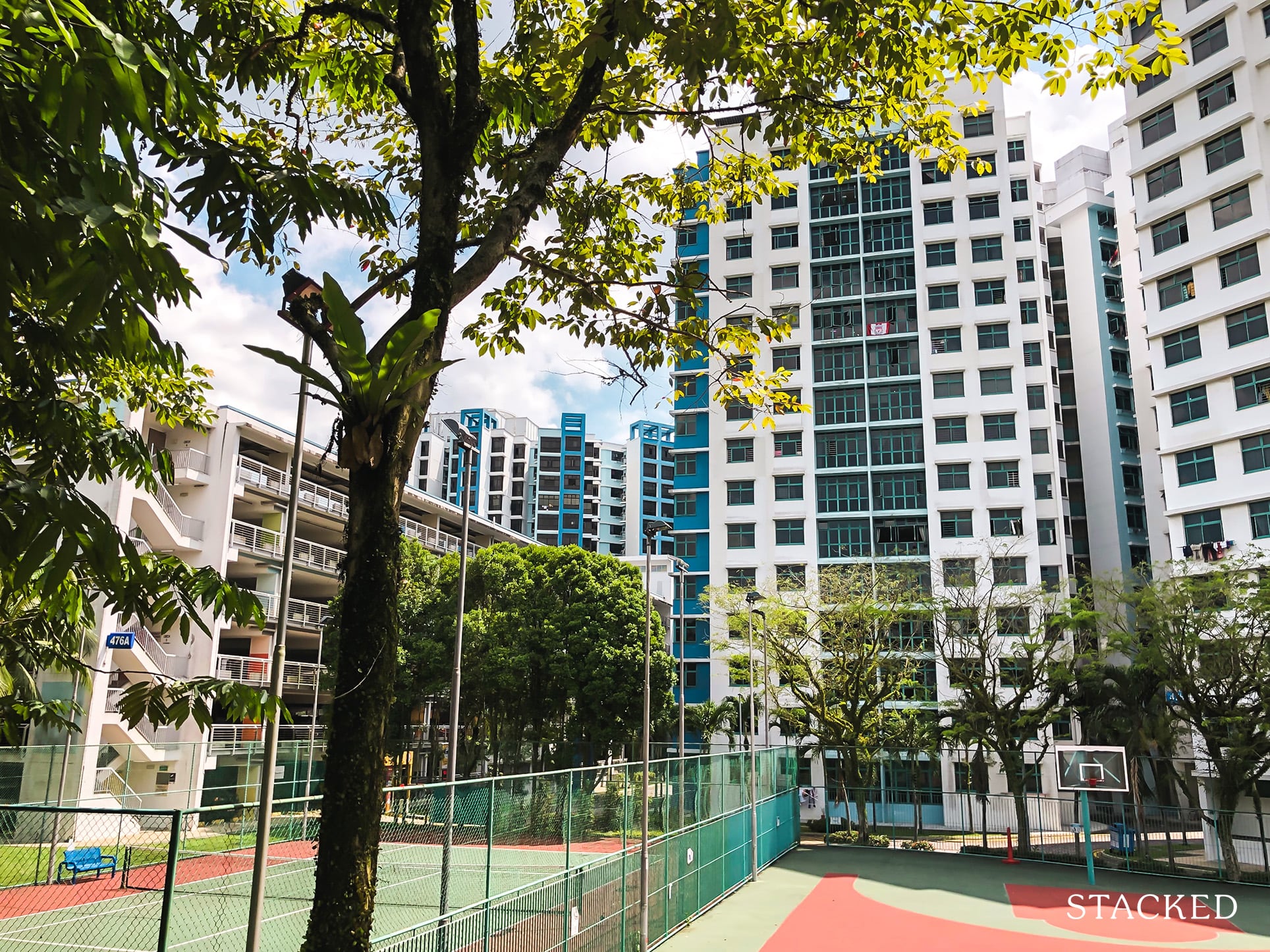
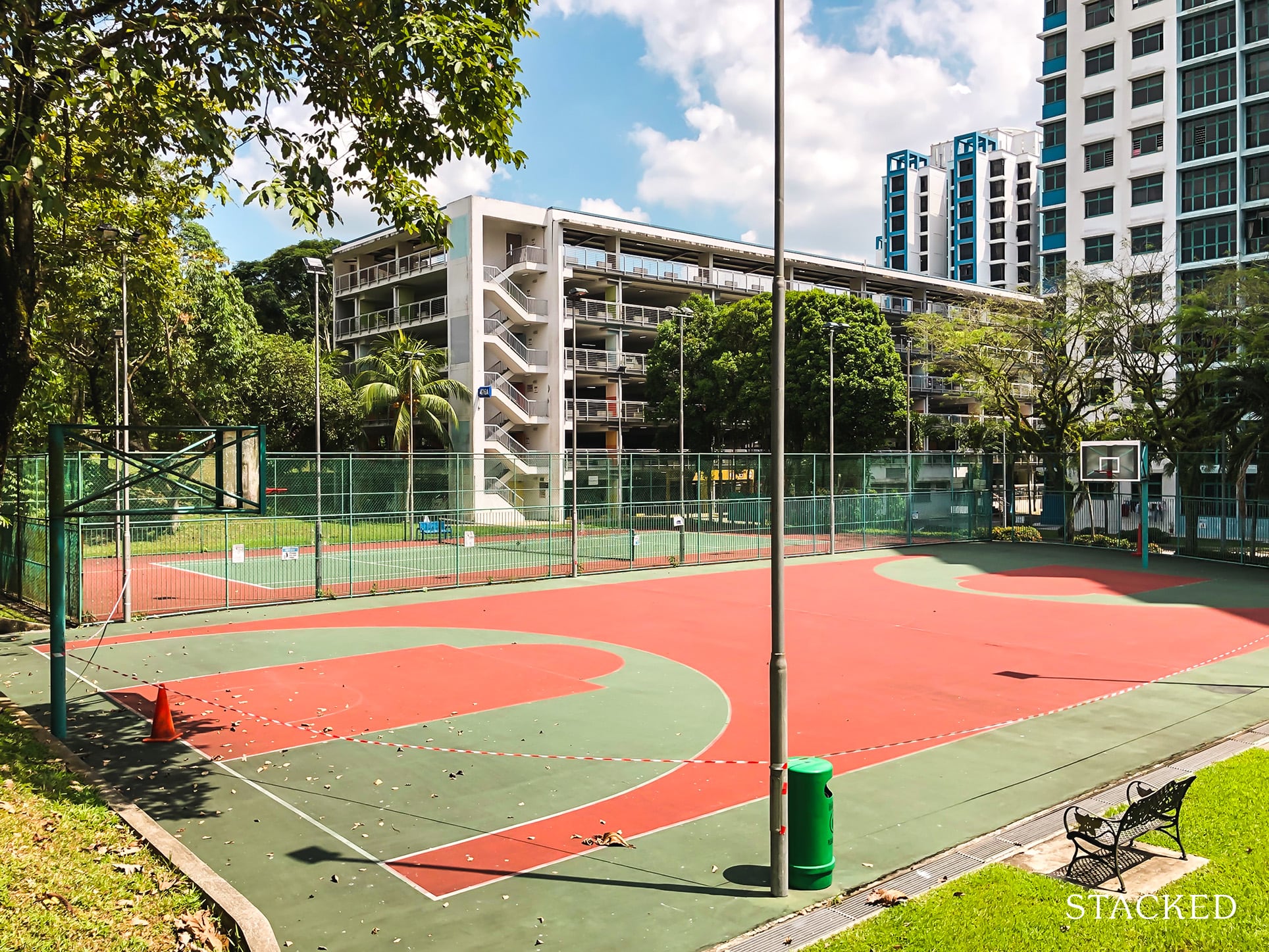
BBQ Pit
This is quite a common feature in DBSS, but not so much for HDBs. So having one is great, which this HDB development has.
- Located next to the basketball court and precinct pavilion in this example, which makes sense
- It could be cleaner though…
- Has some seating, but could do with tables
- Lacks shelter
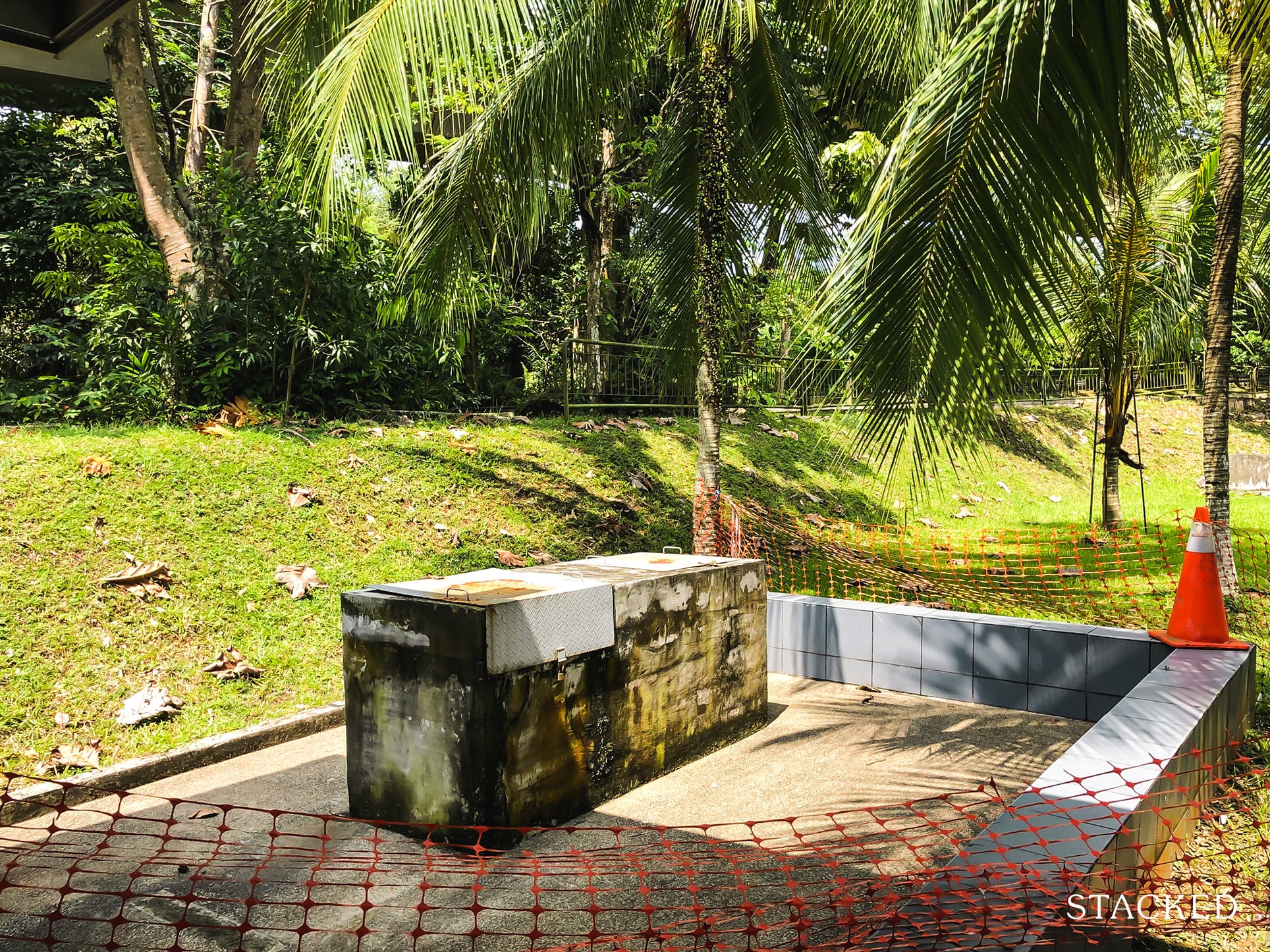
Park Connector
- Direct connectivity to Zhenghua Park Connector Network, from the back of the development
- Park Connectors are especially helpful to homeowners who cycle and can provide a whole new form of accessibility
- It also makes it easy to bring your kids out for some healthy and fun activities
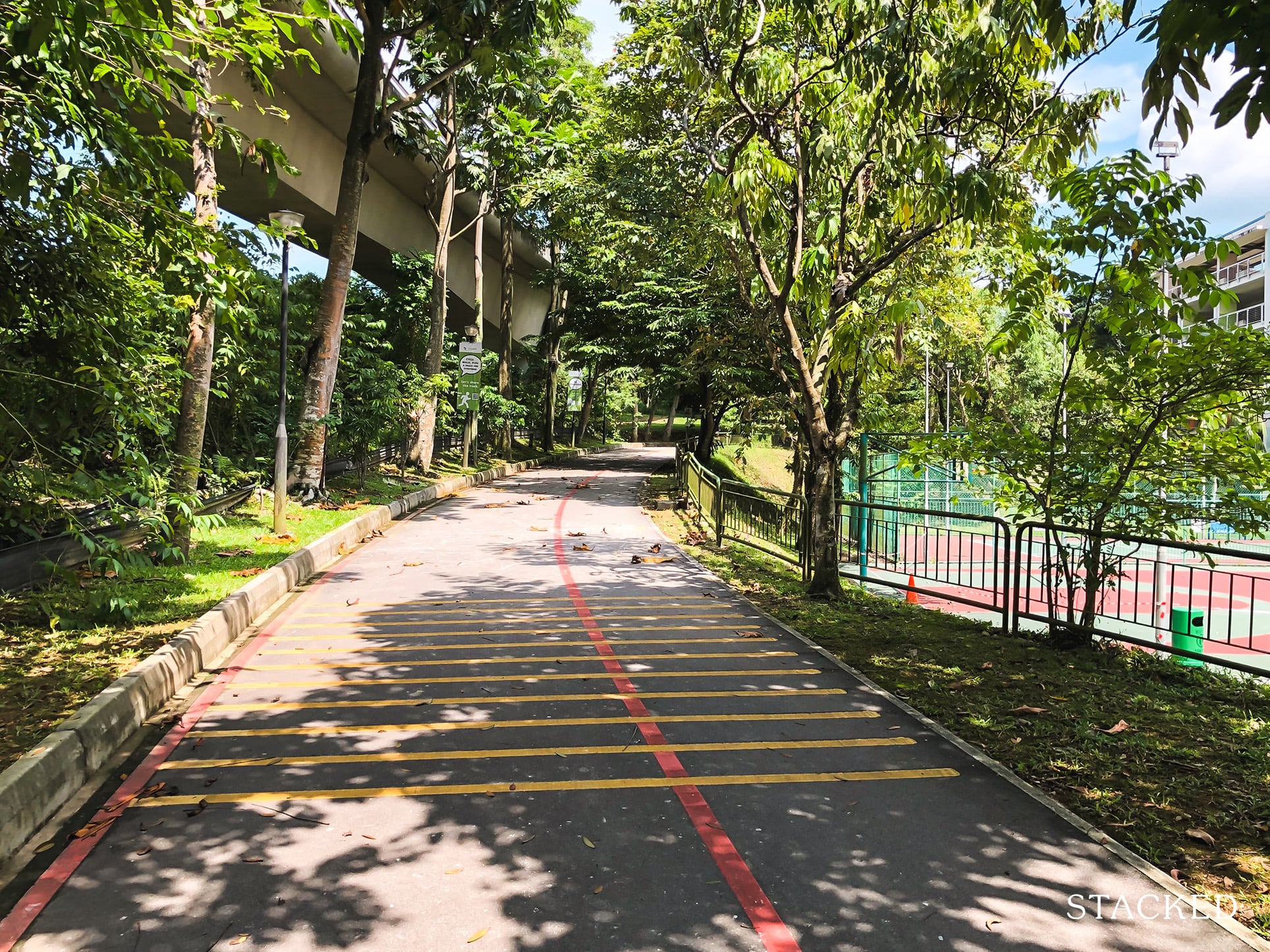
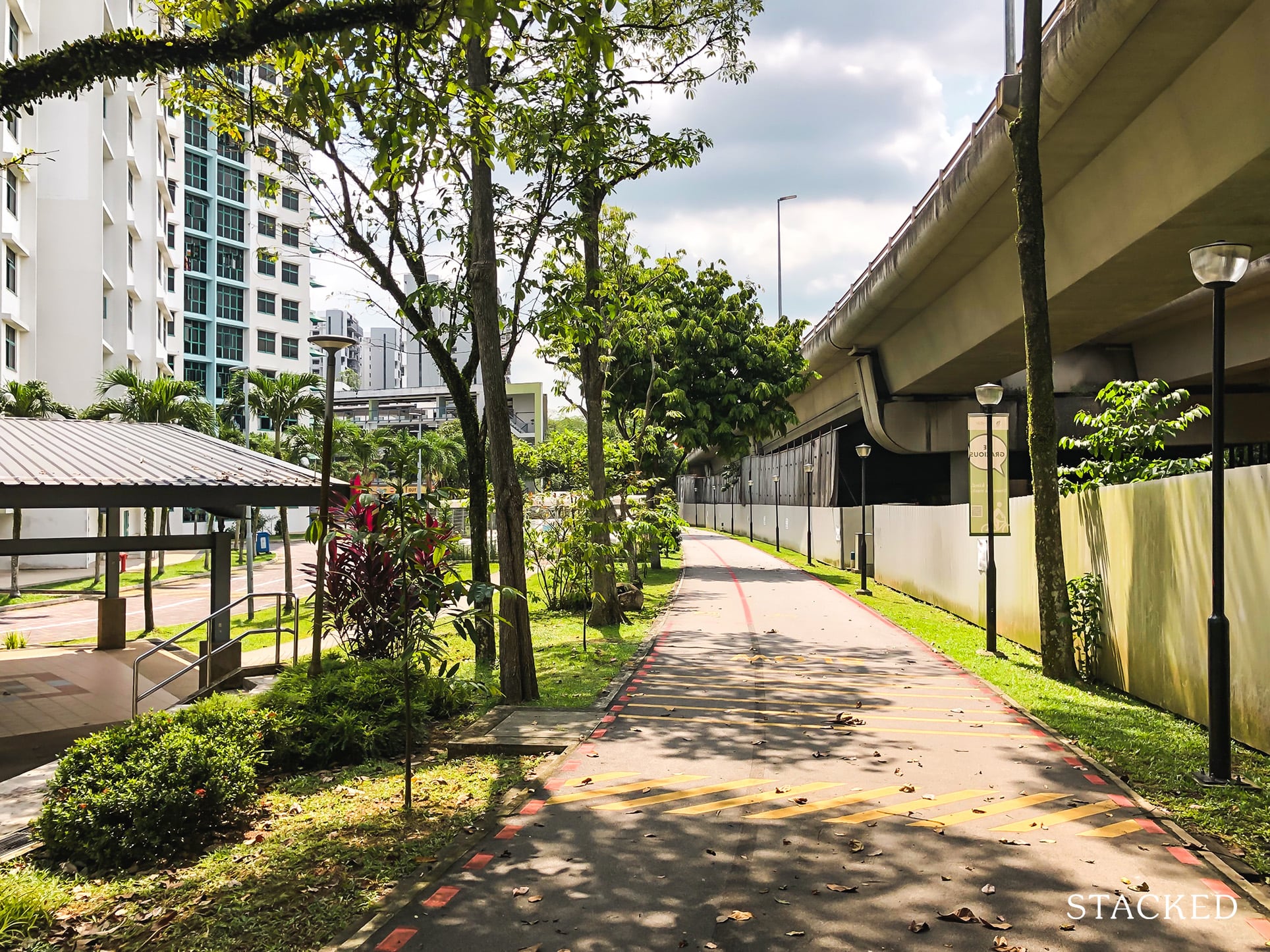
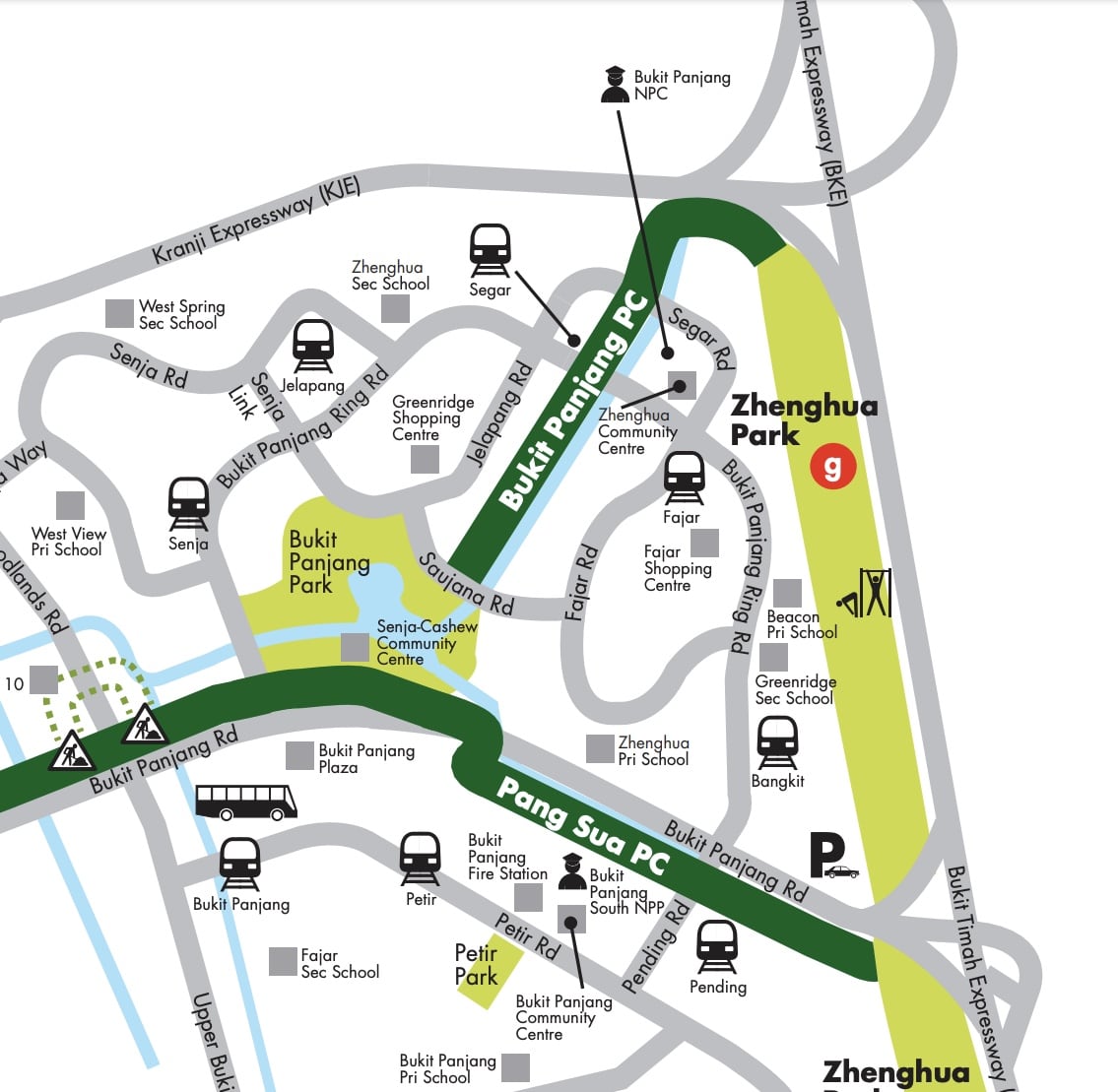
Proximity to major roads and expressways
In this example, the development is flanked by two major expressways, the KJE and BKE. Certain stacks may face traffic noise.
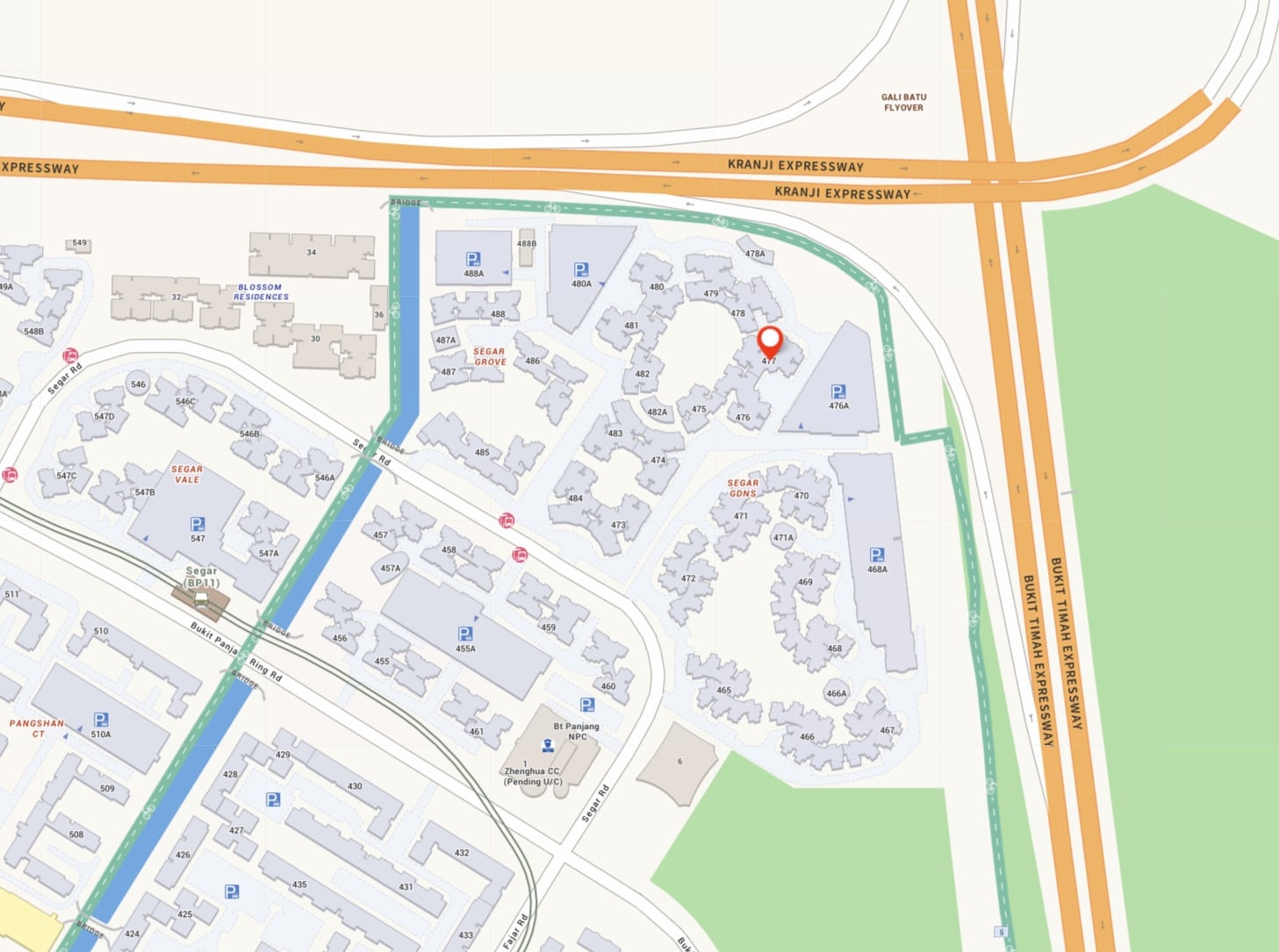
Bear in mind that higher floors tend to receive more noise as they have fewer sound barriers (other buildings/trees).
Bicycle Racks
Being next to a park connector means you can easily enjoy cycling as a leisurely sport, however, a lack of bicycle racks here can be a stumbling point. This problem is exacerbated if the common corridor lacks space which means you’ll need to bring it indoors – resulting in a need for spatial planning and it may not be as desirable as it does mean bringing outside dirt into your home.
Step 7: Do an analysis of the block in question
Check the density
Using block 477 as an example, you’ll find that there are 86 units with a mix of both 4 and 5-room flats.

A block comprising mostly 3 and 4 room flats would be less dense than one with 4 and 5 room flats. Knowing the number of units and number of lifts is also helpful – a block with over 200 units sharing 3 lifts would be more frustrating at times as opposed to 100 units sharing 3 lifts because you’d likely be sharing the lift with others quite often, or having to wait for a full lift to by you as you wait your turn.
If lift waiting time is a consideration, you may not want to stay in a very tall development too – especially if there are many units per floor. SkyVille@Dawson is notorious for its lift waiting times, with 8 units per floor sharing 4 floors over 40 storeys high – some residents have to wait up to 15 minutes just to take the lift down during peak hours.
Imagine staying on the 15th floor. You press for the lift and it goes up from level 1 but passes you. It goes to level 39, stops there, goes to 34, stops there, goes to 22, stops there and finally when it reaches you, the lift is full. How frustrating is that?
One way to check for this is to read Google reviews of the HDB development. If there’s anything people like to complain about, it’s having to wait, so if it really is an issue, Google Reviews would surface them:
In block 477’s case, we have two lifts, with six units per level which is all right. Some HDBs have 3 lifts catering to 4 units per floor which is better.
Next, check out the lift lobby. In block 477’s case, it’s quite a decent-looking one. More lifts are better if you can get them though, as it’s sometimes possible that both lifts are down, or one lift is down while the other is being used by people moving house (But then again, if you’re seriously unlucky, even four lifts can all fail).
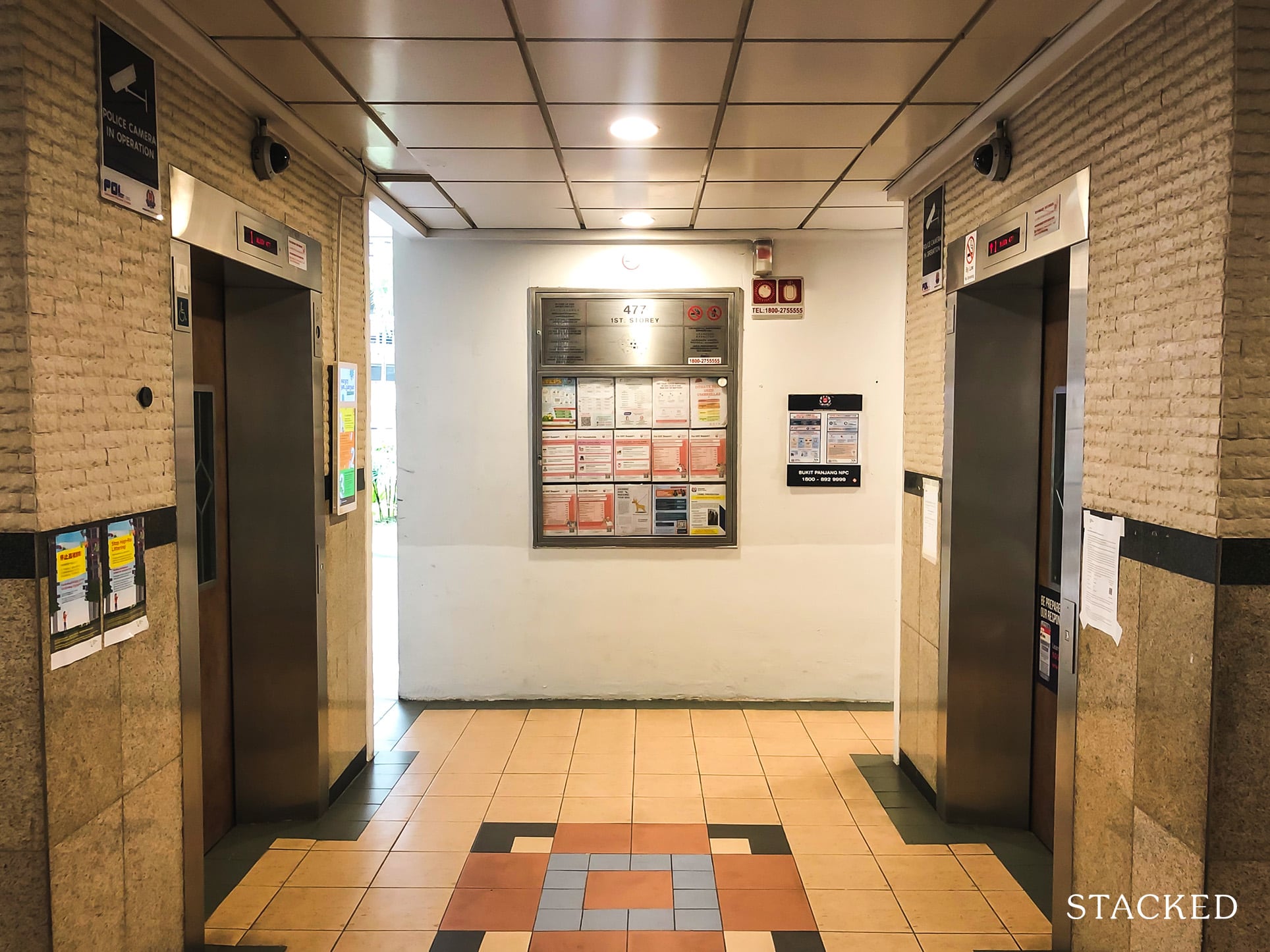
Privacy along the corridor
Does the main door face another unit directly? This may feel a bit invasive.
Here, there are three units on one side (Stack 406, 408 and 410)
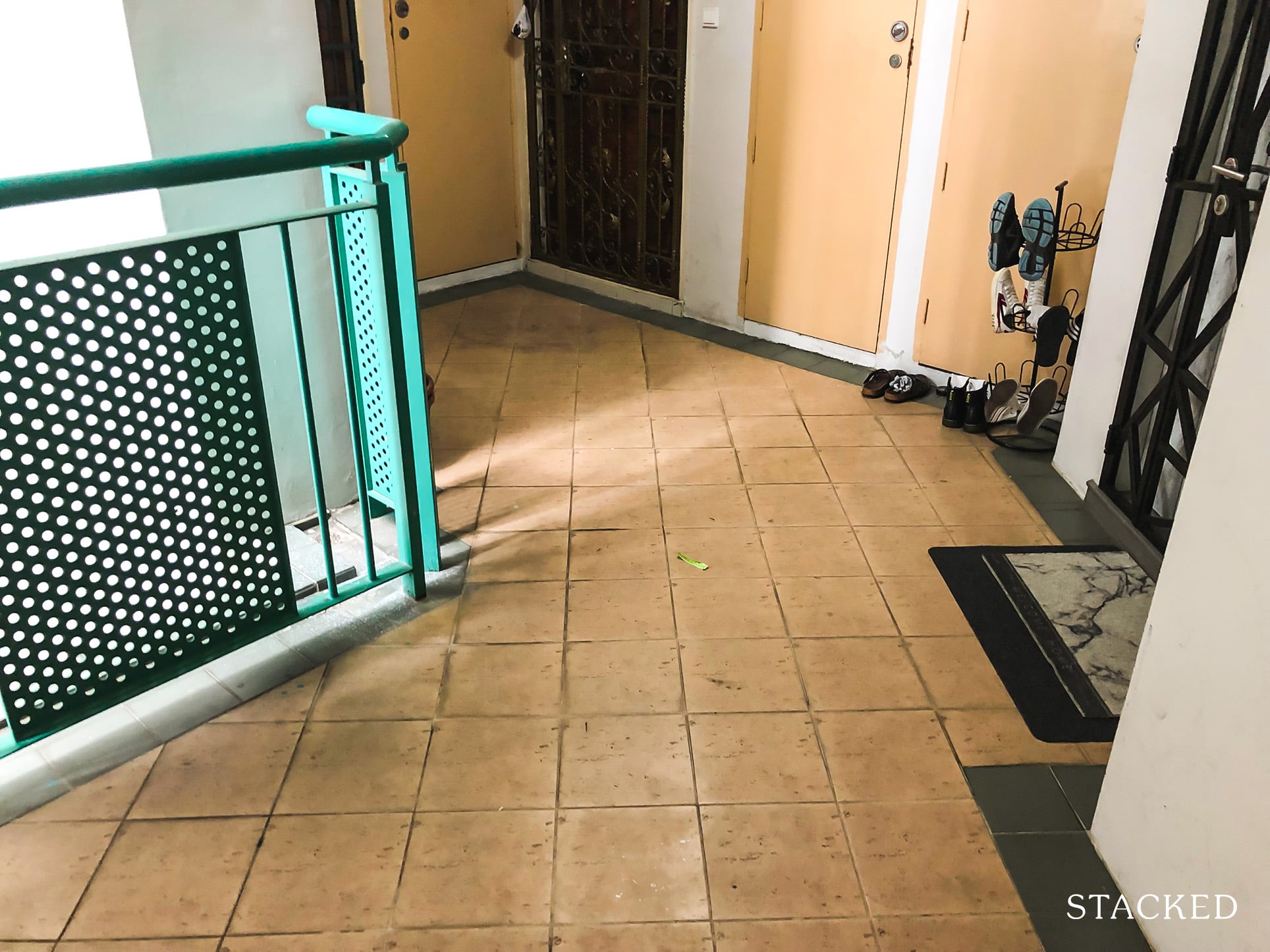
Stack 400 is on its own, but…

Stack 402 and 404 face one another. This may create some conflict when it comes to using the shared space in front of the unit, so you might want to think about that.
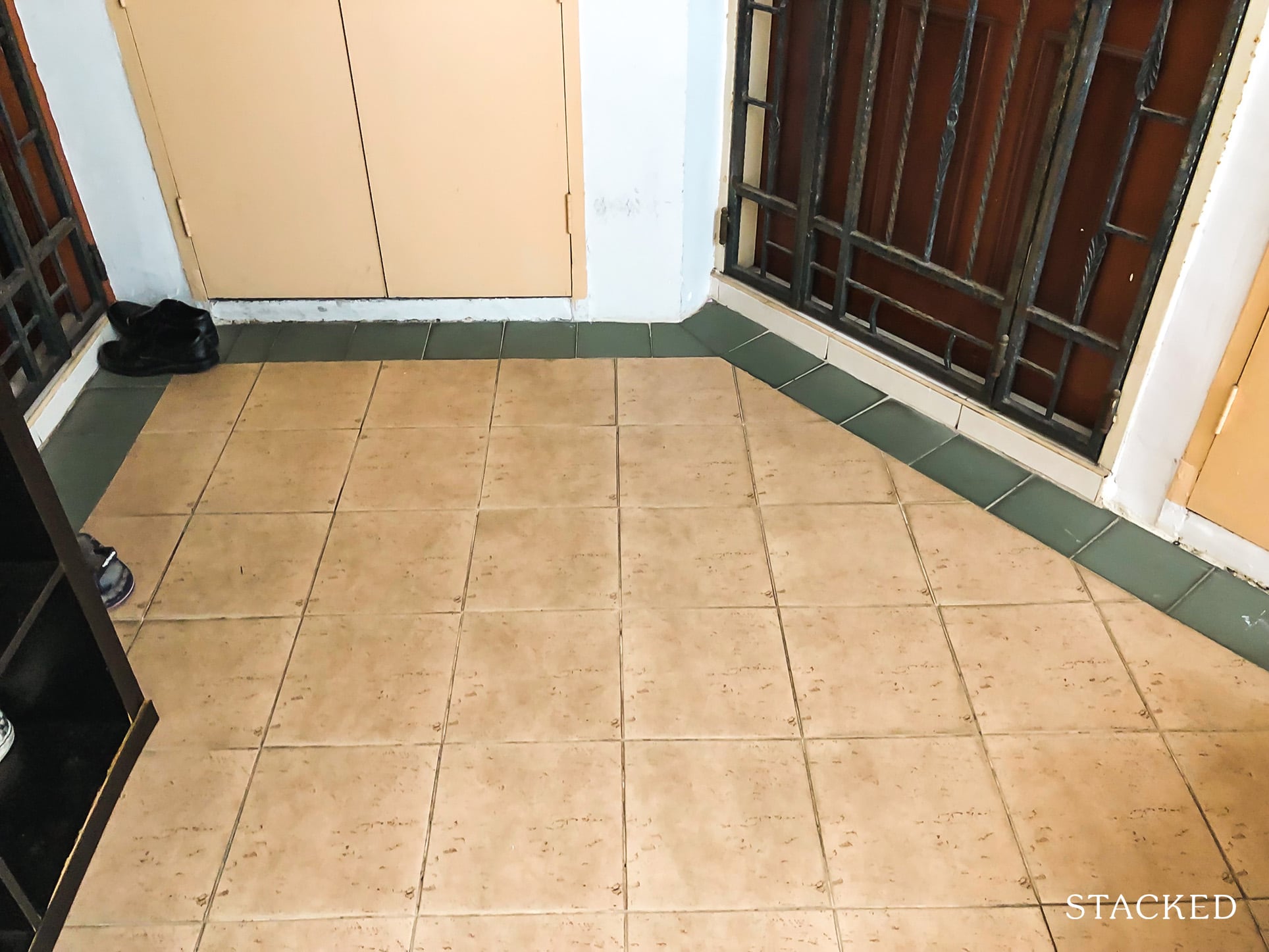
Usually, block plans can be found in lift lobbies. For newer flats, you should be able to find them in the full BTO brochure.
Refuse location
- If there is a communal refuse collection point, is it too near your unit?
- Is there a recycling chute?
It may be important to you that a recycling chute is present. This is more common in newer HDBs than in older ones. Having the chute right outside your development increases your odds of receiving pests and it also reduces privacy as more people walk past your unit. Future buyers may also dislike being too close to the refuse area.
You’d also want to check for the rubbish chute distance from your unit. For newer developments, it’s a centralised one, but for older ones, it would still be in-unit. Obviously, if you cook a lot, or have a lot of trash to throw out each day, it’ll probably be more ideal to stay closer.
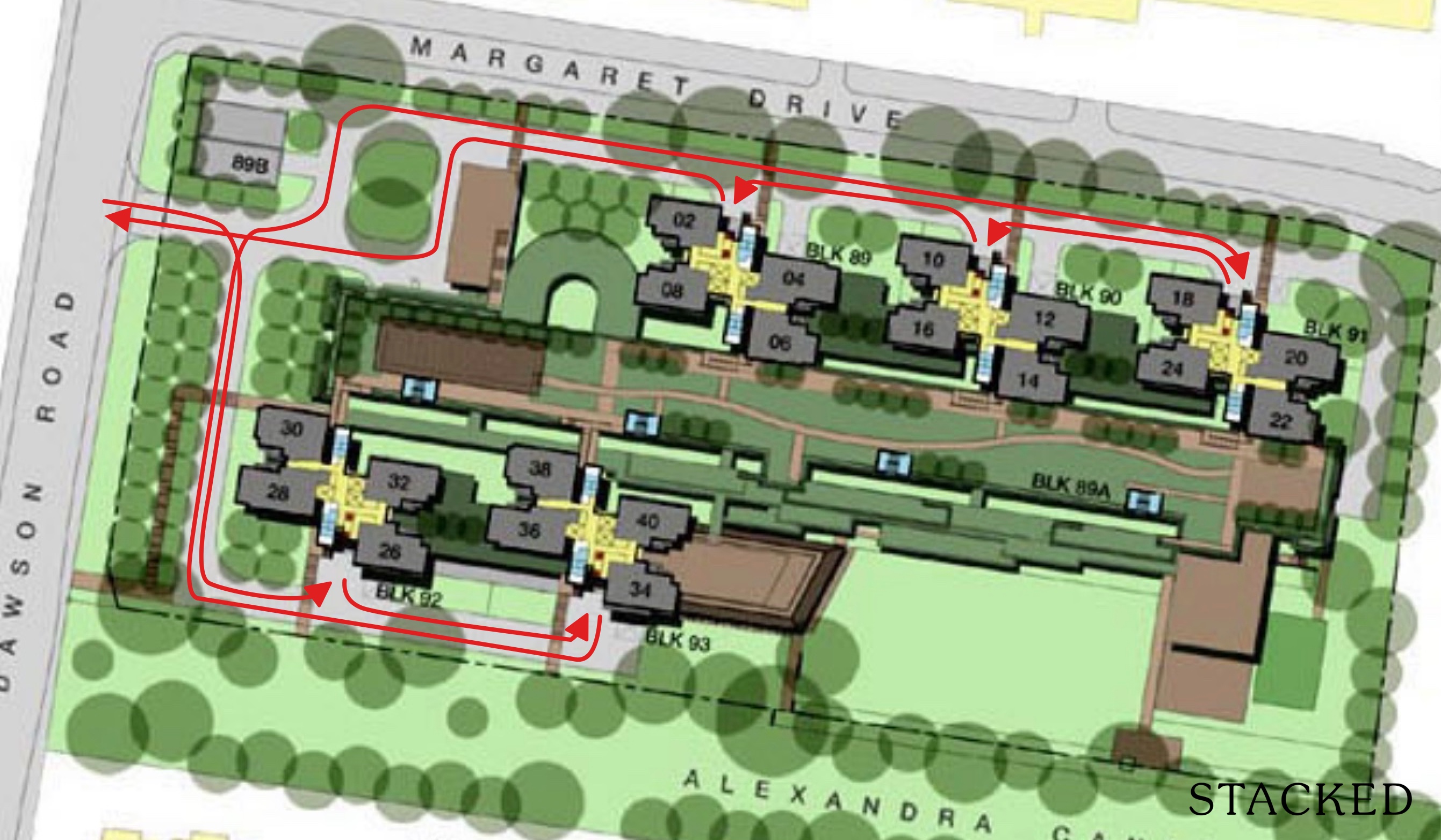
If you are on a lower floor, you should also take note of the refuse centre’s in your block. This is where the rubbish truck will come by to collect the trash, and sometimes being too near can result in undesired noise and smells.
Wheelchair accessibility
- Are there steps within the home?
- Are bathroom doors wide enough for wheelchair accessibility?
Depending on you and your family’s needs, wheelchair accessibility may be a consideration. Do not overlook this point as it could mean a world of a difference to those who need it the most. Check to see if there are steps when getting into the unit. In this instance, the HDB development here (see photo above) does have a step up into the unit, so this could be inconvenient in the future if anyone in the home depends on a wheelchair.
Some HDBs take this into consideration, particularly those with 3Gen flats or those geared towards seniors. Of course, this isn’t just within the block but even getting to the block could be a challenge if the development was built without this in mind.
Corridor width
Another thing to consider is the corridor width. Is it too narrow? Most HDBs tend to steer clear of this problem, as they are more pronounced for certain DBSS. This could be important if the unit is along the common corridor as there is a minimum width needed to be maintained under SCDF’s regulations – meaning if it’s too narrow, you can’t even put a shoe rack outside.
Also, check to see if your unit is next to any electrical unit or risers. Technically, you’re not supposed to block these access points, so these may not be suitable places to put your shoe rack.
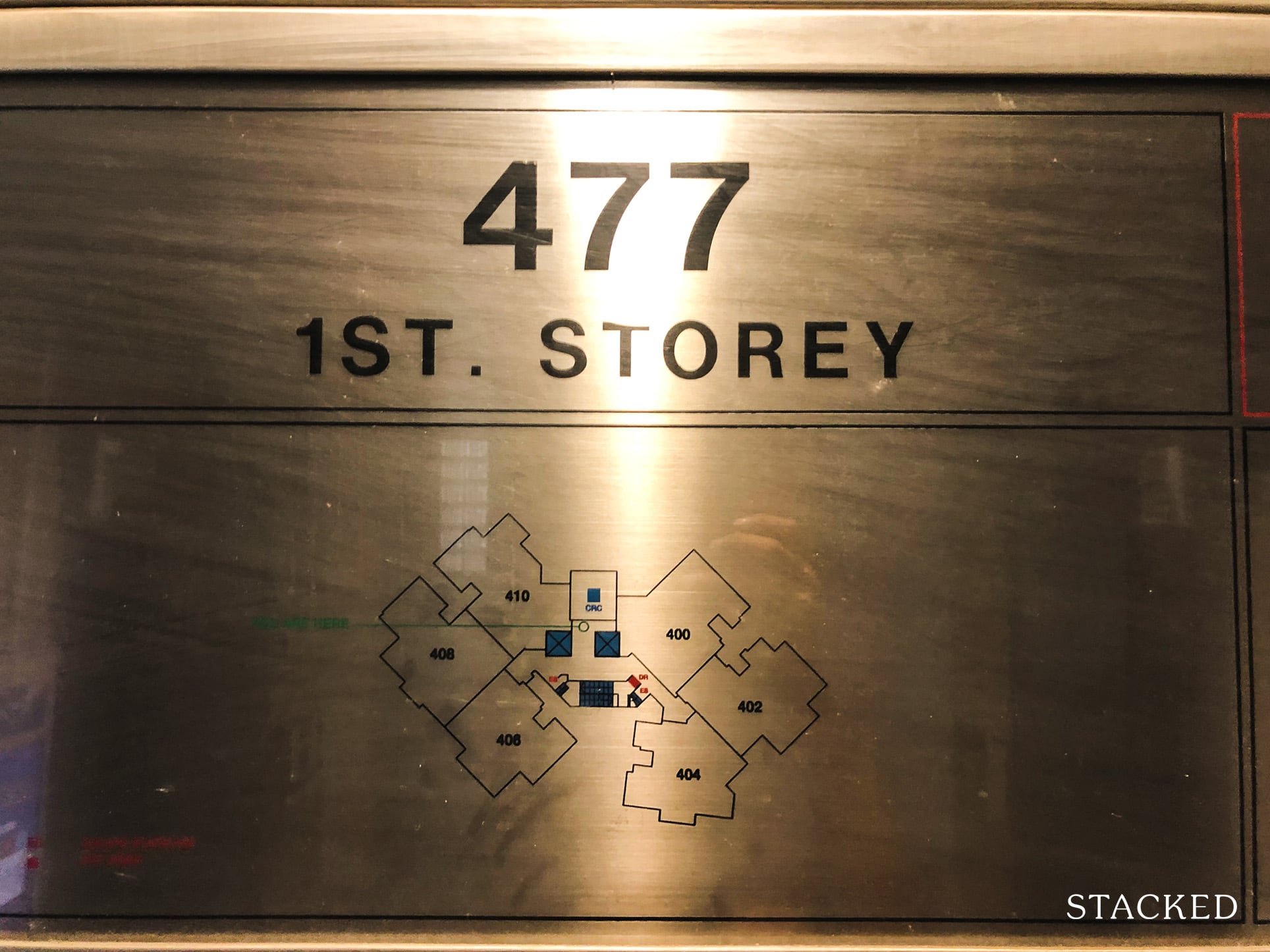
Difficult neighbours
Finally, the last thing to look out for is difficult neighbours. The sellers are not going to tell you directly that the neighbour is a nuisance, but their reaction to the question can sometimes be telling.
Look out for hoarders, as their units tend to be in poorer states of maintenance, and this can affect yours (e.g., mosquito breeding, pest problems). Also look out for loan shark activity, as you don’t want to end up with a “targeted” unit, or wake up to loud shouting because your neighbour owes money.
The usual warning signs are CCTV installations or faded “O$P$” vandalism near the stairwell. Sometimes they don’t paint over the vandalism too well, and you can still make out the marks. Finding a fresh coat of paint that’s only present outside the unit could be one sign too.
If you’re up for it, you can also approach the neighbours and let them know you’re looking to buy in the area, so they can share their thoughts on the place.
This is usually a question that experienced buyers will ask the seller or seller agent. There are cases where living with unreasonable or unbearable neighbours can really sully the experience even if everything else ticks the boxes for you. Unfortunately, that’s all part and parcel of apartment living!
Step 8: Viewing the unit
Here’s what we’d go through when viewing the unit:
We start by asking how many prior owners there have been. In general, the newer the better. In this example, we’re buying from the first owner.
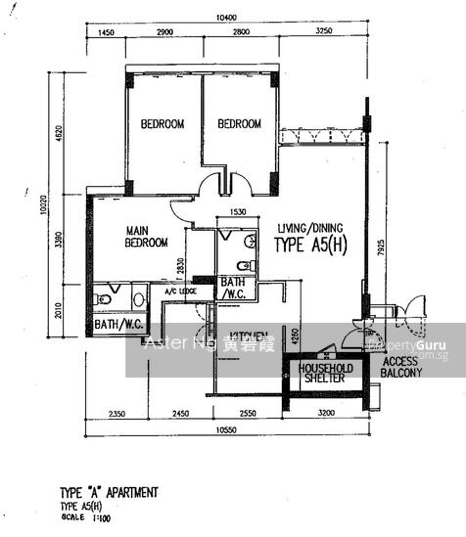
Layout and efficiency
- 94sqm in size – good for a 4-room flat
- Lacks a service yard
- But good sized living and dining area
- A short hallway makes it more efficient
- Decent sized bedrooms
- The kitchen can be set up as an open or closed one
- The lack of structural walls between bedrooms allows for more flexible configurations
- Protrusion of the bedroom past the living room windows does reduce visibility and sunlight coming in depending on the time of the day
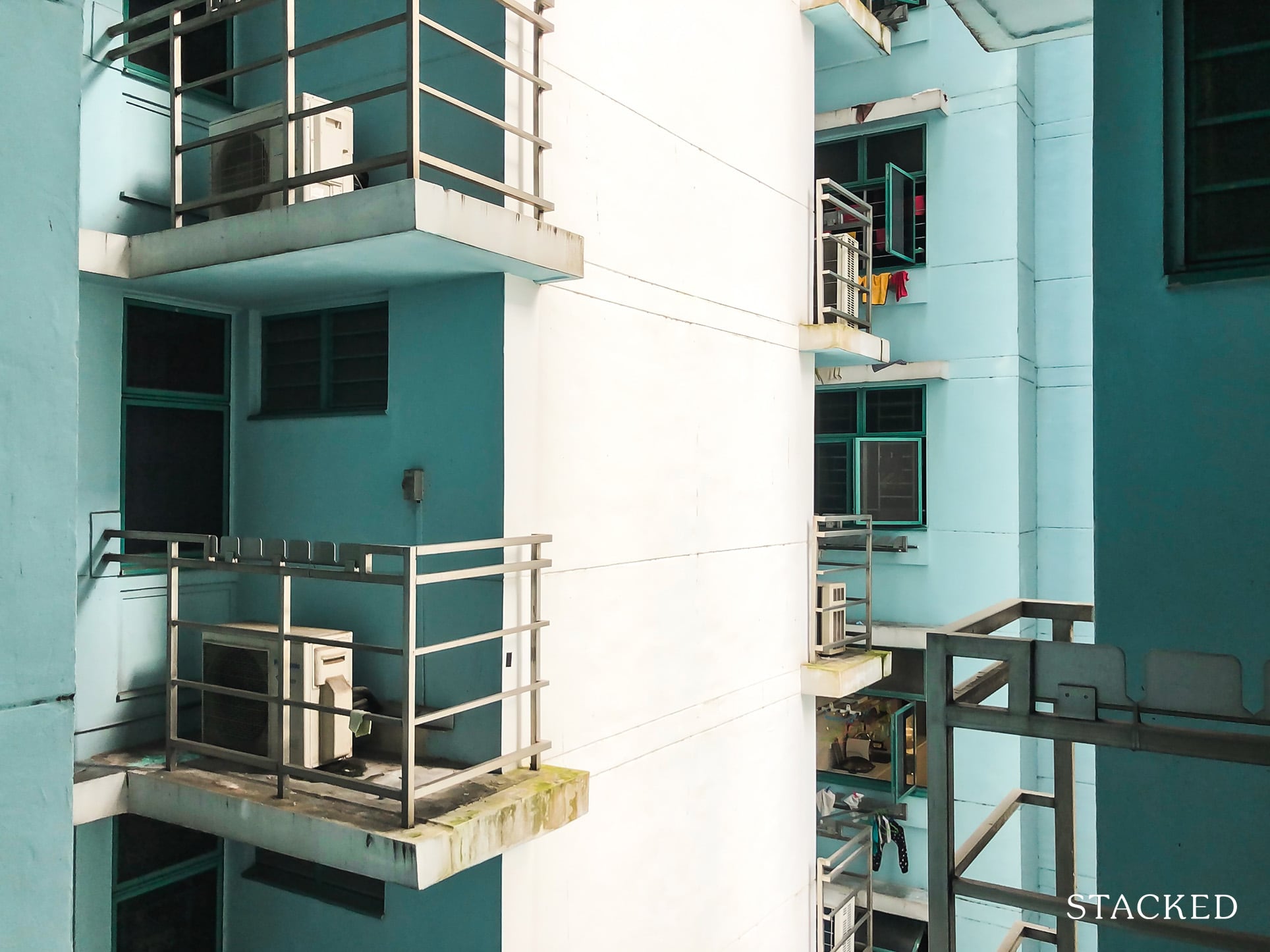
Sun analysis
See if there is afternoon sun (you can time your visit to check). The kitchen area needs more sun for laundry. In general, north-south facing units are the best due to the most amount of cross-ventilation throughout the year, and it has the least amount of direct sun. East facing may be suitable since the morning sun is not as bad as the afternoon sun, however, we know of residents who still complain of the heat in the morning.
Wind
Cross ventilation is an important consideration if you do not wish to rely on air-conditioning much. However, this is difficult to gauge since it’s not as certain as the sun’s movement. Check to see if the layout allows air movement from one end to another – best if it’s directly facing each other. In this instance, it’s possible for the air to move through the living room to outside the kitchen. You could also open up the windows to test the wind, though it’s hard to rely on this as it comes only at certain times.
Check the view and facing
Check the facing for all rooms – especially if they have windows. Bedroom facing is the most important, as these are the most private quarters. But do not neglect other rooms such as the kitchen or service yard. Service yards tend to be better if it faces a direction with more sun or wind. Check to see if the service yard also faces the common corridor or the opposite neighbour’s flat as it could get uncomfortable while having your laundry.
This unit in particular faces the inner part of development, which is not the best of course. The bedrooms and living room have the same view.
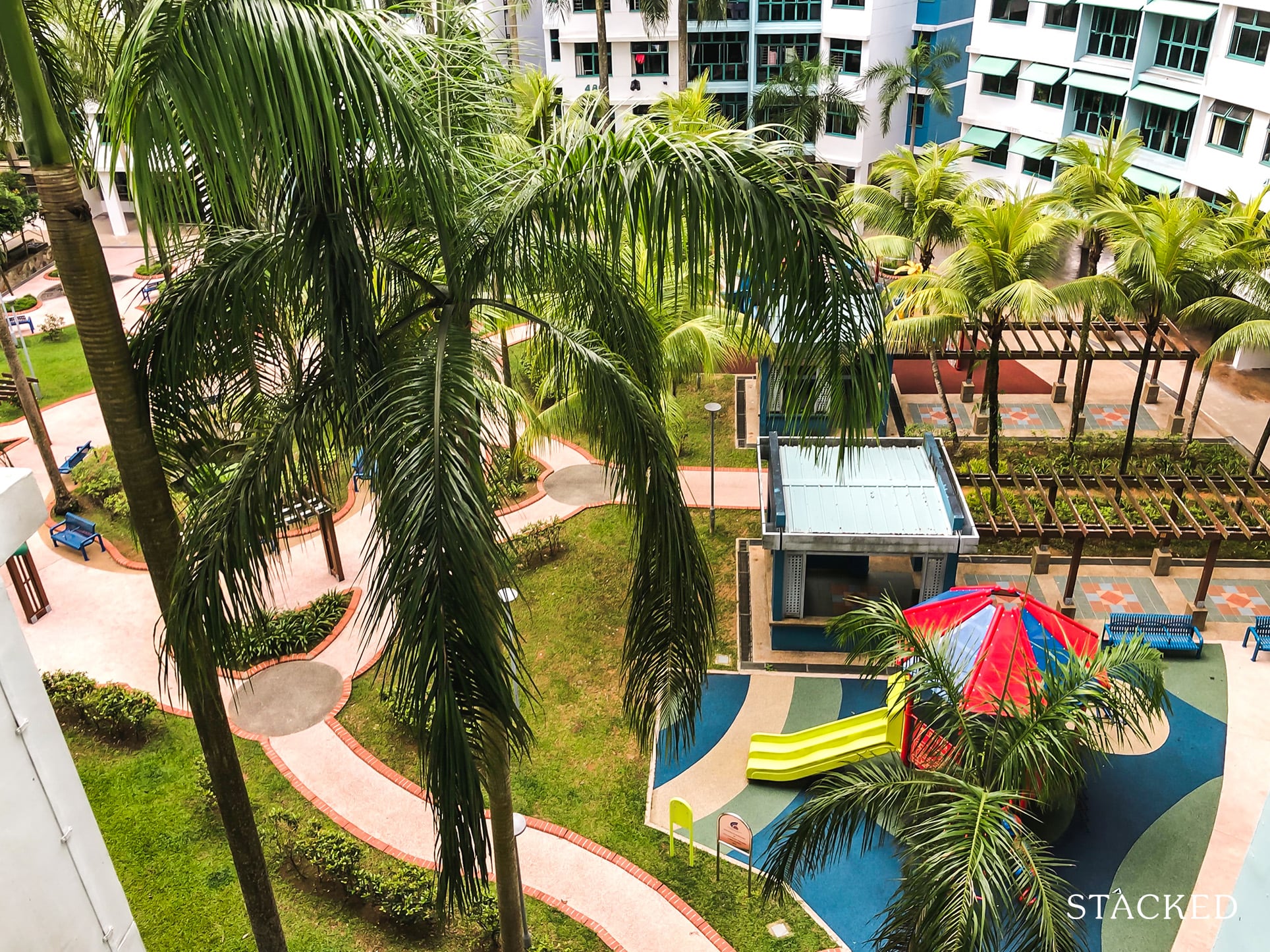
That said, it does have a nice park and playground view – so even when facing inside the development, there’s a world of a difference between facing greenery or the multi-storey carpark. Many flats that face the carpark have difficulty being sold as the carpark tends to have headlights shining into the home, tyre screeching and engine noise (this includes motorcycles and modified cars with their revving engines). By the way, this type of noise goes on late into the night too.
If the development has a commercial block, check that. you are not facing the loading/unloading bay. These could get really noisy during peak hours and many people congregate there to smoke too.
Check the master plan
Finally, even if you have a good facing now, you might want to take note of future developments across your unit in time to come. Is there the potential of a Chinese temple that would be set up that could result in some noise or burning smells coming through? Is there a plot opposite zoned for residential development that could block your view in time to come? Of course, it’s not much of an issue since this unit is inner-facing, but do pay attention to the plot opposite if you’re buying a unit that faces outside. You can find out more about reading the master plan here.
Distance to the opposite block
Look out the window to see if the distance between the unit and the opposite unit is a comfortable one. Generally, anything about 40-45 metres or more is quite okay. To estimate the distance, you can use the straight-line measure tool on URA’s Map site. It’s not perfect, but it’s good enough.
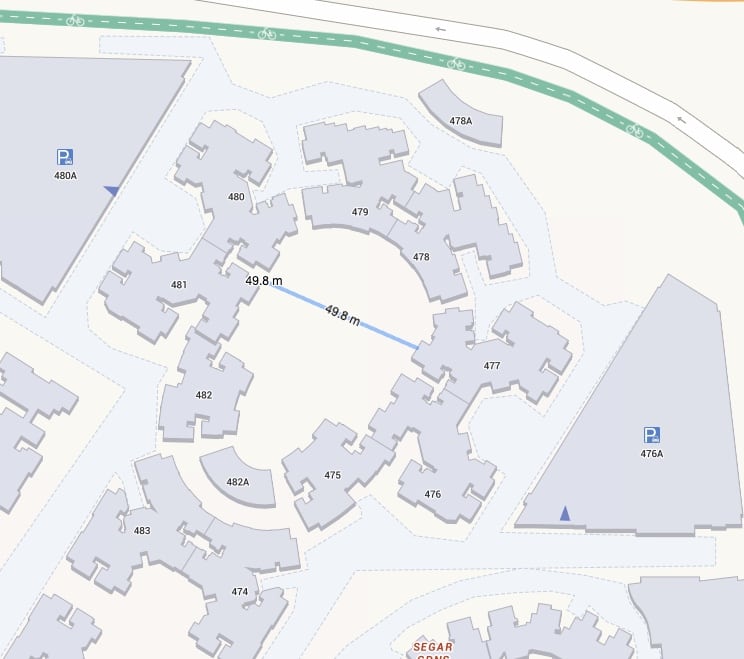
Above all, nothing beats going down to visit in person.
Property always comes with a certain “vibe”, a feeling that a place is right for you. You may not even be able to put words to the reason sometimes. Perhaps it’s nostalgia, and a resemblance to the place you grew up in; or perhaps your instincts tell you that you’re in a community where you fit in.
This is just as important as the more fundamental aspects, such as how far the school or train station is. Next up, I’ll touch on the next part of the viewing – in the unit itself so keep a look out for that.
For more direct help, you can also contact us at Stacked, and follow us for news and updates on various HDB as well as private developments in the Singapore property market.
If you’d like to get in touch for a more in-depth consultation, you can do so here.
Have a real estate question, or not sure what your options are? Email us at stories@stackedhomes.com.
Sean Goh
Sean has a writing experience of 3 years and is currently with Stacked Homes focused on general property research, helping to pen articles focused on condos. In his free time, he enjoys photography and coffee tasting.Read next from Property Advice

Property Advice Should We Buy An Old 99-Year Leasehold Condo To Live In: Will It’s Value Fall When The Lease Runs Out?

Property Advice We Own A $800K 1-Bedder And A $1.1M 3-Bedder: Is It Possible To Upgrade To A 4-Bedder Condo?

Property Advice I Own A 55-Year-Old HDB Flat, But May Have To Sell — Can I Realistically Buy A Freehold Condo With $700K?

Property Advice We Own A 2-Bedder Condo In Clementi: Should We Decouple To Buy A Resale 3 Bedder Or Sell?
Latest Posts

Singapore Property News This HDB Just Crossed $1.3M For The First Time — In An Unexpected Area

Singapore Property News “I Never Thought I’d Be Sued by a Tenant.” What Long-Time Landlords in Singapore Miss

Property Market Commentary I Lived In Bayshore When It Was ‘Ulu’. Here’s How Much It Has Changed

Singapore Property News HDB Resale Prices Finally Slowed in 2025 — Will It Continue in 2026?

Singapore Property News Breaking News: District 23 Condo Sells Out In Under Two Years At $2,120 Psf Average

On The Market Here Are The Cheapest 3-Bedroom Condos in Central Singapore You Can Still Buy From $1.15M

Property Market Commentary Why The Singapore Property Market Will Be Different In 2026 — And It’s Not Just About Prices

Editor's Pick 2025 Year-End Review Of The Singapore Property Market: What The Numbers Reveal

Pro This 21-Year-Old Condo Didn’t Sell Out Initially, Yet Became A Top Performer

Editor's Pick How The HDB Resale Market Performed In 2025, And What It Means For 2026 Prices

Editor's Pick 4 Key Trends Reshaping Singapore’s New Launch Condo Market In 2026

Editor's Pick What I Only Learned After My First Year Of Homeownership In Singapore

Singapore Property News Why More Land Doesn’t Automatically Fix Housing In Singapore

On The Market Here Are The Cheapest 4-Room HDB Flats in Central Singapore You Can Still Buy From $490K

Pro How A Once “Ulu” Condo Launched In 1997 Became A Top Performer



